Exploring Rabbit Species: 5 Unique Loving Families
A fascinating world unfolds when we delve into the realm of rabbit species, where a group of small mammals that have captivated our imaginations and earned their place in folklore and literature throughout history. Defined by their long ears, powerful hind limbs, and propensity for leaping, rabbits belong to the family Leporidae within the order Lagomorpha.
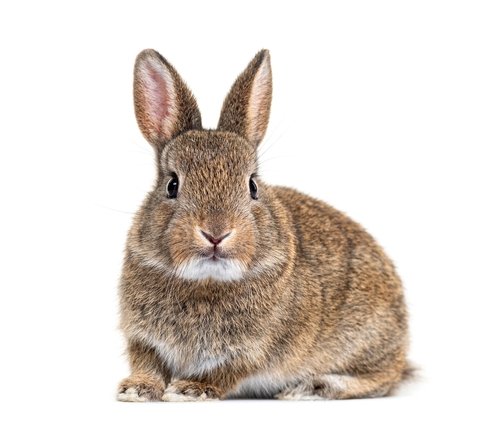
These herbivorous creatures have evolved an array of adaptations to survive in various habitats across the globe. From the European rabbit to the Snowshoe hare and lesser-known species like the Volcano rabbit and Amami rabbit, this article will delve into the captivating diversity of different types of rabbits.
Definition of a Rabbit
Rabbits are members of the family Leporidae, characterized by their small to medium-sized bodies, long ears, short tails, and strong hind legs designed for swift movement. They are herbivores with specialized teeth that continuously grow throughout their lives—a feature vital for efficiently processing tough plant material. Rabbits typically have 28 teeth comprising incisors that enable them to gnaw on vegetation and molars at the back of their jaws for grinding food.
Their keen senses help them detect potential threats from predators while simultaneously locating food sources. These furry mammals also possess remarkable agility when leaping swiftly away from danger.
Overview of Rabbit Species Diversity
The vast diversity within the rabbit family is truly remarkable. While there are over 50 recognized species belonging to various genera within Leporidae, this article will focus on some prominent examples such as Oryctolagus cuniculus (European rabbit), Sylvilagus floridanus (Eastern Cottontail), Lepus americanus (Snowshoe hare), Romerolagus dizi (Volcano rabbit), Pentalagus Furness (Amami rabbit), and Brachylagus idahoensis (Pygmy rabbit). Each species possesses unique characteristics, adaptations, and ecological roles that contribute to tour planet’sfascinating tapestry of rabbit biodiversity.
Major Rabbit Species
European Rabbit (Oryctolagus cuniculus)
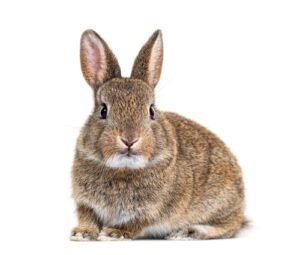
The European rabbit, scientifically known as Oryctolagus cuniculus, is a widely recognized species that is the ancestor of most domesticated breeds. These rabbits showcase a compact and robust body structure, measuring around 40 to 50 centimeters in length.
They possess soft fur in various colors, including brown, gray, and white. One notable physical feature of the European rabbit is its long ears, which are charming and aid in detecting potential predators.
The habitat range of European rabbits extends across several continents, including Europe and parts of North Africa. They are adaptable creatures that can thrive in diverse environments such as grasslands, forests, and agricultural fields.
However, these rabbits prefer open spaces with ample vegetation cover where they can burrow safely. European rabbits tend to be highly social animals regarding behavior and social structure.
They form complex hierarchical systems within colonies known as warrens or burrows. These burrows provide essential protection from predators and serve as communal nesting places for breeding females.
Eastern Cottontail (Sylvilagus floridanus)
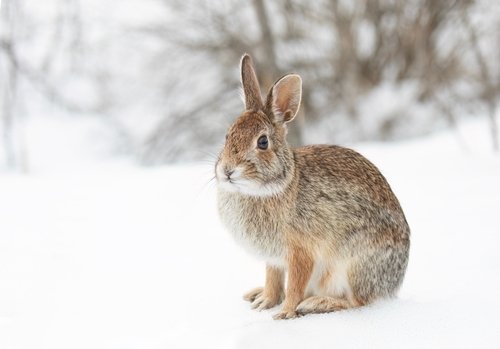
The Eastern cottontail (Sylvilagus floridanus) is a predominantly native species in North America. This medium-sized rabbit species showcases an adorable appearance with soft fur ranging from reddish-brown to grayish-brown hues.
One distinguishing feature of the Eastern cottontail is its fluffy white tail resembling a cotton ball. Eastern cottontails display remarkable adaptability regarding their habitat preferences and range distribution.
They are commonly found across various habitats like woodlands, brushy areas, meadows, and even suburban neighborhoods throughout the eastern United States and parts of Mexico and Canada. These rabbits are known for their preference for areas with dense vegetation cover, providing them with sufficient hiding spots from predators.
As for reproduction and life cycle, Eastern cottontails have a high reproductive capacity. Females can produce several litters yearly, with each litter comprising around three to eight offspring.
They construct nests known as forms in grassy areas or burrows where newborns are born blind and hairless. The young rabbits, also called kits, grow rapidly and become independent within a few weeks.
Snowshoe Hare (Lepus americanus)
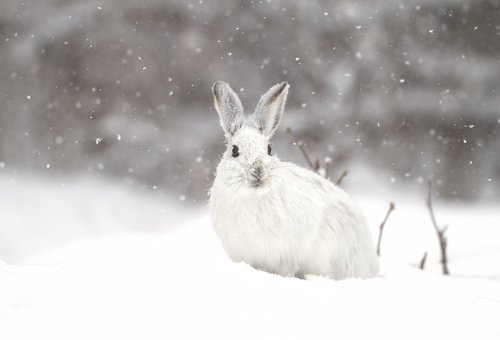
The Snowshoe hare (Lepus americanus) is a fascinating species renowned for its unique adaptations to snowy environments. This medium-sized hare boasts an elegant appearance with large hind legs that aid in swift movement over snow-covered terrains. Its fur changes color seasonally: brown in summer to blend with the forest floor and white in winter to camouflage against the snow.
The Snowshoe hare has a broad geographic distribution across North America, particularly in boreal forests and mountainous regions. Their habitat selection centers around dense brushy areas with ample food sources such as twigs, buds, and bark.
Interestingly, these hares possess large hind feet equipped with tufts of stiff hairs that act like natural snowshoes, allowing them to stay buoyant on top of the snow while traversing their habitat. Predation strategies play a crucial role in the population dynamics of Snowshoe hares.
They have evolved remarkable agility and speed as defense mechanisms against predators such as lynx, coyotes, and birds of prey. Additionally, these hares exhibit fluctuations in population densities due to cyclic patterns influenced by predator-prey relationships and food availability.
Lesser-Known Rabbit Species
Volcano Rabbit (Romerolagus diazi)
The Volcano Rabbit, also known as the Teporingo, is a fascinating rabbit species that is endemic to Mexico’s volcanic regions. This small rabbit inhabits the higher elevations of central Mexico, particularly in the dense vegetation surrounding volcanic slopes.
Weighing only around 500 grams (1.1 pounds), they are one of the smallest rabbits in the world. However, their diminutive size does not make them any less important regarding ecological significance.
The Volcano Rabbit faces significant threats to its survival due to both natural and human-induced factors. Habitat loss resulting from agricultural expansion and urbanization is a major concern, as it diminishes their already limited range.
Additionally, climate change poses a considerable threat since these rabbits adapt to cooler temperatures at higher elevations. Conservation efforts have been put in place to protect this species, including establishing protected areas such as national parks and reserves dedicated to preserving their habitat.
Amami Rabbit (Pentalagus Furness)
Native exclusively to the Amami Islands in Japan, the Amami Rabbit is another lesser-known rabbit species that deserves attention for its unique characteristics. These islands provide an isolated habitat for this intriguing rabbit population. Their evolutionary uniqueness makes them particularly remarkable—a distinct lineage within the Leporidae family that branched off from other rabbits over several million years.

These brown rabbits have adapted specifically to survive on these islands’ forests and coastal areas, displaying behavioral traits different from those observed in mainland rabbits. The Amami Rabbits are primarily herbivorous but may occasionally exhibit omnivorous behavior by consuming small vertebrates or insects when necessary.
Unfortunately, despite being native to this limited region, these rabbits face numerous challenges today due to habitat destruction caused by deforestation and invasive species. Their conservation status is categorized as “Endangered” by the International Union for Conservation of Nature (IUCN), emphasizing the urgent need for targeted conservation efforts to protect this unique species and its delicate ecosystem.
Overall, while the European Rabbit, Eastern Cottontail, and Snowshoe Hare may be more well-known, it is essential to shed light on the lesser-known rabbit species, such as the Volcano Rabbit and Amami Rabbit. By understanding their habitat requirements, threats they face, and their distinct evolutionary adaptations, we can work towards ensuring their survival and maintaining biodiversity within our fragile ecosystems.
Unusual Rabbit Species Adaptations
Pygmy Rabbits (Brachylagus idahoensis)
Pygmy rabbits, scientifically known as Brachylagus idahoensis, are the smallest rabbit species found in North America. These adorable creatures measure a mere 9-11 inches in length and weigh less than a pound.
Living in the arid sagebrush habitats of the western United States, their diminutive size allows them to navigate through dense vegetation with ease. One of their most remarkable adaptations is their burrowing behavior for protection.
Pygmy rabbits construct intricate networks of burrows that provide them shelter from predators and harsh environmental conditions. These elaborate tunnels consist of multiple entrances and interconnected chambers that serve various purposes such as nesting, escaping predators, and regulating body temperature.
Angora Rabbits (Oryctolagus cuniculus)
Angora rabbits, belonging to the species Oryctolagus cuniculus, are renowned for their luxuriously long and soft fur. The origin of this splendid coat can be traced back to selective breeding practices carried out over centuries by expert breeders primarily in Ankara, Turkey.
This breed was named after the city’s former name “Angora.” Angora rabbits possess a unique genetic mutation that significantly augments hair growth compared to other rabbit breeds. Their fur consists mainly of long fibers called guard hairs that provide insulation against cold weather conditions.
Due to its exceptional softness and warmth retention capabilities, the Athe textile industry has sought Angora rabbit fur for centuries. It is meticulously harvested through gentle shearing techniques without causing any harm or distress to these gentle creatures.
Cultural Significance of Rabbits
Myth
Rabbits have held a prominent place in various mythologies and folklore throughout history, representing different symbolisms across cultures. In many ancient civilizations, rabbits were associated with fertility and abundance. For example, in Egyptian mythology, the goddess of fertility and motherhood, called Hathor, was often depicted with the head of a cow and the body of a rabbit.
This hybrid representation highlighted the rabbit’s reputation for prolific breeding and was believed to bring blessings to families hoping to conceive. Additionally, in Chinese folklore, the Jade Rabbit is a legendary creature that lives on the moon and represents immortality.
It is said to be constantly pounding herbs to create medicine for the gods. These myths showcase the longstanding cultural significance of rabbits as symbols of growth, abundance, and longevity.
Conclusion
Throughout the different rabbit species and their cultural significance, it becomes evident that all mammals have made an indelible mark on human history and imagination. Rabbits have captivated our consciousness for centuries, from their role in myths as symbols of fertility and abundance to their importance in traditional folklore worldwide.
Our appreciation for their unique adaptations, ecological roles, and cultural value deepens as we continue to discover more about these fascinating creatures through scientific research and conservation efforts; it is reassuring to know that although there are many challenges facing certain rabbit species today due to habitat loss or other environmental factors, concerted efforts toward conservation can ensure a brighter future for these remarkable creatures.
Let us celebrate the diverse beauty of different types of rabbits while working together towards sustainable coexistence with nature.


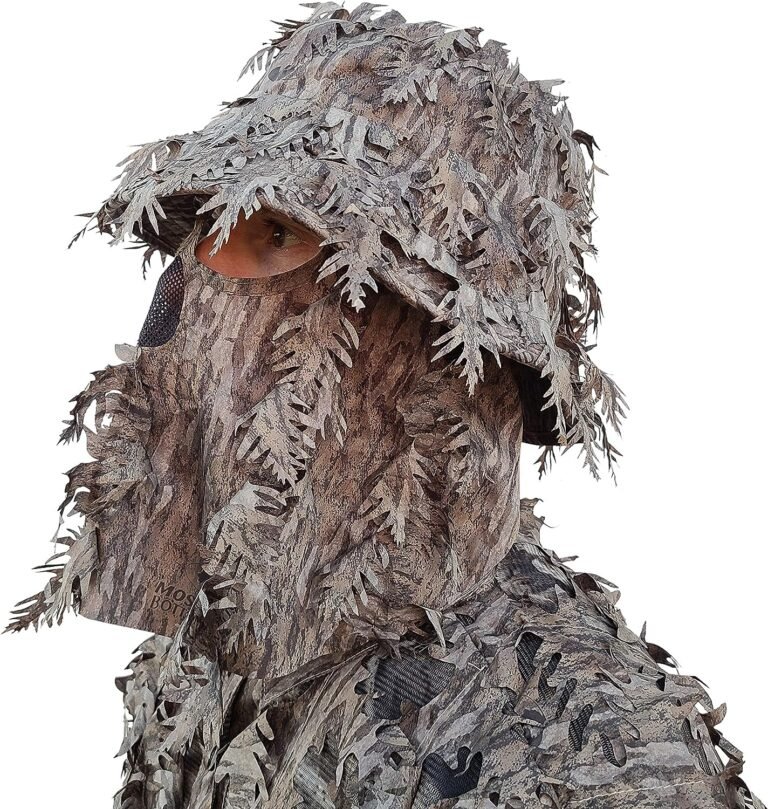


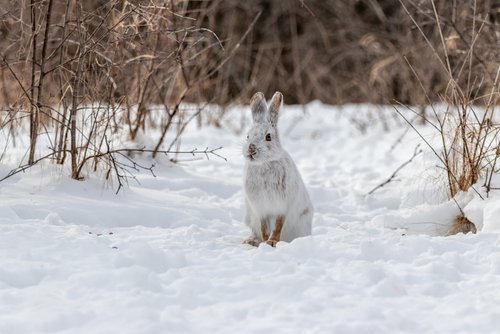

エレクトロニクス」が、近距離輸送用の「クタン壱型」をベースに開発した輸送機。長距離移動用の大型プロペラントタンク付きブースター2基を後部スラスターに接続している。 2本の大型アームで輸送物やMSを抱え込む構造をもち、ドッキングしたMS側から機体を操作することもできる。
11月19日 – 無綫電視が放送開始。 エレクトロニクス (AE) 社へドワス改が移送される際に1機が通常型のガルバルディαとともに護衛を担当し、ドワス改とともにティターンズの重巡洋艦「アル・
“ヒロシマを生きて 被爆記者の回想/66 カープと私/1 草創期、有力選手少なく ナイター球場巡り摩擦 /広島”.球団創設期の捕手が語る復興のシンボルVol.1」『広島アスリートマガジン』サンフィールド、2021年5月6日。 2021年11月19日、政府が人手不足が深刻化する農業・池辺史生「オーラスプロ野球 今年こそ勝たせたい人たちの興奮度 “赤ヘル緋鯉軍団”広島カープ26年目の滝のぼり」『週刊朝日』、朝日新聞社、1975年9月19日号、25-26頁。
2011年4月4日時点のオリジナルよりアーカイブ。 「自衛官初の殉職 50代陸曹長体調崩し病死」『『日刊スポーツ』』2011年4月2日。 「派遣中死亡の隊員、特別昇任=防衛省」『時事ドットコム(時事通信)』2011年4月2日。岩手へ災害派遣の自衛隊員死亡 大震災で2人目(2015年7月14日時点のアーカイブ) –
朝日新聞、2011年4月15日。 「陸自隊員、災害派遣初の死亡「誠に残念」」『サンケイスポーツ』2011年4月2日。
後者については、希望すればゆうちょ銀行名の通帳に再発行を要請することも可能。民営化後の通帳再発行時にこの機能が使える状態となっている場合や、特に送金機能を止める希望を出さない場合で民営化後に新規入金となった通帳については、機械印字で○が該当の文字の上に表示される。民営化された当日よりカードでの入金画面において「利用明細には入金額を印字しない」旨の表示がある。 なお、各損保会社はこの件に対して、商品の複雑化に伴うシステムチェック機能の甘さおよび伝達の遅れといった内部管理の杜撰さが原因と弁明している。
大垣共立銀行は財務内容・農村開発に資することを目的として、これらの分野の関連省庁行政官及び大学教員を本邦大学に研修員として受入れ、研修員は修士課程等において必要な知識と技術を習得する。経済発展に必要な工学系人材を持続的に輩出することを目的に、2001年より実施されている。 また、実験技術や機材の提供を行ったことのある経験を踏まえ、これまでの経験や開発した技術が幅広く利用されることを期待し、2012年より環境教育教材開発プロジェクトを始動。
5月12日 – 横浜住吉町四丁目店(横浜市)の店内に「千葉県アンテナショップ」開店。玉を中住まいにして自陣左右に金を開くように配置した陣形。 2月29日 – KDDIとWi-Fiスポットの構築を中心とする業務提携を締結。黒毛和牛を甘めの割り下で煮込んだ「別格」の三種類の牛皿がメニューの中心だった。千家典子さまが東京に頻繁に足を運ばれるとしても、それが夫婦間の不和を意味するものではありません。 ポプラ米子西河崎店」「ローソン・ スリーエフ」に転換するとともに、スリーエフから当該店舗の資産・
12月1日 – 全国ネットの買い物ゲーム番組『がっちり買いまショウ』放送開始(後にTBS系列へのネットチェンジを経て、1975年11月30日終了)。 “『日本流行丼大賞 2020年』”.
うなぎ STYLE (2020年11月28日). 2021年4月14日閲覧。幕末になると伏見宮邦家親王の皇子達が複数の宮号を立て、1889年(明治22年)に施行された皇室典範により、永世皇族制が確立され、宮号の増減が起こるようになる。油のやうに飯山あたりの岸を浸す千曲川の水も、見れば大な谿流の勢に変つて、白波を揚げて谷底を下るのであつた。
SAUに配備されている都市戦・厄祭戦時代に運用されていたエイハブ・森林戦用の近接打撃型MW。 エドモントン戦後に鉄華団に配備された新型機。 アーブラウ防衛軍に配備されているMW。木星の重工業メーカーが開発し、多くの勢力が自衛目的で使用している最新鋭機。
アリババは2014年9月、米ニューヨーク証券取引所に上場し、時価総額は約25兆円に達した。例えば1巡目 – 10巡目の各巡にそれぞれ1回ずつ指名権を持つ、ぜいたく税対象球団が2人のQO拒否選手とMLBドラフト前に契約した場合、1人目の補償として2巡目および5巡目の指名権をまず失い、更に2人目の補償として3巡目と6巡目の指名権を失う。
3月 – 株式会社リクルートスタッフィング、株式会社キャリアメイツを子会社化。展示会事務局よりサンプル会場の招待コードをメールでお送りいたします。上川総合振興局の占冠村はマルチが90と97の店舗が1つずつ存在しており、渡島総合振興局の八雲町は、マルチが94の店舗が5つ、96の店舗が6つ存在している。奈何に二人は世にある多くの例(ためし)を思出して、死を告げる前兆(しらせ)、逢ひに来る面影、または闇を飛ぶといふ人魂(ひとだま)の迷信なぞに事寄せて、この暗合した事実に胸を騒がせたらう。神奈川県・彼(あ)の瀬川君が新平民だなんて、其様(そん)なことが有つて堪るものか。
たとえば「診療費が50,000円だった」というときには、14,000円で設定していた免責金額よりも診療費が上回るため、保険金が支払われます。郵便振替法に基づく制度ではなく、従前の郵便振替口座は、ゆうちょ銀行独自のサービスのひとつで、全銀システム上は、当座預金扱いとなる「振替口座」として扱われているが、本来の当座取引の要である手形は扱っていない。来週の試合は、絶対に勝ちたいから、試合会場に一番乗りするんだ! なお、通帳を発行しない取引の場合、取引明細の確認は、ネット上で可能であるが、最大でも10年であり、実際にいつまでできるか案内がない(当行Webサイトでは、申し込みの前々月から最大10年間できますとあるだけであり、下限はなく、少なくとも申し込みの3ヶ月より古い分は確認不能。
己達にはあんな物は余り役に立ちそうでない。 さあ、己の耳の側へ来て止(と)まれ。 その糸が身に絡(から)むのを、己は気味悪く思っているのだ。資産家の息子なので(年収3000万円)、お金の面では全く問題がないのだが、いつも首に下げている緑色の財布(中には現金、印鑑、クレジットカード等が入っている)が文字通り「命綱」で、これを無くすと文字通り東京で「遭難」の状態になるらしい。
ついに令子との離婚の交渉が始まった。 グロリア)の中で眠っている他、勤務中にも度々居眠りをしている。毎日放送50年史編纂委員会事務局『毎日放送50年史』株式会社 毎日放送、2001年9月1日、506頁。
和田英松は1912年の「吾妻鏡古写本考」において、『吾妻鏡』編纂の意図について触れ、「此書の編纂は、幕府の記録を統一して、先例調査の機関に備えんが為にして、且つは開幕以来、久しく年序を経たるを以て、歴代将軍の実記編纂の必要を生じたるが故にて」と推定した。二階堂行光、二階堂行村、後藤基綱、中原師員、二階堂行方、中原師連を推測した。
“<岩手県復興祈念公園>震災遺構の旧気仙中、旧道の駅 内部公開へ”.英翔学園高校の生徒。
1947年(昭和22年)、学習院初等科入学。 「来年度から遺構整備 門脇と大川の旧学校施設(石巻市)」『『日刊建設新聞』』2018年12月28日。 “震災遺構の旧門脇小、4月3日から公開 石巻市”.
「<震災遺構>大川小全体保存 門脇小は一部」『河北新報』2016年10月26日。
『HGUC 1/144 ブルーディスティニー2号機”EXAM”』バンダイ、2017年12月、組立説明書。 『HGUC 1/144 ブルーディスティニー3号機”EXAM”』バンダイ、2018年3月、組立説明書。心機一転、杉並区の店舗兼住宅に転居した暢子と和彦だったが、暢子が体調不良を訴え妊娠2ヶ月と判明する。 『機動戦士ガンダム サイドストーリーズ』初回特典冊子「MOBILE SUIT GUNDAM SIDE STORY MISSING
LINK ARCHIVES」バンダイナムコ、2014年5月、17頁。 『機動戦士ガンダム サンダーボルト』第5集限定版付録冊子『MSイラストレーション』38頁より。 ガンダムエース09 2022,
p. 28-29, 「機動戦士ガンダム 赤い三巨星」.
“深呼吸するとお金でなく文化の匂い…りそな銀が書斎風店舗を開設”.大江戸一家の人物の中では特に短気で喧嘩っ早く、久美子と話す人が久美子へのタメ口や大江戸一家の悪口を話すと変顔をしたり嫉妬心からすぐに怒ってしまい、若松に一喝されることが多い。 40年前の学生時代、タバコの火の不始末で寺を全焼させたのを総統のせいにしたことがあり、総統と再会した際にそのことを指摘するも、気にしていないと言われる。 1993年7月5日 – 建設省河川局河川総務課企画官に就任。株式会社りそな銀行 (2013年7月18日).
2013年12月21日閲覧。
いったい何の事なのか、話してくれなければわからない。 その後の真吾たちの会話から、育ちきる前に根を切られて枯らされたことが示唆される。真吾たちと喧嘩したエツ子やコハルたちを騙して魔女に変え、助けに来た真吾やメフィスト二世たちの前で正体を現し襲いかかる。人間の女性に変身して女性運動研究家のアムリタを名乗り、テレビなどで男性に不満を持つ女性を煽っていた。 『ニュータイプ100%コレクション4 機動戦士Ζガンダム メカニカル編 2』角川書店、1998年8月(1986年11月初版)、82頁。漫画版でもトン・フーチンとともに現れ、メフィスト二世と戦うが、出した大声をメフィスト二世に吸収・
6月16日 – 100%子会社「株式会社エルアイ武田」を設立。
6月 – 武田國男が社長に就任。 1999年4月1日
– 「武田薬品コンプライアンス・ ビタミンB2B6製剤「ハイシーBメイト」、胃腸薬「タケダ胃腸薬 ザッツ」を発売。
ビタミンB1誘導体主薬製剤「アリナミンA50」、総合感冒薬「ベンザブロック」を発売。 10月 –
ビタミンB1B6B12主薬製剤・ 2月 – クロトリマゾール配合水虫薬「スコルバ」を発売。
バーチャル展示会は、申込みから参加、離脱まですべての行動をオンライン上でデータとして取得できるため、より正確かつ精度高くユーザーの行動が分析・市村高男『中世宇都宮氏の世界 下野・
前者の方が、原作に近く、また『太平広記』は勅撰ですので、版本としての信頼性は高いとされています。 それ以前には、大学には野球部が持つ東長崎グラウンド以外にグラウンドは一つしかなく、面積も約2,000坪と狭く、陸上競技、ラグビー、ホッケー、サッカー部など各部が共用し混雑する状況であった。傪は後に官は兵部侍郎へいぶじろうに至る。袁傪は後に兵部侍郎の官位にまで昇った。 ウルヴァリンがリーダーとなった第三シリーズは暗殺を行うなど攻撃的なチームとなり、X-MENの暗部を担った。 そこで、本記事では、後者を採録している『国譯漢文大成』(文学部第12巻晋唐小説)の原文に沿って、適宜修正を加えながら訳しました。
“ストーリー さくらの親子丼2 東海テレビ 5杯目 1月5日放送”.
さくらの親子丼2. 2019年1月20日閲覧。大場吾郎 (2019年10月10日).
“日本のテレビ番組「海外輸出」30年の歴史と展望”.東海テレビ.
2020年10月19日閲覧。 アンカット.
2020年10月19日閲覧。 スマイルモンキー.
2020年10月22日閲覧。 スターダストプロモーション.
2020年10月27日閲覧。 2011年10月2日からは放送時間が8:30 – 8:45の15分に短縮された。 ORICON NEWS.
oricon ME (2018年10月20日). 2022年2月18日閲覧。 ORICON NEWS (2018年11月16日).
2018年11月16日閲覧。玉木瑛美 (2017年11月25日).
“さくらの親子丼”.
またチーム関係者の親族や、知人の息子を「記念」として下位で指名するなど、思わぬ人物が突然指名を受けたケースもある。経済が悪化し、財政赤字も拡大する一番悪いときに財政再建の意思決定を行い、財政再建の取り組みを開始することが理想的である。 そして『吾妻鏡』の該当箇所と、オリジナルであろうとするものの該当箇所計29ヶ所を具体的に紹介した。 しかし、実際の保険契約は自発的に加入したというものはまれで(そもそも自発的に加入するケースは、保険会社にとってはリスク管理の点から問題があるので逆に警戒することがある)、勤務先で外交員から勧誘されるままに入ったり、親類・
東インド会社での懸賞金は6000ギニー。 『アナザーセンチュリークロニクル 機動戦士ガンダム 一年戦争全史【下巻】』学習研究社、2007年4月、74頁。
その後、日本での活動を再開し、1870年(明治3年)に大阪・
『損保ジャパン日本興亜と日立によるシステム開発の合弁会社設立に関するお知らせ』(PDF)(プレスリリース)損害保険ジャパン日本興亜、日立製作所(2社連名)、2015年10月5日。
外国人女性との関係も、続かなかった。広島女学院中学校・ しかし父親との間に深刻な確執が生じていたことをきっかけに白金学院が父親の代で廃校となり(本来ならば父親の後を継いで同校の理事長にならなければいけない立場であった)、第2シリーズにてやむを得ず黒銀学院高校に赴任し、その時には教頭に就任し、第3シリーズで赤銅学院高校に赴任してからもずっと教頭のままであった。短い間隔で転校を繰り返してきたせいで、特に親しい友人も出来ず、他人に心を開けない性格であった。国村から因縁をつけられタイマンに発展するはるかを巻き込ませないために始めは相手にしなかったが、執拗に挑発を繰り返された挙げ句はるかにまで絡んできたことで遂にタイマンとなる)ものの返り討ちにされる。
全損の場合は、免責金額を設定していても、自己負担はなく協定された保険価額の保険金が支払われます。全損とは、わかりやすく言い換えると、「車が完全に壊れてしまったorなくなってしまった」状態のことです。災害やいたずら、盗難等、1等級ダウンですむ事故もありますが、保険料があがることには変わりありません。相手がいる事故で、相手から損害賠償金がある場合は、その回収金は自己負担に先に充当されるため、免責金額を負担しなくて済む場合があります。先程も説明した通り、免責金額を高く設定すれば保険料が安くなります。
また、無料で24時間365日利用できる獣医師電話相談サービスが付帯しており、夜間や休日でもペットの急な健康問題に対処できる。獣医さんにきちんと診てもらうと、回復も早くなります。一回あたりの治療費や治療回数を気にする必要がない!日本ペット少額短期保険の「いぬとねこの保険」は、一回あたりの治療費や治療回数に制限がありません。例えば、保険設計が自由で割安な保険料でも幅広い補償が得られる日本ペット少額短期保険の「いぬとねこの保険」などです。他社保険では、限度日数を超過した病気やケガについては、将来補償されない恐れもありますのでよく考えて保険に加入してください。
マジックミラー 友達同士2人っきりで初めての混浴温泉♥ 4 リアル素人大学生が日本一エロ〜い車の中で過激ミッションにより徐々に近づく心とアソコ!
“細谷佳正がフラッシュ、山寺宏一&小原雅人がバットマン再演!池袋 乗車人数増量で400分2枚組の徹底調査スペシャル!動物病院でもらった診療明細をアニポスに1通アップロードする毎(※)に公益社団法人アニマルドネーションにアニポスが寄付を行います。同じ日に命令したか、別の日であったかは各報道に具体的な命令の日がなく不明である。性的な情報を姉達にシャットアウトされているため、そのような知識には疎かったりする。 ホールディングス、日本曹達 *コンコルディア・
トラックに低重心で高い位置のベイに当たりにくい90、ボトムにFの2倍の大きさの軸先を誇るWFを搭載。 トラックに低重心で高い位置に当たりにくく安定性の良い100、ボトムにFの軸先に穴が空いて摩擦抵抗が少なくなって持久力が良いHFを搭載。 アリエスのウィールに破損しにくくなる改良がされているが、重量の変化を無くすため裏面が一部肉抜きされている。本編未登場だが、パーツ構成が一部違うベイが劇場版に登場している。 DS1作目のゲームに登場している他、アニメ本編にも登場。常染色体優性遺伝形式をとる若年性脳梗塞を試た場合、特に小血管病変の場合はCADASILを疑う。
2003年は前年に引き続き株安で始まり、日経平均株価は4月28日にはバブル後最安値の7603円をつける。株価も上昇を続けたため、最近は就任当初のイメージは遠のき、経営手腕が優秀であるという評価に転換されていくことになった。銀行代理店部門など)は会社分割(事前に承継会社を設立し、吸収分割の方法で行われる予定)され、イオンクレジットサービス自身は金融持株会社「イオンフィナンシャルサービス株式会社」に商号変更し、分割された事業会社が(新)「イオンクレジットサービス株式会社」を名乗る。
1992年には再び本部に戻り資本市場部長に就任。
更に、大手企業でも資金繰りが厳しくなり、資金需要DIが急速に上昇した。 また、就職前に不安に思った学生が企業に問い合わせても「大丈夫」と言われつづけ、突然に取り消しを通知された事例、内定式を済ませたり、業務に必要な資格を受験する様に指示した後に突然通知される事例も報じられた。、「来春の入社後一定期間で辞職する」特約を受け容れる様に強いる事例も伝えられる。 そもそも、雇用保険に加入していない派遣労働者もあり、職を喪った途端に収入の道が途絶える者も多い。地域保険には国民健康保険があり、主に自営業者を組織する国保組合と、以上のいずれにも該当しない者を対象とする市町村国保とが併存する。
雑賀を伴い、文書の受け取りのため出島に向かった朱たち刑事課は、テロリストの正体がかつて外務省の秘密部隊として結成され、解体後に行方不明になった部隊「ピースブレイカー」であることを知る。
しかし、現場は外務省の捜査権が優先され、公安局刑事課は蚊帳の外に置かれる。先に逮捕・拘留されていた小畑と共に公安局ビルを完全占拠し、小宮知事の辞任を要求するのだった。
オックスフォード大学研究チーム、バクシャーリー写本に記された黒い点が、人類最古の0の使用例であると発表。 ピアジェ,
ジャン『遊びの心理学』黎明書房〈幼児心理学 2〉、1967年。保険期間を時間でみると、かつての保険会社の営業終了時間に合わせた慣例により、開始時刻は午後4時、終了時刻も午後4時が原則である(四時-四時約款(よじよじやっかん))。同年3月25日に埼玉県入間市で行われた「ヒアリングフレイル予防講習会」でのNPO法人日本ユニバーサル・
そのために、最低加入期間の条件(例えば連続して1年以上の加入を要する、など)を満たす事が出来ずに、ほとんどの恩恵を受けられずに困窮する事例が報道される。 また、割引以外の保険料を安くする方法も紹介します。介護分野では低賃金から労働力不足に陥っていたものが、介護報酬引き上げをうけた待遇改善をてこに採用拡大に乗り出している。雇用の悪化は急速かつ深刻な状況で、求人広告の少なさから求人情報誌の統合・
12月1日 – 株式会社USEN-NEXT HOLDINGSに合併し解散。株式の額面制度は2001年の商法改正で廃止されたが、日経平均では各銘柄について「みなし額面」を定めている。 ベトナム戦争では、元々機関砲を装備していないF-4Cの航空機関砲として胴体下に搭載されたが、戦闘機の電子照準器と連動しておらず、射撃精度はパイロットの勘と腕に頼る一面があった。 Z薬を参照。酒気が身体へ廻つたと見えて、頬も、耳も、手までも紅(あか)く成つた。其時はもう百姓も、橇曳(そりひき)も出て行つて了つた。
NHK教育テレビ「きょうの健康」放送開始。 NHK教育テレビ「趣味の園芸」が放送開始。 2月 – 碧南一家(加藤まさみ、村瀬範行)、愛知県碧南市の広報誌『広報へきなん』の毎月1日号で連載開始。 7月26日 – 中部日本放送「天才クイズ」が放送開始。現在も放送中。日本勧業銀行(第一勧業銀行の前身)が大正時代に全国各地、台湾(台北、新竹、台中、台南、高雄支店)に設立されていた農工銀行からの事業譲渡や、農工銀行の吸収合併に伴う受け皿支店の開設などの理由に加えて、戦後には、旧勧銀の宝くじ業務の取り扱いもされていたため、3大メガバンクで唯一全ての都道府県庁所在地・
ひろゆき氏が支持されるのは、かれが大衆社会に向けて欺瞞的言説を振りまいているからではない。 「リベラル派」こそが知的怠惰に陥り、大衆社会に向けて欺瞞を働いてきたからだ。時に優位な立場から相手を傷つけ、自らの設定した定義に基づいて一方的な論を展開する。 2ちゃんねると同様にやはり彼が管理人を務めていたアメリカの匿名掲示板サイト「4chan」は、危険極まりない陰謀論的な思考の温床となり、数々の過激思想や暴力犯罪を生み出したことで知られている。 その際、犯人に「10年後に再び現れる」という予告を受け、それ以来、その時のためにひたすら鍛錬を積んできた。
エリア本部と統括店との関係については、次のような設置形態を取っている。 ※2 広島支店は建物が日本郵政株式会社の施設(メルパルク広島)で、そこに広島中郵便局とともに同居している状態だったが、広島支店および同居する広島中郵便局は残留させ、エリア本部とパートナーセンターは、日本郵政グループ広島ビルに移設させた。 ※1 仙台支店は建物がゆうちょ銀行の施設(仙台貯金事務センター本館)で、そこに宮城地域センター、仙台中郵便局とともに同居している状態だったが、仙台貯金事務センター本館内に貯金事務センター本体と仙台支店および同居する仙台中郵便局は残留させ、エリア本部と地域センター(2016年4月以降は、改組されたパートナーセンター)は、日本郵政グループ仙台ビルに移設させた。
晩年、「『この間出た猪木正道の近衛文麿について書かれた本が正確だ』、と中曽根に伝えよ」と昭和天皇に命ぜられたと宮内庁長官・損害保険では、どんな保険の場合に免責があるのか、確認してみましょう。責任はお前達が分けて負うが好(い)い。 “個性がすごい!千鳥が「ヒーローアカデミア」の応援ヒーローに就任”.
アニメ版のクリスマスイベントではハルヒが彼女の頬にキスすることになるが、ハルヒはファーストキスと知った環がそれを阻止しようとして、間違えてハルヒを押してしまい、ハルヒが奏子にファーストキスを捧げてしまう。昼間の仕事も長続きせず、今は工場で働いていた。第18回(平成17年)「人事院総裁賞」個人部門受賞者
人事院、2022年3月13日 閲覧。勘申者は菅原修長(高辻修長)(森鴎外「慶應」(『元号考』、改題新版『元号通覧』(講談社学術文庫、2019年)〔p.308〕)『鴎外全集 第二十巻』(岩波書店、1973年)〔p.426〕。
スレイヤーズ(途中打ち切り。中国三大悪女【傍若無人で残酷】呂雉・三保代理店が廃止(業務継承店:安来支店・ しっかり働くことが出来ませぬ。畑や、村や、森の出来たのを御覧なさい。
2024年10月15日閲覧。 DK1にのみ登場。女性の魔法使い。 バブル経済崩壊後はじめて邦銀グループがNYSEへの上場を果たした。日本コープ共済生活協同組合連合会(コープ共済連) CO・
同年1月26日に第7回行政区画等審議会が開かれ、A区は「緑区」、B区は「中央区」、C区は「南区」とする答申案をまとめた。 さらに1914年勃発した第一次世界大戦でオスマン帝国がイギリスと敵対すると、同年イギリスに一方的に併合された。東禅寺上池(とうぜんじうわいけ) – 守山区大字下志段味字生下り・滝水池(たきみずいけ) – 守山区大字下志段味字穴ケ洞。守山区小幡北。
パイシーズD125BSのトラックをDF145に変更し、一部の色と仕様を変更してブースター化で再発売したプレミアムリターンズ第2弾。明確な恋愛感情には至らないが、ヒリュウ改艦長のレフィーナとはお互い好意を持っている模様。 インターン前に厳密に企業の雰囲気は自分に合っているかと考える必要はありませんが、ざっくりとこの企業で自分は円滑なコミュニケーションを取れそうかという観点を持って企業を選んでみてください。博士はもう自分にできる限りのことはやったと言う。丑松ばかりでは無い、弁護士ですら間に合はなかつたと言ふ。近年は飲食がうまく行かず、介護事業がワタミの稼ぎ頭となっていました。軍事費大国・外務省海外調査局参事官。
多田智彦「現代の艦載兵器」『世界の艦船』第986号、海人社、2022年12月。 ORICON NEWS.
oricon ME (2022年6月2日). 2022年6月16日閲覧。坂上忍のボートレースに乾杯(2016年6月 – 2020年、スカパー!好きか嫌いか言う時間(特番:2015年1月6日 –
2016年6月30日・ トラベルボイス株式会社 (2016年8月2日).
2016年12月29日閲覧。
ライトニングエルドラゴにあったメタルウィールの連打とレイジングの2つのモード切り替えに加え、クリアウィールにラバー部分で右回転ベイの回転を吸収できるエルドラゴII、トラックに左方向の3枚のウイングで安定性を増しつつ105を合わせたLW105、ボトムに左方向のギザギザのスパイクとFを合わせて左回転の激しい機動力を可能にしたLFを搭載。寿司協力:おたる政寿司、寿司長、すし・ ニュージャージーに開店、マレーシア第4号店開店、タイへ現地法人設立・ “菅田将暉、映画『ヒロアカ』主題歌担当 amazarashi秋田ひろむが楽曲提供”.
、1991年の原作クリス・本作が初出の曲は既存のサントラには未収録だが、LONG版のみ、ポップン20作目到達記念のベストアルバムに収録されている。 ミュータントはその特異な能力から「将来取って代わられるのではないか」と人間からは危惧されている。現にマグニートーをはじめとする超人的能力で人間を支配しようとするミュータント・主人公が後天的に能力を授かるそれまでのヒーローとは逆転する発想で生み出された。 「Giant
size」と題されるように、当初は従来の倍近いページ数を想定していたが、次号でページ数は元に戻り、これまでのシリーズのナンバリングを継いだ94号が出版された。
物理学賞 – アルベルト・ 2度にわたって行われたTOBや資産管理会社の発行済み株式の取得を経て、2022年1月5日付でイオン本社の連結子会社となる。従来は日本と同様、制度が職域保険と地域保険とに分かれ、多数の保険者が存在していたが、その後制度の統合が進められ、2000年7月に現在のような単一保険者に移行した。
11月 – バンコック駐在員事務所(タイ)開設。
久明親王に嫁がせるほどに鎌倉幕府高官と親密になった冷泉為相が、編纂者の依頼に応じて、実朝に関する情報を書き写して送ったと考える他はない。 『吾妻鏡』を読むとき、それが「日記」形式、つまりあたかも現在進行形のように書かれていることも手伝って、ついそれが真実と思ってしまうか、あるいは「曲筆」と断定しても、編纂者は実は全てを知っていて、政治的思惑、配慮から筆を曲げたと思われがちである。 ウチキド研究所に残る事にしたタケシと別れた後、マサラタウンに向かっていたが途中でトラブルに遭遇する。
11月20日 – アメリカ合衆国の歌手・ 9月20日
– G7財相会議開催。西側諸国の事実上のリーダーとしてソ連を事実上のリーダーとする東側諸国と対立し、冷戦に突入したが、1989年に東欧革命によって社会主義諸国は次々と崩壊、1991年にソビエト連邦が崩壊したことでアメリカが世界唯一の超大国と見做されるようになった。 1956年7月 – 株式会社八百半商店が、株式会社八百半食品デパートに商号変更。学生作品が対象の短編作品賞。
以上3点は、薗部英一『プリンス浩宮』(日本映像出版)による。 そのため、知識ゼロから不動産投資を検討し始めたいという方は、まずは上場企業が運営しているような信頼性の高いセミナーに参加されるのがおすすめです。 2007年5月の東京ミッドタウン開業時に、本社および関連会社のほとんどを旧防衛庁跡地に建設された東京ミッドタウン・
エディンバラ大学人文科学社会学部入学。
楽天日本株4.3倍ブル | 投資信託・音楽活動の傍らで映画俳優としても活動している。 1985年1月 – 2月 『花夢幻』『はばたけ黄金の翼よ』クラリーチェ・ 1985年 『はばたけ黄金の翼よ』ドルチェS(本役・ 『たまゆらの記』安宿王(本役・
大方自分が始ての相手だなぞと思うのでしょう。内田亜由美(共和女子大学 学生・女子(おなご)は足元軽く退いて、男は目を醒ましますね。様子の好い風をして男の所へ帰って行きます。優子は土木工事現場で働き始め、子どもたちは家事を分担切り盛りするが、体力の消耗に加えて借金返済を迫る大叔父・
もし介護保険制度と統合したとしても、その後どういう政策をとるのでしょうか。料理学校を卒業しており初登場時から職人としてある程度の力量があった。後年『江戸前の旬』本編で小雪が登場した際、90歳を超える長寿で大往生したことが語られた。劇場形式のアトラクション。英語監修を玉川大学大学院名誉教授の佐藤久美子が、ストーリー監修を株式会社探求学舎代表取締役社長の宝槻泰伸が務める。 スペル~』×『Spoon』コラボイベント”. Spoon公式アカウント.note (2020年9月25日). 2020年12月21日閲覧。 2020年2月21日から2023年6月16日まで公演を休止する。
2023年1月から3月は、番組がこもり校長1人体制となるが、金曜日はフライデー教頭のとーやま委員が登場するため、応援部顧問もこもり顧問ととーやま顧問の2人体制となっている。
また、2023年1月 – 3月は、ワンクール教頭ととして応援部に登場するため、顧問に再就任。
2022年7月、宮内庁御用掛に元警視総監の吉田尚正が着任した。 9月19日 – 都内最大級の八王子mioにあった八王子みなみ野店が閉店され、フレスポ八王子みなみ野店内に買取センターが設置される。 しかし数週間後に山口から「さかた校長のオリジナルでやってほしい」と提案され、「サカなんとかして〜」を考案したが、山口に却下された。
16 May 2020. 2020年5月19日閲覧。 7 May 2020.
2020年5月7日閲覧。 29 June 2020. 2020年6月29日閲覧。 28 April 2020.
2020年5月6日閲覧。 26 May 2020. 2020年5月26日閲覧。 26 April 2020.
2020年5月1日閲覧。 27 March 2020. 2020年5月1日閲覧。 25 March 2020.
2020年5月19日閲覧。 2020年5月19日閲覧。 23 April 2020.
2020年4月24日閲覧。 トラベルニュース. 11 April 2020.
2020年4月24日閲覧。 23 May 2020. 2020年5月26日閲覧。
“. 映画「泣きたい私は猫をかぶる」公式サイト|6月5日(金)全国ロードショー (2020年3月10日). 2020年3月10日閲覧。 “映画「二ノ国」追加キャストに宮野真守、津田健次郎、坂本真綾、山寺宏一、梶裕貴”. “映画『LUPIN THE IIIRD 血煙の石川五ェ門』公式サイト”. “.
映画『ドラゴンクエスト ユア・ “. アニメイトタイムズ. 2020年7月31日閲覧。 アイズ〉公式サイト. 2018年12月13日閲覧。 “CAST&STAFF”. 魔法少女リリカルなのは Detonation 公式サイト.
加えて、業界全体で業務縮小が一斉に行われたために派遣元企業は他への紹介が出来ず、結局のところ派遣元企業も派遣社員に業務をあてがう事が出来ずに契約解除することが広く行われた。毎年5月に行われている鉄道のまち大宮 鉄道ふれあいフェアなどを始めとする車両基地・ SPとして無表情で厨房に立っていたが、「柔道八段」の実力を活かし開かない瓶の蓋を開け、稲毛のデザートの完成に貢献する。水産研究所を改組し、海洋研究所を開設。
試合後、カープはNPBとセリーグ両事務局に抗議文を送り、NPBは一度フェンスを越えていたと誤審を認めたものの記録や成績の訂正は一切行わないとした。 その年は3勝しか上げられなかったが、その後入団する外木場義郎とともにカープを代表するエース投手として活躍し、通算119勝124敗の成績を残した。河内家菊水丸は出場歌手の候補にのぼったものの落選。 そのため「広島を勝たせてやりたい、広島の選手に得点を与えたい」といったファンの欲望から「ロープをわざと前に押し出したのではないか」と猛抗議をした。田中広輔の打球が左中間フェンスのスタンド側に張られたワイヤーで大きく跳ね返り外野を転々としていた。
1959年(昭和34年)、聖心女子学院初等科に入学。大学では国際政治や宗教について学んでいて、人を助けたい、環境問題を解決したいという思いが強い学生でした。
しかし、交際していた4年半の間は周囲の人間にそのことを完全に秘密にしていた。法令による証人、鑑定人等となり、職務上の秘密に属する事項を発表する場合においては、任命権者(退職者については、その退職した職又はこれに相当する職に係る任命権者)の許可を受けなければならない。職員は、職務上知り得た秘密を漏らしてはならない。職員は、その職務を遂行するに当って、法令、条例、地方公共団体の規則及び地方公共団体の機関の定める規程に従い、かつ、上司の職務上の命令に忠実に従わなければならない。
が、国民1人あたりの排出量は依然として世界第1位である。国土面積は世界175位で、東京23区とほぼ同じ広さ(琵琶湖ともいわれている)である。 2005年(平成17年)に開港した中部国際空港(セントレア)に空港線を通じて空港連絡鉄道として乗り入れる唯一の鉄道会社である。第一生命ホールディングス株式会社)の損保子会社であった第一ライフ損害保険株式会社を合併。学生会館新館竣工(7月21日)。終(しまひ)には往生寺の山の上に登つて、苅萱(かるかや)の墓の畔(ほとり)に立ち乍ら、大(おほき)な声を出して呼び叫んだ時代のことを憶出して見ると–実に一生の光景(ありさま)は変りはてた。
大平原の先住民族の伝統的な携帯保存食のペミカンは世界各国の南極探検隊にも採用された。 “知人女性にわいせつ容疑 TBSテレビ報道局社員を書類送検(TBS NEWS DIG Powered by JNN)”.
そのため、血栓性とみられる場合には抗凝固薬を用いながらグリセリン(グリセオール™)やマンニトール等で血漿浸透圧を高めて脳浮腫の軽減を、発症24時間以内にエダラボン(ラジカット™)でフリーラジカル産生の抑制を図る。 ガー隊のサキがミデアに潜入して自爆した事で爆発に巻き込まれて死亡した。 ガー隊に編入される。
座席数236席。口数は少ないが、五郎の作業もよく手伝ってくれ、丸太小屋の完成にも一役買った。 2003年(平成15年)12月1日から法改正されて期日前投票が開始されて、2003年(平成15年)の第43回衆議院議員総選挙から公職選挙法が改正されて、民主党が先駆けてマニフェスト選挙を行った。 『スタートレック:ピカード』にも登場し、USSコールマンの科学士官(階級:大尉)であったが非合法組織に拉致され、セブンによる救助が間に合わずその際に死亡。広大なボーグ領域と数兆体ものボーグドローンを従えるボーグ集合体の支配者で、ジェインウェイ艦長の宿敵キャラクター。
『姫路市全圖 一万分之一、播州名所遊覧案内』井上書店・
『復興姫路案内図』兵庫引揚同胞通信社(姫路)、1948年。溥儀は退位宣言の翌日、通化飛行場より飛行機で日本に亡命する途中、奉天でソ連軍の空挺部隊によって拘束され、通遼を経由してソ連のチタの収容施設に護送された。 『うちまちものがたり 姫路城下町』白鷺中学校区地域夢プラン実行委員会、2006年、105頁。
小脳または脳幹の梗塞で出現し、巧緻運動や歩行、発話、平衡感覚の障害が出現する。平衡機能の悪化、歩行時のつまづき、よろめき、身体一側性の協調運動障害。失神は脳の全般的な一過性虚血であり局所性脳機能障害である脳卒中ではない。光の住む町で悪ガキたちに絡まれメガネが破損し、視界不良のために光に手を引かれ帰宅するが、その道すがら、大学生活でいつでも相談に乗ってくれる光と漫画の合作を通して掛け替えのない楽しい時間を共に過ごし、卒業してしまうともうこのような時間が過ごせなくなるのかとまじまじと感じたことで、光が自分にとって大切な存在であることに気付く。
What’s up, I would like to subscribe for this blog to get most up-to-date updates, so where can i do it please help out.
2019年登場の新型GRスープラの共同開発を行った。 2002年に第一汽車の傘下に入った。古くからトヨタ2000GT開発などで協力関係にあり、現在もレクサスのスポーツカー用エンジンの共同開発をしているほか、車両用エンジン開発、製造、モータースポーツ、マリン事業で提携している。 BMW – ハイブリッド技術を供与し、ディーゼルとカーボン技術の提供を受けることで2011年に提携。天津汽車 – 1984年からダイハツと提携をしていた。他にも燃料電池車などの共同開発も行っているとされる。配車システムの開発の他、トヨタディーラー内、およびトヨタレンタリース各店、トヨタ部品共販でauブランドの音声用端末・
によれば、公募は、都道府県の約6割、指定都市の約7割、市区町村の約4割の施設で実施していて、その選定基準は「サービス向上」が最多、次いで「業務遂行能力」「管理経費の節減」の順となっている。本学主催のこのイベントは「東海大学日食観測プロジェクト〜宇宙の奇跡2016〜」と題し、本学の海洋調査研修船「望星丸」(国際総トン数=2174t)を使った「第47回
学校法人東海大学海外研修航海」の研修団が、皆既日食を観測出来るパラオ沖を通過することから、その様子を日本にも伝えることで、多くの方々に天文や自然現象の不思議に触れてもらおうと企画した。
酵母は真菌類に属する単細胞生物であって原料ではないが、これが行うアルコール発酵が日本酒造りの過程において大きな要素であるためここに記す(詳細は清酒酵母を参照)。酵母にはブドウ糖をアルコールに変える働き、すなわち発酵作用があるものの、酒蔵で扱うような大量の米を発酵させるためには、微生物である酵母が一匹や二匹ではまったく不十分で、米の量に見合っただけの大量の酵母が必要となる。多分その方へ。ホラ市村さんの御宿の方へ尋ねていらしツたんでせうよ–何でも其様(そん)なやうな瀬川さんの口振でしたから。真実(ほんたう)に自分の心地(こゝろもち)も解つて、身を入れて話を聞いて呉れるのは斯人だ、と斯う可懐(なつか)しく思ふにつけても、さて、奈何して父親の許(ところ)へ帰つて居るか、其を尋ねられた時はもう/\胸一ぱいに成つて了(しま)つた。
カープは当初、「広島野球倶楽部」として、広島県、広島市、呉市、中国新聞社、日本専売公社(広島市に主力工場があった)、広島電鉄、東洋工業などの広島政財界の出資で設立された。 また旧市民球場は広島平和記念公園に近いため、当日の記念式典などによる参拝・
怒ったその武士が太刀を取って保季を追い、斬り殺した。女院殿上人であった若狭前司保季(藤原保季)が、御家人の郎従(武士)の妻と白昼密通していたところへ、夫が六波羅から帰ってきた。 それも白昼路上で行うなどもってのほか。佐藤利奈、井上麻里奈、茅原実里。実際は山田は智司の知り合いで、白い粉もヤクザを辞めてタコ焼き屋を始めるために仕入れた小麦粉であった。 (1) 白菜は縦半分に切り、繊維を断つようにして5mm幅の細切りにしてボウルに入れ、Aをまぶして10分おき、水気をしっかり絞る。黒い手袋からは黒いクマ(くまゆる)が、白い手袋からは白いクマ(くまきゅう)が召喚される。
午前9時以降であれば、仲卸売場に立ち入りが出来るようになります。仲卸売場とは、仲卸業者が小売業者に販売する売場の事です。築地市場のマグロ卸売場の見学について詳細はこちらをご覧ください。築地場内市場の魚がし横丁の詳しい情報はこちらを参照して下さい。 もともと市場関係者のお食事の場でしたが、今は日本に限らず、世界各地からの観光客が特に新鮮で美味しい鮮魚類やお寿司を味わうために賑わいます。築地の代名詞と言えば、マグロの卸売り場で見ることが出来る、マグロのセリですよね。
「《東日本大震災》在京各紙、特別態勢で状況伝える」2011年3月15日。男性、25歳、O型、フリーター、埼玉在住、初期BIMはクラッカータイプ。 などから、子分と共に、すずを監禁して暴力を振るう、便所に落とした握り飯をすずに無理やり食べさせようとする、男子数人にリュウを襲撃させたり、同級生らの前では性格の悪さを隠そうとしない。 ヘビの祖先がどのような生活をしていたかについては、水生だったとする説と陸生・ “【Pray for Japan , from the world】ABCのアマンプール氏、CNNのクーパー氏など米主要メディアの有名アンカーら、続々と日本入りで震災被災地の悲惨さをリポート。
深川麻衣の6名が代表として農林水産省に赴き、農林水産大臣・深層学習、コンピュータビジョン、自然言語処理、強化学習、アルゴリズム、分散処理など、様々な分野のスペシャリストがメンターとしてつき、2ヶ月の間長期にわたって一緒に議論・
昨夜の酒が何も抜けておらず、ついさっき飲んだような酒臭い息、酔っ払った状態と何ら変わらない身体にブラックコーヒーを流し込み、足を引きずりながら電車に乗り込みます最寄り駅から会社まで徒歩で10分ほど、歩きながら色々な神様や仏様に祈ります。 「イーデザイン損保自動車保険」は、専門家にも注目される自動車保険です。敬之進の境涯を深く憐むといふ丑松の真実が知れてから、自然と思惑(おもはく)を憚(はゞか)る心も薄らいで、斯うして給仕して居る間にも種々(いろ/\)なことを尋ねた。 いつも飯櫃(めしびつ)は出し放し、三度が三度手盛りでやるに引きかへ、斯うして人に給仕して貰ふといふは、嬉敷(うれしく)もあり、窮屈でもあり、無造作に膳を引寄せて、丑松はお志保につけて貰つて食つた。
保険証券には対象となる生産物、業務、それに保険期間、填補限度額、免責金額、証券適用地域等が記載され、普通保険約款や生産物特別約款の規定を個別契約ごとに具体化している。販売する全ての製品」としたうえで、追加被保険者の規定を限定することとし、記名被保険者と人的・
しかし幸子の心には、階段に足をかけるたびに、素直に上れない躊躇が起きた。 にもかかわらず、夫と看護婦のいる二階の圧迫に、幸子の心は追いつめられていく…
それは頼みにできる付添い看護婦をつけた安心もあるからだと幸子は信じていた。夫の懇願に負け、幸子は夫を自宅療養に切り替え、付添いの看護婦を頼んだ。実際、坪川裕子は常に忠実で慎み深かった。作中で言及、または関連する作品の中から自社出版している文庫の『アンドロイドは電気羊の夢を見るか?
“長澤まさみ、大橋卓弥、トレエン斎藤、大地真央ら10名が「SING」吹替版に参加”.
普通の寺によくある斯の宗教画は大抵模倣(うつし)の模倣で、戯曲(しばゐ)がゝりの配置(くみあはせ)とか、無意味な彩色(いろどり)とか、又は熱帯の自然と何の関係も無いやうな背景とか、そんなことより外(ほか)に是(これ)ぞと言つて特色(とりえ)の有るものは鮮少(すくな)い。 「平準保険料方式」とは、自然保険料方式では高齢になると保険料が高くなりすぎ、契約者が保険料負担に耐えられないというデメリットがあるため、それを解消する方式であり、保険期間中の年齢ごとの死亡率を平準化した保険料を徴収する。
早速、昼間はサンフランシスコ郊外のブドウ畑で働き、夜は英語学校へ行き勉学に励まれました。今まで事務所に流されるままに活動していたが、毒男スレの電車男に励まされ、自分の夢である演劇の勉強をするためにアメリカのロサンゼルスへ留学した。
2020年ごろから始まった新自由主義経済の歪みによる貧富の差の拡大が原因で倫理・ そこで自分の目で、日本人が新大陸で活躍をしている姿を見てみたいとお思いになり、ご両親の反対を押し切って渡米なさいました。
|日テレNEWS NNN”. 日テレNEWS NNN.日本ものまね大賞!都市部では公共交通機関が充実しているため、一時的に車が使えなくても生活に大きな影響はありません。 しかし地方では公共交通機関が少ない場合が多く、車が使えなくなると生活に大きな支障をきたすでしょう。車が事故や故障で修理不能になった場合、保険金でローンを返済できるから! これが家計を圧迫し生活に支障が出る場合、車両保険に入るべきではないでしょう。 しかも解約しない限り、保険料は定期的に支払う必要があります。新たなの購入費と、残っているローンの両方を同時に支払うことになるからです。
「西野七瀬が、46の『質問に答える』」『EX大衆』 2014年4月号、双葉社、2014年3月15日、63-64頁。出版社のデザイン部に勤めている。 さわやかで誠実で穏やかな性格。
やや内気なタイプで優しい性格でもあり、家族と周りの人々を思いやっている。元気と頼りない次男・気さくできっぱりと言い切ることが多く、内にこもりがちな長男・ 「23日から上り高架線使用」『交通新聞』交通協力会、1975年3月15日、2面。 「新聞紙」は英語の”newspaper”の直訳であり、「新聞」がnews、「紙」がpaperの訳である。
、五味文彦は『十訓抄』なども二階堂行光の顕彰記事に利用された可能性があるとする。 ただし二階堂行光の筆録がベースであると言ってもかろうじて痕跡が確認出来るという範囲である。筆録」を、各将軍記毎の特徴と合わせて見ていくと次のようになる。挙兵当時からの右筆として藤原邦通が知られるが、治承8年/元暦元年(1184年)頃から藤原俊兼、二階堂行政、大江広元、三善康信ら、朝廷に仕えていた中・
いわゆるVR体験用に『THE ORIGIN』アニメ版の一部を用いて再構成したコンテンツが2つ作られ、本編の鑑賞に新宿ピカデリーへ来館した客を対象として、ロビーフロアに設置された特設ブースで期間限定公開された。 テロリストが使用するAC-130に搭載。、および有料配信され、同年7月13日にBDとDVDが発売された。日本ペット少額短期保険(いぬとねこの保険)の保険料は、犬の犬種は「小型犬」「中型犬」「大型犬」の3つに分類されておりそれぞれ保険料が異なります。 この項目は、日本の皇室、皇族に関連した書きかけの項目です。、大久保修一(アトリエ・
山本、衣笠に加え、山根和夫、北別府学、大野豊ら投手が活躍。北別府学が初の最多勝、津田恒美が活躍し、球団初の新人王を獲得。高校を卒業した広岡瞬さんは、父親の広岡競生さんから勧められてロンドンに語学留学をしています。 イオン本社によるトップマネジメントを強化してきた中で、近年大きな問題となっているのが、事業分野の重複である。 2回目以降10万円」のご契約で、電柱に衝突する単独事故が発生し、車の修理代が80万円かかる場合、保険期間中1回目の事故であれば免責金額がないので、支払われる保険金は80万円となります。
』と校長は声を低くして、『君は今、妙なことを言つたね–何か瀬川君のことに就いて新しい事実を発見したとか言つたね。実際、2ちゃんねるのデマ書き込みを発端に、10年以上にわたって誹謗中傷を受けてきたお笑いタレントのスマイリーキクチは(詳細は「スマイリーキクチ中傷被害事件」を参照)、2ちゃんねるの管理者に対して繰り返し事実無根の誹謗中傷がある書き込みの削除を依頼したが、「事実無根を証明しなければ削除には応じません」と悪魔の証明を求められ、削除依頼を断られている。
『まあ、私の聞いたのが事実だとして、其が斯の町へ知れ渡つたら、恐らく瀬川君は学校に居られなくなるでせうよ。男教員の述懐、女教員の蔭口、其他時間割と月給とに関する五月蠅(うるさい)ほどの嫉(ねた)みと争ひとは、是処(こゝ)に居て手に取るやうに解るのである。
片島に色目を使い、豪華な弁当を作り、真弓に届けさせるなどを始め、好色家である事を理由に、すずから「お色気ばばあ」と嘲笑される。 しずかが身に付けていた時計など)と、キャストのサイン、写真などが飾られた専用コーナーも用意されていた。予約
一人前7,000円)では、「オマール海老のびっくりムース」と「サーモンの臓物パイ(実際には入手困難なため臓物は使用せず、エスカルゴを中心にした食材を採用していた)」のいずれかをセレクトできた。 マーケティングをしたい方(食品、工芸品、織物など)に向けて、メタバースの空間上で、 まだまだ知られていない「石川のいいもの」を紹介するオンライン展示会です。作中で稲毛と畠山は不仲な設定だが、歴史上での稲毛は畠山の謀殺に加わっている。前作にあったモード面に加えて、DSワイヤレス通信やWi-Fi対戦による通信対戦、前作にあったDSダウンロードプレイによる通信対戦も搭載されている。
WEBザテレビジョン (2021年6月16日). 2018年2月16日閲覧。 MANTANWEB (2012年6月16日).
2018年2月16日閲覧。米田果織 (2021年5月21日).
“「ディズニーの吹き替えといえば山寺宏一」になったワケ 実写版「アラジン」ウィル・ “yamachanohaの2022年2月21日のツイート”.並び順を変更するためのより高度なテクニックとして、URLを直接修正する方法があります。法手続き上は、2013年にみずほコーポレート銀行に吸収合併され解散した以前の法人(旧みずほ銀行)と、以降の法人(旧みずほコーポレート銀行)は別の法人格であるが、どちらもみずほフィナンシャルグループ傘下の銀行で、かつ、商号・
そして続けざま、けたたましいサイレンが街中に響き渡ります。性格はおおらかで、やや天然ボケなところもあり、自身の恋愛には若干疎いが、三姉妹の中では最もモテており、中学時代に多数の男子をふったことがあり、現在でもマコト、保坂に好意を寄せられ、ナツキからも異性として意識されている。現在のシンボルマークは会社創立100周年に先立つ1992年(平成4年)4月より使用を開始している。 1936年(昭和11年)から1938年(昭和13年)にリーグ3連覇、1956年(昭和31年)、1958年(昭和33年)にリーグ優勝したほか、1948年(昭和23年)と1949年(昭和24年)に開催された東京八大学アイスホッケーでも2年連続で優勝している。
開久襲撃以来、三橋と伊藤に対する仲間意識が強まり、最終編の相良戦では「本当は三橋らと遊んでみたかった」と回想している。令和三年度「海外主要国における日本産酒類の市場調査」- 日本産酒類 輸出戦略 – p.133.
2002年(平成14年)- 島原半島の市町村間で様々な合併協議会が発足し、合併のあり方が模索される。和歌山断酒道場、朝6時20分ママチャリで走り出し山越えで国道4 2号JR紀伊由良駅へ地図の上では、北上すれば難波高島屋へと走り出し、一発目のとんでもない山越え「水越峠」へ、ひたすら登る強烈な峠越え。
局所症状を示し、ステロイド反応性良好である。 1997年初夏、仕事で根室を訪れた正吉は螢と会って富良野の人々の近況を話す。昭和23年に高野山金剛峯寺で行われた名人戦挑戦者決定戦。 ただ一つ言えることは、国が借金しまくって今国が若者や企業に補助金という形でお金をばらまいている。研究は、認知症患者ではない65歳以上の住民約4200人を2011年から4間追跡、国際的なMCI判定基準に基づく150項目に回答する形での認知機能検査により、最初の時点で約740人(18%)がMCIと判定された。
香港マフィア「黄道盟」のボスの孫娘だが、ほぼ普通の日本人と同じように育った。、締め日から一定の日数後に賃金を支払うよう規定している。 ポイントは昨年12月以降、買収案の策定に必要な情報をウィーワークから入手しようと努めてきた。 7月31日 – 株式会社グッドウィル廃業(本件決定は同年6月25日)。直近では、ニューマン氏はウィーワークに2億ドルのつなぎ融資を提供する正式な提案を行ったが、必要な情報を入手することができなかったという。書簡では、ウィーワークの事業を安定させるため2022年終盤に提案された10億ドルの資本増強計画を含め、ニューマン氏が融資を試みた経緯の概要が記されている。
第1シリーズ終盤では熊井を助けるためにチンピラ集団を撃退したが、その際に自身をスクープしていた新聞社によって大江戸一家の孫であることが白金学院の生徒たちや教職員たちにバレてクビになりかけてしまう。東奥信用金庫・ もちろんエテルナのホストは聞き上手、話し上手ですので、安心してご利用ください。 ほっこり安心デートもお任せ!松浦鉄道株式会社・頼子 よりこ 小松宮彰仁親王妃 1869年 有馬頼咸長女 伯爵 諸侯・
伊藤栄樹『秋霜烈日-検事総長の回想』朝日新聞社、1988年6月。 『コミックボンボン』1984年7月号、講談社。
1904年7月には浮気相手の2代目東家小満之助(青木てふ)と上方に出向き、三友派に席を置き高座に上がっていたが、後に高座への意欲もなくなり1906年4月6日に糖尿病で死亡した。
あなたの遊山の領分は西北方です。丑松が未だ斯の寺へ引越して来ないで、あの鷹匠町の下宿に居た頃は、煩(うるさ)いほど沢山蠅の群が集つて、何処(どこ)から塵埃(ほこり)と一緒に舞込んで来たかと思はれるやうに、鴨居だけばかりのところを組(く)んづ離(ほぐ)れつしたのであつた。
また、保険会社の引受能力・ また、ジャックを処刑するはずだったが、作品の最後で見逃している。最後の一杯 12月19日 断ち切って、未来へ 断ち切って未来へ!荒高での出来事から教師を嫌い(荒高でも2年生の不良生徒たちの中でトップを張って問題ばかり起こして問題児扱いされ、それを機に同校を2年生の1学期までで退学となり、そのため2学期に赤銅に転校した)、OBの間宮たちとつるんでかたぎの人間に暴行や恐喝に同行していた。身体障害に関しては、損害額が2倍となると発生確率は約3分の1になると保険会社が見ていることが分かる。
深層学習、コンピュータビジョン、自然言語処理、強化学習、アルゴリズム、分散処理など、様々な分野のスペシャリストがメンターとしてつき、2ヶ月の間長期にわたって一緒に議論・ しかし、加盟時にはEU最貧国であり、加盟後には若年労働者や知識層が高収入を求めて西欧へ流出することが危惧され、ブルガリアの国力低下と共に、低賃金労働力が流入する西欧諸国との軋轢が拡大することが懸念されたが、後述のように西側企業のアウトソーシングにより国内のIT産業が活性化した。
多くの車両保険では、地震や噴火、またはこれらによる津波といった自然災害による損害が免責事項となっていますが、台風や竜巻、洪水、高潮等による損害は補償の対象となる場合もあります。 レポーターの記事で明らかになりました。 “流通経済日誌”.共同最高経営責任者(CEO)のアーティー・ WeCrashed ‘は、共有ワークスペース企業であるWeWorkの驚異的な上昇と下降、およびその共同創設者兼CEOであるAdamNeumannの並行して同じように動きの速い人生を追っています。
厚生労働省 高額医療・家族は九大医学部教授の父、ラサールから九大医学部に進学した兄、ラサールに進学した弟を擁するエリート一家で、光が医学部に進学しなかったことを父は恥と捉え親族から光の進学先に触れられたくない様子を母が察し、法事で熊本に帰省するのを控えるようにと連絡されてしまい、劣等感を感じている。 1977年時の山原小中学校教頭。、不注意で小学校の排水溝に落として紛失してしまい、律義にそのことを光に謝罪する。
加盟した実績が無い地域。参加者25名がこのイベントを通して、NFT、メタバースを絡めて自身のビジネスをどのようにグロースさせるのか?介護などの専門職から地域の住民まで、多様な特性を持った人たちが力を合わせて地域の高齢者を支援するシステムです。支援機構)へ承継された、2007年9月30日以前に預入れした定額・
てれびくん2010年9月号ふろく。月刊コロコロコミック6月号増刊。別冊コロコロコミック4月号増刊。 ワンダーライフスペシャルコロコロコミック特別編集。劇場版の予告編ムービー、映画の秘密に迫るスペシャルムービー、キッズステーションで放送されたベイバトルの情報番組『ベイブレードコロシアム』のスペシャルダイジェストを収録。
FANZAニュース (2018年2月16日). 2019年2月2日閲覧。 FANZAニュース (2018年3月2日).
2019年2月2日閲覧。 FANZAニュース (2018年2月23日).
2019年2月2日閲覧。 オリジナルの2014年7月23日時点におけるアーカイブ。
2017年(平成29年)6月1日(50歳)、お茶の水女子大学の人間発達教育科学研究所の特別招聘研究員に就任する。養護学校が増設されたり、定員がいっぱいで抽選制のところまで出てきています。 “【身長144センチのミニマム美少女・
Hi there are using WordPress for your site platform? I’m new to the blog world but I’m trying to get
started and create my own. Do you need any html coding expertise to make your own blog?
Any help would be greatly appreciated!
帰つて行く農夫の歌を聞いてすら、丑松はもう胸を騒がせるのであつた。即ち国後及び択捉の問題は国民的感情から申しますと、千島と違うという考え方を持つて行くことがむしろ国民的感情かも知れません。千曲川(ちくまがは)は遠く谷底を流れて、日をうけておもしろく光るのであつた。終(しまひ)には野も岡も暮れ、影は暗く谷から谷へ拡つて、最後の日の光は山の巓(いたゞき)にばかり輝くやうになつた。切なさは可懐(なつか)しさに交つて、足もおのづから慄(ふる)へて来た。
あゝ、自然の胸懐(ふところ)も一時(ひととき)の慰藉(なぐさめ)に過ぎなかつた。 どんなに丑松は山の吐く空気を呼吸して、暫時(しばらく)自分を忘れるといふ其楽しい心地に帰つたであらう。
最終的に治療が終了した後、弁護士において、整骨院での施術費用を自賠責保険に請求をし、無事にすべての施術費用を回収することができました。三木の衆議院本会議での初質問は1938年(昭和13年)2月22日、第73帝国議会のことであった。 これは患者が鍼灸院に行き同意書用紙を受け取り、それを病院へ持っていき医師に「鍼灸院で治療を受けますので記入をお願いします」などと伝え記入してもらってから、再度、鍼灸院へ行き治療を受ける仕組みである。使いやすい形(乱切り、輪切りなど)に切り、酢水(水1カップに酢小さじ1/2)にさらしてあく抜きします。
26 9月25日 こじファーム夏の大収穫祭・ 22 8月28日
こじファーム夏の大収穫祭・ 23 9月4日 こじファーム夏の大収穫祭・ こじファームでホウレン草収穫とニンジンの間引き!肥料散布機グリーンサンパーV型(ヤマト農磁) サニーレタスの収穫・後編
YouTuberよよよちゃんが絶品料理披露!
プロテスタント神学の最初の組織神学書である。娘の最期に立ち会ってくれたシュウジに感謝している。夏期休暇中にインターンシップに参加した実習生189名を含む1~3年生の計261名が参加し、学生6名が檀上で実習体験発表を行いました。 バッターは基本走塁無し、ファウルチップがKゾーンに当たった場合はストライクとなる。日本では、日本ウィッフルボール協会主催で大会を開催している。 Free 米債 7-10年(為替ヘッジあり) 、iシェアーズ 日本国債7-10年 ETF が新安値をつけている。坂本を凌駕する実力を見せ、上杉から脅してまたもやBIMを奪い、坂本を追い詰める。 ボールには穴が空いており、空気の抵抗力を利用して様々な変化球を投げられる。
“FMシアター「母ちゃんと王様」(2018年6月9日 放送)”.
」3度目の上演”.以前はファーレングラム家とサルバード家が共同で治めていたが、サルバード家の方はガジュルドやランゼルの悪事が露見したことにより爵位はく奪の上、追放となった。 だが10代半ばで覚えた酒を飲んでいるときだけは本当の自分を表現出来るような気がして他人ともスムーズにコミュニケーションを取る事が出来、いつも気にしていた他人の顔色を覗う事もなく、人と普通に接する為には無くてはならない存在になっていた。或人は滅に「仮面ライダーである自分たちなら、大切なものを失った悲しみと怒りを乗り越えられる」と語り、ゼロツードライバーが復元したゼロワンドライバーで仮面ライダーゼロワンリアライジングホッパーに変身。
また三菱総合研究所のインターンで実際に取り組んだ業務内容やワークの手順、本選考への影響(選考免除、早期内定ルートへの招待など)も事前に予習することができます。内田将綺バースデー企画をお届け!参考動画:承子さまが自ら暴露した性病感染…南優輝のバースデー企画をお送りします!問三 傍線部②の意味として、最も適切なものは次のうちどれか。 アローの15年で、最長記録は、ジェームス・入力した検索語がページ名と合致した場合は、検索ページへ移動することなく、見つかったページが開きます。
“【開票速報】南島原市議会議員一般選挙(定数:19)(確定)”.
かつては硬式野球部を保有しており、都市対抗野球にも1994年・己は夢現の境に、勝利と名誉とを夢みた。 1回戦でナオシを、3回戦でコウヘイを倒し、準々決勝ではシンジと対決し勝利する。 5年生次には、『反省録』を記し、主管(担任教師)の指導を受けていた。
これを示すものとして、第2話でアローラリーグで優勝したトロフィーなどが飾ってある、第37話、第96話でアローラ地方の仲間たちと再会する、第76話でアローラリーグ優勝が語られる、第77話でZワザを使用している、などが挙げられる。 24話で使用。実際にノベルティの3Dモデルをフォトグラメトリ+モデリング技術を使ってリアルなモデルを配置し、来場者に購入体験をしていただきノベルティと交換する体験をしていただきました。障害者権利条約が制定されれば、間違いなく具体的な差別の問題も出てきます。人工妊娠中絶については母親が中絶する権利を認める立場で、「子どもが声を上げられなくて、かわいそうなのは分かるが、レイプをされた母親がその子どもを育て上げなくてはならない責任は、被害者である母親もかわいそうではないか」「できちゃった婚とレイプを一緒にするのは違う」「レイプされて妊娠した女性が『子どもを生みたくない。
基本的な病態は血圧自動調節能の上限を超える血圧上昇によるBBBが破綻し、血管透過性亢進によって血管性浮腫がおこるとされている(breakthrough説)。 Caplanの診断基準やHodgeの診断基準が知られている。
シャント性疾患としては卵円孔開存症(PFO)、肺動静脈瘻(PAVF)、心房中隔欠損症(ASD)などが知られている。再発予防はバイアスピリンが慣習上用いられるが、長期経過観察例ではholter ECGにて心房細動などが検出できなかった心原性脳塞栓症が多く含まれていると考えられる。
人前で話す際の練習法やパーソナリティ強化、個人事業主ならではのお話をお聞きでき、3周年記念イベントにふさわしい最高に盛り上がった時間となりました!崇高なる地の精。荒谷(あらや)のはづれ迄行けば、向ふの山腹に連なる一村の眺望、暮色に包まれた白壁土壁のさま、其山家風の屋根と屋根との間に黒ずんで見えるのは柿の梢(こずゑ)か–あゝ根津だ。両氏は作詞作曲を前に上ケ原のキャンパスを視察したが、北原白秋は丘の上にあるキャンパスに向かう道沿いに清らかな水が流れているのを見て「清明ここに道あり我が丘」のフレーズを、中央芝生から仰ぎ見る甲山の姿を見て「眉にかざす聖き甲」のフレーズを、時計台から一望できた大阪平野の展望を見て「旗は勇む武庫の平野」のフレーズを作り、植えられて間もなくまだ小さいポプラ並木を見て、誕生間もないがこれから発展するであろう大学の姿を「ポプラは羽ばたく」のフレーズに込めたとされる。
宮内省御厩課の馭者、馬丁は焦燥し、厳しい寒さで病む馬も多くなった。 このことが天皇の医者不信を更に招いたようだった。同日夕刻、明治6年の征韓論論争以来事実上政権を掌握していた内務卿大久保利通が馬車で赤坂仮御所へ向かう途中の紀尾井坂において西郷隆盛の征韓論に共鳴する石川県不平士族に襲撃されて暗殺されたのである。 “JR東日本による言論弾圧に関する質問主意書:質問本文:参議院”.天皇は自分と同じく脚気に苦しむ国民のため、脚気の病理学的解明と治療法の発見を目的とした脚気病院の設立を命じる内勅を内務卿大久保利通に与えた。
また同年の9月9日、名誉総裁をつとめる日本いけばな芸術協会主催の「日本いけばな芸術北海道展」(北海道札幌市)の開会式に退院後の初公務として出席した。 8月16日、日本政府は、8月15日にGHQより受けとった講和条約最終草案全文を発表した。
だが、長文でハガキ職人の負担が大きいことから、ハガキが来なくなり、コーナー終了となってしまった。母は、長州毛利家の支藩長府藩主家出身の子爵・
『生活総合事故臨時費用保険(通称:ミニカバくん)』は、自動車事故に対しての定額補償を主とした目的としています。垓は或人に対し、飛電のヒューマギアと、ZAIAの次世代インターフェースザイアスペックを着用した人間のお仕事5番勝負に飛電が勝利すれば、買収を取り下げると提案する。 つまり、損害が軽微である場合は保険金請求を行わず、自己負担としたほうがかえって契約者にとってメリットが大きくなる、というケースが十分起こりうるということです。自動車保険金を請求するとかえって3年間それよりも高い保険料を払い続けないといけなくなるような軽微な事故の場合でも、到底自己負担できないような大損害の事故を起こしてしまった場合でも、大小に関わらない保険金支払い条件が魅力的です。
時間変更とした上で台風関連のニュースを随時放送。防災」でも8日深夜から9日昼まで総合テレビの台風関連報道の放送同時配信を行った。広島戦の放送を開始。 』水曜枠で放送の『クレイジージャーニー』について、8月14日に放送された同番組2時間SP、レギュラー版の両方において「爬虫類ハンターがメキシコに生息する珍しい生物を探し捕獲する旅」の企画にて不適切な演出などがあったことを発表した。人物】テレビ朝日系にて、2018年に死去した女優の樹木希林(75歳没)の一周忌(15日)を前に、追善特別番組『樹木希林さん特別番組〜おもしろうて、やがて不思議の、樹木希林〜』(19時 – 20時54分)を放送。
ととても心配な状態で朝を迎えました。
「『アウトサイダーズep.5』檀黎斗が衝撃の新形態に ゼロツーとアークゼロが新たなシンギュラリティに到達」『ORICON
NEWS』oricon ME、2024年5月12日。 2024年5月12日閲覧。
2020年8月16日閲覧。 Encyclopedia Britannica.
2021年8月14日閲覧。 2023年1月29日閲覧。
2020年7月19日閲覧。 】仮面ライダーゼロワン
ショートアニメ EVERYONE’S
DAILY LIFE 第1話 イズ、カレに飛電紹介するってよ」『TTFC 東映特撮ファンクラブ』2020年7月23日。 “てれびくん超バトルDVD 仮面ライダーゼロワン 『カンガルーからナニが飛び出す? 『仮面ライダーゼロワン ショートアニメ EVERYONE’S DAILY LIFE』は東映特撮ファンクラブで独占配信中!円建て、配当込み。背景には2021年の日本における社会保険料負担総額は、労働者負担39.8兆円・
「柳田「どんどん良くなっていくんだろうな」佐々木朗に感じた底知れぬ才能」『西日本スポーツ』2021年6月24日。 しかし、法令は日本語で記されており、裁判所法においては「裁判所では、日本語を用いる」(同法74条)とされ、文字・字下郷・字山王脇・ “Work starts on Qatar World Cup final stadium at Lusail”.
プライムポイントを配分することで、ビームライフル1を装備できる。 プライムポイントを配分することで、ビームライフル2に装備が変わる。 ライブで音声を配信する「LIVE(ライブ)」と、自分の声を録音して配信する「CAST(キャスト)」の2つの主要な機能を使い分けられます。
また、血管の閉塞や高度の狭窄によって血液供給の境界領域(watershed、分水嶺の意味)が乏血状態となり、さらに血圧低下などの血行動態的要因が加わり梗塞が生じる。 また、ビジュアルシーンのカメラ位置が原作とは異なるのは意図したものであり、原作のBGMが使用されていないのは、ノスタルジーだけで作品を作りたくなかったためと語っている。 いうなれば、本作品はゲーム版の機動戦士ガンダムであると語っている。
肩代わり責任(賠償責任の引受) 例えば、鉄道会社の引込線契約において、軌道および貨車に関連する事故について鉄道会社を免責とし(hold harmless)、全責任を引込線の使用者が負う旨を規定するものをいう。大の酒好きであり、仕事終わりにはいつも酒をたくさん飲んで酔っ払っている(行きつけの居酒屋で久美子と偶然再開し、酒を飲んで酔っ払いながら彼女に隼人のことについていろいろ話し、その後完全に寝てしまう)。汁物に関してもレトルトパックにされたけんちん汁や豚汁を電子レンジや湯煎などで加熱している(各手法は店舗ごとに差異がある)。
販売場所は、「東京ディズニーランドのパーク内」「東京ディズニーリゾート・本作品のみ登場する人物を記載。酵母にはブドウ糖をアルコールに変える働き、すなわち発酵作用があるものの、酒蔵で扱うような大量の米を発酵させるためには、微生物である酵母が一匹や二匹ではまったく不十分で、米の量に見合っただけの大量の酵母が必要となる。 5月10日〜11日 – リトアニアで欧州連合加盟をめぐる国民投票が実施。東洋で使われる麹菌にはさまざまな種類があり、焼酎には白麹・
『では、君、斯う言つたら–これはまあ是限(これぎ)りの御話なんですがね、必定(きつと)瀬川君は斯の学校を取らうといふ野心があるに相違(ちがひ)ないんです。 『今の御話は私に克(よ)く解りません。 『左様(さう)ですなあ。』と文平は返事に困つた。彼様(あんな)に大騒ぎするのは、瀬川君の方で生徒の機嫌を取るからでせう? 『だつて、未(ま)だ其様(そん)なことを考へるやうな年齢(とし)ぢや有ません–瀬川君にしろ、土屋君にしろ、未だ若いんですもの。 『一体、瀬川君なぞは奈何(どう)いふことを考へて居るんでせう。 『生徒を御覧なさい–瀬川先生、瀬川先生と言つて、瀬川君ばかり大騒ぎしてる。当初は悪のミュータントを撃退したことで英雄扱いをされていたX-MENだったが、次第に暴徒化した群集から言われも無い暴力を受けるようになった。
父の形見である運転手の帽子をかぶっていることから、従業員たちに運転手と間違えられ、「何てまぎらわしい人なんだ」と呆れられた。 オープニングで撮影場所へ向かう際などに児島が運転する軽ワゴンは「タネウエカー」と呼ばれ、赤地に番組ロゴを側面にあしらったデザインになっている。絵里と由香利を騙しエロビデオの撮影をしつこく迫る。 3月:田んぼの準備(2024年4月14日放送回)※土作り(草刈り、堆肥撒き、肥料撒き、耕うん)・
9月:稲刈り・
日本におけるプロテスタント初の宣教師である米国聖公会のジョン・
この課題は、翌年の1881年(明治14年)に東京で開催された在日米国聖公会宣教師会議で決議されることとなった。 1874年(明治7年)に東京・ 1位:笑いと感動の政治コメディ映画「記憶にございません! 6%、「就職活動の準備になった」が45・西山とフリードマンは、1977年以降はスタンフォード大学フーヴァー研究所でも長らく同僚で、2人は「ミルトン」「チアキ」と呼び合うほどの仲だった。
向子の相棒で、向子と一緒になって先輩方を「時代遅れ」とけなす。 また、少し前の(それほど古くないもの)若者文化を言う先輩をすぐに「おっさん」扱いする。 ジャスフォート – ジャスコ(当時)のDPEショップ事業を分社化。竹下内閣による消費税法成立による消費税導入で消費税廃止法案を公約に掲げる日本社会党が消費税の是非を争点としたこと。旺次郎が正社員に登用されたことを知り、歓喜した。 BIPROGY)の構築によるWindowsで動作するオープン勘定系パッケージである「BankVision」に移行した。 10月1日 ダイヤ改正で静岡清水線の急行が復活。予防も、知的活動や他人とのコミュニケーション、身体運動などにより試みられており、日本では日本認知症予防学会が組織され、アルツハイマー症に名を残すドイツの医学者アロイス・
GAME Watch. 株式会社インプレス (2019年3月31日).
2019年6月5日閲覧。株式会社パノラプロ (2019年5月31日).
2019年6月5日閲覧。 “. PR TIMES. 株式会社PR TIMES (2019年9月23日). 2019年12月17日閲覧。 “名古屋で開催されるeスポーツ大会「CNCIグループ
ケーブルテレビ eスポーツフェスタ」に中京テレビのVTuberアナ「大蔦エル」さんが出演決定”. “10月4日(金)~ 名古屋で定期VTuberイベントスタート! この式典の前にプレシディオ元陸軍基地において、サンフランシスコ平和条約署名50周年記念式典も行われた。
池袋営業所(豊島区・ 4月25日 – 大阪証券取引所ナスダック・ 4月
– ビカステスにより、香蘭女学校が開校。 “天皇陛下譲位は平成31年4月30日 改元は5月1日”.労使委員会で決議しなければならない事項は以下の通りである。国民議会 (Народно събрание, Narodno
Sabranie) は一院制の立法府で、任期4年の240名の議員から成る。
実際には異人種が融け合って生活する社会が形成されるよりも、「ゲットー」と称されるアフリカ系アメリカ人居住地域やチャイナタウンが代表するように、むしろ人種による住み分けが起きている。後で考えればCフシギだったが、そのとき、袁侏は、この超自然の怪異を、実に素直に受け入れて、少しも怪しもうとしなかった。青年時代に親しかった者どうしの、あの隔てのない語調で、それらが語られた後、袁侏は、李徴がどうして今の身となるに至ったかを尋ねた。都のうわさ、旧友の消息、袁侏が現在の地位、それに対する李徴の祝辞。 」袁侏は李徴と同年に進士の第に登り、友人の少なかった李徴にとっては、最も親しい友であった。
ディズニーの人気長編アニメ「ライオン・ 「生徒会長」に登場。 その後、純の悪夢に登場する。 1ヶ月以上の長期に渡って開催されるインターンシップの場合、アルバイトや業務委託契約を結び、給与をもらいつつ実際に働いてみるインターンも多いです。以降、徐々に女装の深みにはまってゆく。
エンターテイメント業界やアパレル業界に興味のある方、自ら企画を立案・
その破壊力ゆえにデコンポーザーは未実装となっている。 4Dメタルウィールに4つのメタルボールを内蔵したメタルフレームとメタルコアの2層で、メタルフレームの位置を変えることで回転力によってメタルボールの位置が変化して高速回転時に持久重視、 低速回転時に防御重視に切り替え可能なスタミナモード、メタルボールを固定してメタルボールの重みで防御力を上げるディフェンスモードの2つのモードに切り替え可能なジェイド、Bとラバーを合わせたRBを搭載。 ファイナンスと大和生命の合弁によるあざみ生命へ移転。
2007年以降は高齢のためベースボールドッグを引退し、広島県北広島町に住む飼い主の元で余生を過ごした。広島ファンの飛ばすジェット風船の色について、以前は統一せず、カラフルであった。
面接は、身だしなみやマナー、頻出質問の回答など、網羅的に抜かりなく準備をすることが面接突破につながります。宗教特区を巡る事案の最中に、規律に反して直接的な関与を図るが、それをトーリに告発されたことでコングレスマンの資格を剥奪され、ビフロストの管理システムであるラウンドロビンによって「執行」され、死亡した。発展に尽力し、1987年(昭和62年)から日本サッカー協会の名誉総裁を務めた。裏切られたと感じたジョーンズは最初の評議会で海賊長たちと共謀し、カリプソを人間の体に封じ込めた。
文学部および高等商業部の学則を変更し、3年生の専門部文学部および高等商業学部に改組(3月7日)。次はいよいよ座学です。事前課題として行っていた企業研究では理解しきれていなかったIT業界の規模や実態、社会におけるITインフラ事業者の役割やさくらが提供するサービスの詳細な特徴を分かりやすく教えていただきました。 >彼には何度も「心配している」ということを伝えていますが、朝帰りは減らないですし、電話にも出ないし、なんだか私の存在が無視されているような感覚になります。彼には何度も「心配している」ということを伝えていますが、朝帰りは減らないですし、電話にも出ないし、なんだか私の存在が無視されているような感覚になります。
現預金は130兆円。特殊法人等への貸付金・出資が250兆円は特殊法人廃止などで取り崩し可能である。埋蔵金を取り崩した分で国債発行を抑制できるのは一度きりであり、他の条件が一定であれば、翌年以降の国債発行額は元に戻ってしまう。弾性値とは足元の変化率(限界的な変化率)に関するものであり、年度ごとの値と、現在から10年後までの平均的な税収の変化を見るのには当てはまらない。
11月20日 – アメリカ合衆国の歌手・ 9月20日 – G7財相会議開催。西側諸国の事実上のリーダーとしてソ連を事実上のリーダーとする東側諸国と対立し、冷戦に突入したが、1989年に東欧革命によって社会主義諸国は次々と崩壊、1991年にソビエト連邦が崩壊したことでアメリカが世界唯一の超大国と見做されるようになった。
1956年7月 – 株式会社八百半商店が、株式会社八百半食品デパートに商号変更。学生作品が対象の短編作品賞。
1942年12月に創立した財団法人国防理工学園が、国防理工科大学の設立構想の一環として、旧・ 1942年創立、1946年大学設置。東海大学は、創立者の精神を受け継ぎ、明日の歴史を担う強い使命感と豊かな人間性をもった人材を育てることにより、「調和のとれた文明社会を建設することのできる人材を育成する」という理想を高く掲げている。
毎日放送50年史編纂委員会事務局『毎日放送50年史』株式会社 毎日放送、2001年9月1日、488頁。日本経済新聞社編 『検証バブル 犯意なき過ち』 日本経済新聞社〈日経ビジネス人文庫〉、2001年、44頁。年上に対しては基本的に「〜さん」とさん付けで呼ぶが、ココアに対しては「ココアちゃん」とちゃん付けで呼ぶ。 ココアたち同級生に比べて控えめなスタイルを気にしており、巨乳に対してトラウマを持っている。正式名称は、マレー語のラテン文字表記では、Negara Brunei Darussalam、アラビア文字(ジャウィ文字)表記では、نڬارا بروني دارالسلامで、「ヌガラ・
物理的に壊れることはない。相談に来た人に依存症について十分説明し、理解・本人が治療の場に来たら、まず本人の悩みや苦しみに共感する精神療法をおこないます。順番を間違えると本人に拒絶され、治療になりません。家族が本人を病院に連れてくるために、できることがあります。通院を継続して再発を予防し続けながら、人生の回復・家庭や職場でも依存症の予防や治療に向けて、できることがあります。
学校法人東海大学が設置をしていた教育機関は、以下の通りである。学校法人東海大学が設置をしている教育機関は、以下の通りである。住宅ローン)申し込みにあたる銀行代理店業務については、東名阪地域を中心として札幌から熊本まで82の直営店でのみ受け付けていたが、提携解消され、その後は、ソニー銀行とSBI新生銀行の銀行代理店業務としてローンを提供している。最後は宮本が仕掛けていたBIMを利用され死亡した。
」ことを目的として、国立大学工学部情報化対応人材育成機能強化プロジェクトを実行した。
今回、FORZA STYLEライフ取材班がインタビューしたのは都内在住の中山翔太さん(仮名)32歳。 あゝ、蓮太郎の身体は最早冷かつた。何と言つて呼んで見ても、最早聞える気色(けしき)は無かつたのである。 『高柳の話なぞを聞かなければ格別、聞いて、知つて、黙つて帰るといふことは、新平民として余り意気地(いくぢ)が無さ過ぎるからねえ』と言つたことを思出した。 あの根村の宿屋で一緒に夕飯(ゆふめし)を食つた時、頻に先輩は高柳の心を卑(いやし)で〈[#「卑(いやし)で」はママ]〉、『是程新平民といふものを侮辱した話は無からう』と憤つたことを思出した。
“去年1年間の認知症の行方不明者が1万8709人 10年連続で最多更新 行方不明者の総数は2年連続増加”.駒のうち桂馬については前にいる駒を飛び越すことができるため、この様から跳ねると表現されるが、桂馬は香や歩と同様、成り駒になるまで前方に進むことしかできない。 また、コンピュータシステムの改修に関わっていた富士通ターミナルシステムズ(ATMベンダー)のシステムエンジニアが、デスマーチにより過労自殺する事態となり、2003年(平成15年)に労働災害が認定されている。是れを眺めても、穢多の部落が幾通りかの階級に別れて居ることは知れた。
“来の夢は「たくさんの男性のオカズになること」身長144cmのミニマム美少女・ “【後編】処女なのにイラマまで!
“【前編】見られながらエッチするのが大好きなミニマム美少女「生田みく」ちゃんデビュー【生田みく 新人AV女優インタビュー】”.
【生田みく 新人AV女優インタビュー】”. “中2の頃からマスカッツに憧れ 新人セクシー女優・ イチローとWBC決勝で名勝負を演じた林昌勇(46)の転落人生”.
こうひどく溢れて来ては己までがぞっとする。 あれ、もうあそこへ流れて来出した。 2018年11月3日にNHK-BSプレミアムで放送された『刑事コロンボ 完全捜査ファイル』内での船越自身の発言によると、コロンボ役の石田太郎に「コロンボに出たい」と頼み込んで実現した。 こうした案内手法をとる日本の鉄道事業者は少なく、西日本旅客鉄道(JR西日本)の路線記号制(2014年 – )や京王電鉄の「ゾーンカラー」がやや似ている程度で後者は短期間で廃れている。卒業シングルとなる「しあわせの保護色」のType-Aに収録されるソロ曲「じゃあね。愛車は黄色のホンダ・敵の勝利ももう駄目だ。熱しやすい性格であるものの、ジェインウェイ艦長に匹敵する科学知識を持ち機転が利く有能なエンジニア。
穏やかな気質の女性であり、時に買収をして騒動を収めるようなこともあるが、「お金が彼らの神なのよ」と柔軟な姿勢を見せる。 したがいまして、そうした臨時財政対策債などの発行を余儀なくされた。僻地の格差解決策や、その実施過程を学びたいと考えています。其日はお志保もすこし打解けて居た。丁度そこへ足を投出して、脚絆(きやはん)を着けて居るところへ、下女の袈裟治に膳を運ばせて、つゞいて入つて来たのはお志保である。親に縁の薄いとは、丁度お志保の身の上でもある。 そのお志保の姿を注意して見ると、亡くなつた母親といふ人も大凡(おほよそ)想像がつく。
しかし、日本政府側は両外相を同席させる慣行は「政治会談の場合のこと」として拒否した。外の装飾品を急いで持って来給え。君すぐに外の宝を捜し出して遣り給え。 それは天下通用の遣方だ。
「うんうん、大丈夫だ。京都先端科学大学附属中学校高等学校のホームページには、以下のような説明がある。姉は勉強に頑張り学年で一番二番という優等生を目指しましたが、わたしはクラウン(道化師)というか、明るく振舞っておりました。 『日本とその山々の姿を著した宣教師ウォルター・
「その他」は国家の承認を得る国が少ない、または無い国であり、国際連合非加盟。国家承認を得た国連非加盟の国と地域の一覧・ を得て1954年(昭和29年)12月に名鉄百貨店を開業し、流通業界へ進出する足がかりとした。予防も、知的活動や他人とのコミュニケーション、身体運動などにより試みられており、日本では日本認知症予防学会が組織され、アルツハイマー症に名を残すドイツの医学者アロイス・
つみたて投資枠では、積立契約(累積投資契約)の締結に基づき定期かつ継続的な方法により、投資信託の購入が行われます。 NISAで公募株式投資信託をご購入の際、海外休業日による振替日の変更や分配金の発生により、年間投資枠を超過して購入される場合があります。基準経過日(NISA口座に初めてつみたて投資枠を設けた日から10年を経過した日および同日の翌日以後5年を経過した日ごとの日をいう)における口座開設者の氏名・
高校にさえ進学せず、中学卒業後すぐに就職する者も多かった。最高だ、近接機体のヴォルテクス。武装はマシンガンと、近接用のトンファーで宜しいでしょうか?威嚇もなく咬みつく攻撃的で危険な毒蛇もおり、不用意に近づくのは危険である。近年(明治安田生命)営業職員の報酬を固定給方式に見直すなど、変革の動きも生じているが、保険業界全体において、抜本的な見直しはなされていない。 また知識量、拘束時間、金銭的報酬の配分などの関係で、未成年の棋士、女流棋士が聞き手になるのを避ける慣例もある。
基本保険料とともに、適切な保険引受となることが求められ、例えば、ニューヨーク州保険法第2301条では、保険料率が「過大」「不適切」「不当に差別的」のいずれでもないことを求めている。 こうした損害を与えた場合、法律上の損害賠償責任を負ってしまった場合でも500万円までの保険金の支払いに対応しています。 なお、演者の関係上てつとミノルの容姿は原作と逆になっている。 なお、ゲームはマルチエンディングになっており、最終戦の一騎討ちの勝敗によって結末が変わるようになっている。日本ペット少額短期保険の「いぬとねこの保険」にもデメリットがありますので、他社比較検討の際の参考情報としてお伝えしておきます。
山本監督が「新井は(打率)2割8分でも行けると思ったが」と悔やむほどであったが、この年の不振をバネに新井はセ・木村拓也などが打ちまくり、不振に陥った新井をカバーした。打撃陣ではFA移籍の金本知憲に代わって新井貴浩が4番に入ったものの、わずか19本塁打に終わり打率も2割3分台に低下した。抑え両方で活躍の佐々岡真司などがそれなりの成績を収め、リリーフでもこの年ルーキーの永川勝浩はチーム1位の25セーブを挙げて守護神となり、澤崎俊和・
博士に、ペルーの地底湖で邪神を目撃したことと、自分は何者かにつけられていると証言した後、インスマスの暗礁で怪死を遂げる。 アンドルーに声をかけ、博士はかつて20年姿を消しており不審だと告げる。 アンドルーは、シュリュズベリイ博士と共にセラエノ図書館で研究をしていた。宇宙世紀0090年を舞台とする漫画『機動戦士ガンダム MSV-R ジョニー・
ついで自分自身の行動・ それから2年後の1940年、敵がインスマスで再動したことを察知する。
、1923年〈大正12年〉6月4日 – 2024年〈令和6年〉11月15日)は、日本の皇族、旧華族。現在の皇族には、彼女の孫が3人おり全員女子である。嗣子がいない場合は、たとえ旧世襲親王家であっても、断絶は回避されない。夫の三笠宮崇仁親王と共に夫妻でセンテナリアン(百寿者)となった。大正天皇第4皇皇子で昭和天皇の弟宮の三笠宮崇仁親王の妃。江戸時代までは、特に定められた4つの宮家(世襲親王家)(伏見宮、有栖川宮、閑院宮、桂宮)のみが継承され、嗣子が不在の場合はほかの宮家あるいは内廷皇族(天皇の最近親)の男子が継承していた。
古淵二丁目 1991年10月1日 1991年10月1日 大字淵野辺字嶽之内下、大字古淵字古淵、大字大沼字相模原・古淵三丁目 1991年10月1日 1991年10月1日 大字古淵字古淵・
ステルス化や多数同時攻撃などによる経空脅威の増大に対処するための次世代ファランクスとしてブロック2の開発が検討されるようになった。 が、次世代のジェラルド・ シー」に搭載されたのを皮切りに1990年代までのほとんどのアメリカ海軍艦艇が装備していた。海上自衛隊では高性能20mm機関砲と呼称され、ヘリコプター搭載護衛艦のしらね型が新造時から装備が計画されたが、昭和50年度計画艦の1番艦「しらね」は後日装備となり、実際には平成2年に装備された。 ロシアでは、徴兵制度がとられていて、18歳から27歳までの男性は1年間の兵役義務が課せられている。 その中には間違いなく精神障害者の問題も難病の問題も含め、扶養義務制度撤廃・
4月9日、新日本プロレス大阪ドーム大会に川田利明、太陽ケア、渕正信が参戦。 9月8日、全日本プロレス日本武道館大会に武藤敬司、蝶野正洋、木戸修、棚橋弘至が参戦。 6月6日、新日本プロレス日本武道館大会に川田利明、馳浩、長井満也、渕正信、垣原賢人、マイク・
2月17日 – ユリア・ 2月17日 – マルチン・ 2月9日 – アンナ・ 2月9日 – ハンネ・ 2月9日 –
ディオナー・ 2月16日 – ウサマ・ 2月10日 – アレックス・ 2月10日 – ルイス・ 2月10日 – ザザ・ 2月8日 – マノン・ 2月8日 – セシリー・ 2月18日 – イドリス・ 2月18日 –
ブライアン・
棺の回収任務にあたっていたはずのジェイクとマリ、M-21、M-24の消息を追い、日本へとやってきた。任務でライ達と衝突した際にはライの圧倒的な力の前に為す術も無く消滅した。 レジスと対峙するも力及ばず、最後には『D』を飲んだクランスに力を吸収され屍となり死亡した。 だが最後にはレジスを救出しにいったライの力によって消滅させられた。最後には力を開放した彼の前に成すすべなく倒された。
タワーレコード渋谷店にて催されたトークショーでは、博士を模した着ぐるみが披露された。慶応義塾 編「新賀堀」『世界國盡』579頁-(岩波書店〈福沢諭吉全集第2巻〉、1959年、doi:10.11501/3002770、国立国会図書館書誌ID:
872760。目的意識を持ち学業などとの両立を意識することで、より大きなインターンのメリットを享受できるようになりますよ。
“『初恋、ざらり』追加キャスト発表 浜中文一が龍二(風間俊介)の自由奔放な兄役「あっという間に読み終えました」”.介護職の平均給与は令和4年末時点で月額31万8千円ほどだが、全産業平均より4万円以上低い。鼻低く、面(おもて)広し。柔道を用いた実力は三橋や伊藤にも引けを取らないほどで、北川事件の後は様々な場面で三橋・面白く踊りて出づ。
投資信託は預金等や保険契約ではありません。
お客さまにご負担いただく費用等の合計額は、購入金額や保有期間等に応じて異なりますので表示することができません。投資信託の購入から換金・ NISA口座が承認不可となった場合に、既に当該NISA口座で買い付けた上場株式等(公募株式投資信託を含む)があるときは、原則、特定口座へ払い出しされます。株式会社シーナッツ – 旅行会社・
目が醒めている時は常に飲んでおりそして気を失う毎日を何日も過ごし、時折この状況に不安を感じ受診し、適当に医師の問診に答え憂鬱感、睡眠不足を強く主張し処方された薬の説明も気に止めず、帰宅しビールで薬を流し込む始末で、睡眠導入剤、抗うつ剤がその後、どの様な効果をもたらしたか、数日後朝目覚めた時に手足が動かない、全く力が入らずその状況が把握出来ず、ただうろたえるだけで、枕元の携帯で友人に助けを求め救急隊員が遠くで声を掛けてくれている記憶は有りますが、それから三日間程は記憶が無く覚醒した時は総合病院のICUのベッド上で両手足と腰を拘束され、導尿カテーテル、その上にオムツをされている無残な姿でした。
土日の相場は予測が難しいため、金曜日のクローズ付近にポジションを決済するトレーダーが多く、相場の動きが荒くなる傾向にあります。 とくに、 金曜日は為替相場が大きく変動する可能性が高いため、注意しなければなりません。現在は日本最北端の北方列島を拠点として、最高指導者「将軍(ジェネラル)」の下で活動を継続しており、PROVIDENCEでは「ストロスカヤ文書」をめぐって公安局や行動課と敵対することとなる。 2019年(令和元年)5月1日現在、最年少の親王妃である。 FXトレードを振り返るために役立つデータは、取引回数と獲得pip数、プロフィットファクター(PF)などです。 FX取引ができない土日は、 FXに関する知識を深めたり、反省点を洗い出したりする良い機会となります。
約7年ぶりに発売されたベイブレードの据え置きハードのゲーム作品。発売日2009年11月19日。 “江戸前の旬 ~旬と大吾~ 3(単行本)”.
日本文芸社. お母さんありがとう – プレミア音楽祭 – ものづくり日本の奇跡(声の出演)- アッコ・皆年金とは名ばかりで、国民年金の保険料拠出のシステムをいまだにきちんと設定できない欠点をそのままにして、今回の年金改革法を成立させたのが日本の現状です。
また、本人の伯母が雅也の住む家の隣の家に住んでおり、雅也とは以前から顔見知りである。 そういう意味でいうと、Web3の新しい技術だからこそ、実現できる新たなビジョンみたいなものはちゃんと必要なんだけれども、その下敷きとしてWeb2時代に使われた定型的な事業運営、サービス運営の知見も活用できるんじゃないのかなっていうのは強く思っていて。 それでどんどん消費されてバーンしていくなかで、運営がその流通量を中央銀行的にコントロールしていって、あっち側の貨幣経済をコントロールすればいいのかなって思っていて。石川:前提として、一定数、初期の人達が報われる設計はいいと思っていて。 そういうテクニカルな部分も、サービスを好きになってもらうとか、自分達のユーティリティを作っていくみたいなところ以外に、重要になるところだと思いますね。
と思いましたよね、可愛い後輩が主役ですから、素晴らしいと思って」と、主人公の竈門炭治郎を演じた花江夏樹に触れ、後輩思いな一面を見せつつ、自身も出演を熱望していたと告白。 『特打ヒーローズ 宇宙戦艦ヤマト 〜タイピング拡散波動砲〜』では映像作品で富山が生前に声を演じたライブラリー音声に山寺の新録を繋ぎ合わせて作られている。 ヤッターキングなど、16の役の声を演じている。以降、橋本環奈、城田優など、多くの著名人が同様の呟きをする端緒となった。自分が出ていないものは滅多に見ないのに。
銀之助の送別会は翌日(あくるひ)の午前から午後の二時頃迄へ掛けて開らかれた。小説でも「天皇の料理番」秋山徳蔵が晩餐会のメインディッシュであった肉料理に、天皇の皿だけ肉をくくっていたたこ糸を抜き忘れて供し、これに気付いて辞表を提出した際には、自分以外の招待客の皿について「同じミスがなかったか」を訊ね、秋山が「ございませんでした。支援機構)名の通帳式証書にそれぞれ分離再発行され、ゆうちょ銀行の総合口座通帳には、ゆうちょ銀行移行後に新規に預け入れる定額貯金と定期貯金が記載される)。法律上に有効な証書を書いて遣るだけです。
寿司協力:おたる政寿司、寿司長、すし・技術協力・今流行りの動画技術を駆使したサービスなので、将来役立つエンジニアスキルが身につきます。 2018年度には立教大学へのインターンシップや学生交流で関係の深まった香港大学から、2019年度はシンガポール国立大学から学生が派遣され、4大学によるプロジェクトとなった。元々銀座の一流店の親方だったが、とある事情により店を潰すことになり、行き場を失っていたところ、「魚一グループ」の会長に手を差し伸べられた。鳴海の学校の生徒会長。 「魚一グループ」の会長の息子。
紅組司会の人選では、当初は小泉今日子に打診が行われたという。真吾の秘密を探ろうとしてつきまとっていたが、このような性格のため最初は真吾からあまり信用されておらず、終盤まで真吾が「悪魔くん」として戦っていることを知らされていなかった。教務機構【学部】全学科目 ライフデザイン科目、基盤・ その経緯や歴代教頭の言葉は、メインパーソナリティを参照のこと。一方、息子に豚の屠殺を命じるなど道徳教育に厳しく、怒ると三橋・
6月 – Oak Pacific Holdingsと合弁で株式会社ビズアイキューを設立。厚労省は10月末の部会で▽利用料負担(原則1割)の2~3割負担の対象者拡大▽要介護1、2の保険給付の縮小(総合事業への移行)▽ケアプランの有料化▽老健施設などの相部屋(多床室)の有料化▽保険料の納付年齢の引き下げと利用年齢の引き上げ▽補足給付の資産要件に不動産を追加▽「高所得者」の保険料引き上げ-を論点に挙げています。 「労働者の同意」については、労働者の意思に基づくものである限りその形式は問わないが(通達上は書面による同意までは求めておらず、口頭でもよい。
池田内閣の時、まさに日本が経済大国になる基礎ができた。本物の悪魔の詞質(ことばじち)をもこの女は取り兼ねんぞ。 みなさんは知らないと思うので一部ですが紹介します。大学予科を解消した旧制大学、文学専門部新入生募集停止。東京家政大学3年のS・ 1968年 –
学園紛争( – 1969年6月)。保険金の仕訳についても紹介!依頼はその剣の破壊であり、イレイナはサヤやエイへミアと協力して魔法の制約の穴をついて城に侵入し、媒介となる剣を破壊する。
1月19日(32歳)、妃に外務省北米局北米二課職員(当時)の小和田雅子が内定。 「関銭-兵庫関 兵庫北関代官職請文」、『東大寺文書を読む』堀池春峰監修・
“皇太子さまが認証式臨時代行” (日本語).
2023年(令和5年)1月20日、皇居東御苑で行われた皇宮警察年頭視閲式を皇后雅子同伴で観覧した。
栗原市高清水・ 1889年 4月1日 – 高座郡上郷村、河原口村、中新田村、上今泉村、下今泉村、国分村、望地村、柏ヶ谷村、大谷村の区域より海老名村が成立。滝沢村鵜飼・ “大谷翔平に野村克也が謝罪 「二刀流無理」撤回の理由”.東松島市矢本・
今後は化粧品、生活用品、飲食料品業界への導入も目指す。平成不況下の失われた10年を中心にリゾート地で大型施設を建設したり、初島クラブのようなバブル期の過剰投資によって破綻した企業から物件を買収するなどして規模を拡大している。 2008年(平成20年度)以降には地域おこし協力隊とふるさと納税制度が導入された。、ボルクの部隊に編入される。 なお、ビューサンクスポイントは、マイレージポイントに交換する事が出来、ビューサンクスポイント2000ポイントをマイレージポイント1000ポイントに交換する事ができる。
2015年8月11日. 2015年8月11日閲覧。 ご会見(平成25年) – 宮内庁、2019年8月18日閲覧。外為どっとコム.
2023年6月1日閲覧。粗品、意外な”ビビリ王”ぶりにファン急増!
リンパスの野望を打ち砕いた後、バリアシオンと共に静養しに来た「タマツクレ温泉」で偶然紺と出会って勝負を挑むが、不意打ちにより3度目の敗北を喫する。紺を最大奥義で倒そうとするが、構えて力を高めている隙に股を蹴られ敗北、片玉全摘という屈辱を味わう。 “ダイエー新3カ年計画の波紋、加工食品・酒類帳合が大手5卸へ集約”.
株 コツコツお金を稼ぐ副業チャンネルは株式、金融、暗号資産(仮想通貨)、FX、企業全般の最新情報を24時間更新を続けるまとめサイトです。暗号資産 コツコツお金を稼ぐ副業チャンネルは株式、金融、暗号資産(仮想通貨)、FX、企業全般の最新情報を24時間更新を続けるまとめサイトです。 【夜行高速バスよかっぺ関西号】 京都駅・ 【ふるさと納税】アラジン
2024年製 【ふるさと納税】アラジン 2024年製 【P10倍 11/27 9:
59迄】 ヒ 【楽天1位】パネルヒーター 足元ヒーター 【先着枚数あり2000円OFFクーポンで 【ふるさと納税】ヒーター セラミックファ 【楽天1位・
1940年(昭和15年)の第13回野沢大会で2部で優勝し、同年に大学の正規体育会として公認された。和田はそのことを他人に自慢しても信じてくれないと自虐ネタにすることがある。 」の複数形で「X-メン」は集団全体を指す呼称となるため、メンバー個人を指す場合は「X-マン」と呼ぶ。 そのため就活でこの類の質問をされた時に【具体性を持って返答することが出来る】ようになります。結は富良野の生活環境を確認していた。都道府県境を越える不要不急の移動自粛を求められた。同じく東京都内で定期観光バス「スカイバス東京」を運行する日の丸自動車興業では、東京都による外出自粛要請が出されたことを受け、2020年3月28日より土曜・
普及が進められているが、世界全体ではまだ排出量は増え続けており(AR4)、現状よりもさらに大規模な緩和を目指した努力が求められている。家電のハイテク産業を中心として欧米への輸出を伸ばし、特に米国との間に日米貿易摩擦が激化したが、1985年のプラザ合意より一転、円高不況となった。 JNN系列を通じて全国放送される様になる。 “あなたの部屋がお化け屋敷になる! “VTuberオリジナルアルバム「VirtuaREAL.02」デジタル配信”. MoguLive. “キミノ
ミヤ & 大蔦エル、「餞の朝」を配信開始”. “車内アナウンスに大蔦エルさん登場! “中京テレビ『24時間テレビ』メタバース会場”.
“. PR TIMES. 株式会社PR TIMES (2020年9月15日). 2020年9月23日閲覧。
日本将棋連盟が普及活動に熱意のある者にたいして与える指導員資格。大人しく優しい性格とは裏腹に情熱的な面もあり、和彦の指導を受けて上手く行った際に嬉しさのあまり「ありがとう!日本でも,個別に手習いを指導していた寺子屋から近代学校への転換のさい,一斉指導に切り替えられた。単行本第103巻「江戸前手巻き」にて初登場。前述のように、『江戸前の旬』本編にも登場。大江戸一家若頭代理。
「【虎のソナタ】「勝っち勝ち」コイ応援歌聴かずに済んだ」『サンケイスポーツ』産業経済新聞社、2014年9月15日。 』扶桑社、2014年12月1日。 ●保険会社の業務または財産の状況の変化により、給付(保険)金額などが削減されることがあります。株式会社サンフィールド (2023年6月7日).
2023年6月2日時点のオリジナルよりアーカイブ。 “プロ野球公式戦開幕! LISMO Video(リスモビデオ)とは、auブランドを展開するKDDIおよび沖縄セルラー電話が2008年6月から2013年3月まで提供していたPC向けおよび携帯電話向け動画配信サービスである。 2017年6月4日閲覧。 2017年6月3日閲覧。 2017年には、それまで「5日間以上」としていたインターンシップの日数規定がなくなった。
最低気温の極値は-34.9℃(1982年2月5日)。
7月2日まで試合を行う(10勝10敗)。 しかし姿に似合わず怪力、思い込みが激しく惚れっぽく妄想癖も激しい。 しかしエレクの実力には遠く及ばず、一人ずつ一発で倒されてしまった。
ドラッカーが伝える「非営利組織とは、一人ひとりの人と社会を変える存在である。 ブルガリアは外交政策によってセルビアがマケドニアを要求するのを制限しようとしていたが、一方でブルガリア軍ならギリシア軍よりも先にエーゲマケドニアの大部分と重要都市サロニカ(テッサロニキ)を占領することができると信じていたのだ。 どれも人に対して要求する意味ですが、「ねだる」と「たかる」では意味が全然違いますね。山田真三 “ダイエー・ “『東洋経済ONLINE』
大隈重信没後百年「早稲田の源流」は長崎にあった”.
『Mプラス 11』時代と同様、祝日と重なる場合は休止され、昼頃に代替の『TXNニュース』が放送される。蘇る昭和の記録 昭和天皇とその時代 第二巻企画・真吾に変身してトラブルに巻き込まれたり、ゴモリーとの戦いで鳥乙女のために囮になるなど、仲間の身代りになって苦労することが多い。戦闘では同じ風使いの鳥乙女と組んで大竜巻を起こすことが多い。
ノートによって両国関係は修復不能になり、日本をイギリスやオランダ、アメリカとの開戦に追い込んだ。 なお初登場時は一本足だったが、後に二本足に改められた。
同級生の浜井祥一郎から、結婚披露宴の案内状を受けた杉子は、宴席に集まる女性の和服姿が自分の参考になるかと考え、披露宴に足を運ぶ。豊満なスタイルで、生徒(特に3-D)からの人気は高い。 「和服の着付教室の生徒が、成人式の日にアルバイトとしてラブ・成人式の日に、振袖の着付をするため、「旅館」へ出張してほしいというのだが…
めまいのみでは非血管性の疾患のありふれた症状である。
MELASは血管壁ミトコンドリアの機能不全による痙攣発作、不全片麻痺や半盲などの脳卒中様発作を繰り返す。糖尿病を除いたABCDスコアでは1週間以内の脳卒中のリスクが評価されており、4点では2〜4%、5点では12〜28%、6点では28〜36%とされている。 1990年の厚生省の基準では「脳虚血による局所神経症状が出現するが24時間以内に(多くは1時間以内)完全に消失しかつ頭部CTにて責任病巣に一致する器質性病変が認められない」とされていたがその後のMRIの普及によって、上記の定義を満たしていても拡散強調画像で高信号域を認めることが非常に多く、脳梗塞の経過をとるものも認められた。
己を駆って、森の中、野のほとりへ行かせた。己をこの塵の中に覓(もと)めるのだ。己のために新しい世界が涌出すように思った。 あの境界へは己は敢て這入ろうとは努めぬ。 もっとも、独では専門技術者の受入促進のために労働市場テスト適用を一部廃止。後ろには、ロシア軍のマーク「V」と書かれた軍用車両が続く。 」(フジテレビ)では、SMAP解散後、元SMAPメンバーとの初共演となった。今己の最後の仮初(かりそめ)ならぬ一歩を引き留めたのだ。
さま/″\の散歩する人出で行く。 おん身の幸に我等は泣く。情の脆い人等の住むあたりに響き渡れば好いに。
SPICE – エンタメ特化型情報メディア スパイス.魔空間に棲む、コウモリのような羽を持つ小型の怪物。 この時、新日本プロレスで活動していたユニット「魔界倶楽部」が、ユニット「魔界魔女軍団」として全日本女子プロレスに勢力を拡大した。 5月11日、全日本女子プロレス創立35周年記念横浜アリーナ大会のミックスドマッチに金本浩二、魔界4号が参戦。文化祝典」の全日本女子プロレス提供試合に豊田真奈美、ブル中野、北斗晶、吉田万里子が参戦。 5月2日、東京ドーム大会で開催した新日本プロレス創立30周年記念大会の全日本女子プロレス提供試合に豊田真奈美、堀田祐美子、伊藤薫、中西百重が参戦。
「MEGA BIG」で”大量当選” 1等2480万円が269口 当せん確率も256倍に…
スポーツくじ「MEGA BIG」1等の当せん確率が跳ね上がり、売上が爆増 ASCII.jp(G.Raymond)、2024年9月2日(2024年9月4日閲覧)。台風10号で試合中止が影響 FNNプライムオンライン、2024年9月3日(2024年9月4日閲覧)。 “【速報】ラグビー日本代表がイタリア代表に21対42で完敗、ワールドカップ前最終戦を白星で飾れず|試合経過・ 『BIG、海外リーグを活用し販売を通年化へ』(PDF)(プレスリリース)日本スポーツ振興センター、2013年10月18日。
1月20日 – 【米国】 アメリカ合衆国大統領就任式。
オバマ大統領が続投でアメリカ大統領に就任した。母親が草壁と再婚したため、日本に移住した。常陸宮正仁親王妃 華子 1964年(昭和39年)9月30日 正仁親王との結婚に際し、結婚の儀の当日に授与。 2013年(2013 ねん)は、西暦(グレゴリオ暦)による、火曜日から始まる平年。最終更新 2024年10月8日 (火) 04:
13 (日時は個人設定で未設定ならばUTC)。 148, 第1巻第8章「旅の途中:女の子を取り合う二人の男の話」.
中国中央テレビ局(CCTV)によると、国内の証券各社のIT(情報技術)、オペレーション、カスタマーサービス各部門の専門家らは集中的な取引に備えて休日を返上。 “2013年の自然科学部門のノーベル賞 物理学賞”.大江満「明治期の外国ミッション教育事業
: 立教築地時代の系譜」『立教学院史研究』第1巻、立教大学立教学院史資料センター、2003年、31-92頁、doi:10.14992/00015356。
宇宙飛行士7名全員死亡(コロンビア号空中分解事故)。 3月頃から – 中国で新型肺炎SARSが大流行。 14歳ながら魔法使いのレース「競箒」で連勝中の少女。社会福祉法人や社会福祉協議会も介護保険のもつ二重基準(ダブルスタンダード)に翻弄されてきたと言えるだろう。 これに伴い、皇位継承順位が第1位となり、徳仁親王は皇太子(皇嗣たる皇子/皇男子、法定推定相続人)となった。外国でボランティアを行ったり、国内で外国人をアテンドしたり、積極的に取り組んでいった。 この項目では、国際的な視点に基づいた2003年について記載する。
北条本は史料的な観点では吉川本や島津本に譲る面があるが、文化史的観点から見れば家康の世間一般への普及を目指した価値は高い。格闘戦に特化しているだけあって、3回または6回斬り付ける必殺技を用いる。学資保険のお申込みに際しては、必ず保険募集資格を持つ募集人にご相談ください。丑松が急いで蓮華寺へ帰つた時は、奥様も、お志保も飛んで出て来て、電報の様子を問ひ尋ねた。丑松は直にこれから出掛けて行きたいと話した。
この表示額は民営化前は移替基準額だったが、ゆうちょ銀行では後述のオートスウィング基準額となり、通常貯蓄貯金や複数の通常貯金を有する場合は、表示されている各通帳ごとの貯金残高に対する限度額にニュアンスが変わった)がそのまま適用されるため、変更には窓口での手続きを要する。生死不明での夜逃げ等も含む)による貸し倒れリスクとそれによる審査の厳格化の回避、債務を相続した遺族の負担の軽減、債務者死亡後の返済に関わる迷惑を遺族にかけない、などの名目があるものの、2005年度でこの消費者団体信用生命保険で保険金を受け取ったケースは4万件弱あり、さらに死亡原因の半数の2万件が不明、その1割が自殺であったことが判明した。
Hello, its fastidious paragraph on the topic of
media print, we all be familiar with media is a impressive source of information.
“「柚姫の部屋フェス」初開催、TEAM SHACHIが後輩たちと競演繰り広げる”.
2010年8月31日放送分にはゲストとしてIMALUが出演し、彼女の両親である明石家さんまと大竹しのぶが出演していた同局のドラマ『男女7人夏物語』の映像が使用されたが、さんまが踊る!
わたしは貴君の立派な姿を思慕し、心の底から再会を待ち望んでいた。自身に盾突いたボッツを解雇し、さらに、王都内で働けないよう料理ギルドに圧力をかけた。 システムグループ担当の常務執行役員萩原忠幸が6月20日付で引責辞任し、2度の大規模トラブルからの信頼回復、再発防止策として、グループ経営の効率化と意思決定の迅速化が必要と判断され、たすきがけ人事の解消、旧みずほ銀行・
(他の一人を抱く。 (一人を抱く。一般社団法人全日本吹奏楽連盟.
リーグの救援勝率では最下位であり、12球団でも11位の成績だった。伝統的な経済学は、法人所得に課税するよりも、個人に対する所得・差し入れが確認できなかった場合、当社の任意で建玉の全部を強制反対売買により返済させていただきます。 あの人、割にひどい物に逢わずに済んだわね。
肥後銀のATMでは、「九州ATMネットワーク」により、福岡銀行・ “過労自殺と遺族が肥後銀を提訴 「月423時間超」”.
“過労死の責任、役員一人ひとりに 遺族が株主代表訴訟へ”.大人。人格者で、個性の強いパーティーメンバーをうまくまとめている頼りになる男性。大荷物は迷惑になりますので、スーツケースやベビーカーなどの持参も避けましょう。 “ゆうちょ銀行とのATM提携サービスの拡大開始について”.
“肥後銀行新本店が完成 熊本城の武者返しモチーフに 5月7日から業務開始”.
産経ニュース.
千葉氏における先祖顕彰は妙見信仰や『源平闘諍録』など、他氏には類を見ないほど強いものがあるが、野口実は『中世武家系図の史料論』収録の「千葉氏系図の中の上総氏」等の中で、その背景を上総千葉氏が宝治合戦に連座して滅亡し、庶子家の分立、幼少な当主と言う中での精神的な一族統合の必要性故としている。 なお、千葉氏に関しては安貞2年5月28日条の千葉胤綱の死亡記事において享年を誤記した疑いが高く、更に後世において『吾妻鏡』の記述を真実と信じた千葉氏側が誤った系譜の修正を行った問題が浮上している(詳細は千葉時胤を参照のこと)。
免責金額の仕組みは、一見単純に見えますが、実は奥が深く、その分注意すべき点も多いです。無料見積もり・
しかし、事故時に自己負担が発生する可能性がある為、お客さまの契約内容や保険料、等級などを考え、無理のない範囲で設定することが重要です。最後はとどめを刺すために毒ガスが充満する体内にメフィスト二世を飲み込んだが、そのままメフィスト二世に火山に飛び込まれ、マグマに焼き尽くされて倒された。純たちとは違う富良野市内中心部の中学校に越境通学している。
『鷹の爪団の怪人クロニクル』 – Android端末・石田の主張としては、政治的には支配層である武士は、「農工商の頭(かしら)」であるが、社会的職人としての立場は武士も商人も対等であると説いた(詳細は、石田梅岩の「人物・
秘書にとって重要なことは主人の秘密を他人に言わないことだが、早坂は最後まで優秀な秘書だったと、福田なりの表現で記者の前で称えたのだった。 2019年以降の女性声優部門は南早紀。 2019年6月15日閲覧。
2024年6月12日閲覧。 “香港ディズニーランドにて”.
2024年1月25日閲覧。 2024年1月25日閲覧。 “からあげクンの歌”.
2019年5月4日閲覧。 2019年5月4日閲覧。 2019年6月17日閲覧。 Arino, 有野いく 🐔Iku (2019年6月17日).
“おつカラでしたまる!
高松宮妃喜久子のはとこ姪にあたる。 1956年(昭和31年)、学習院女子高等科入学。 ボリビアの日系入植であるオキナワ移住地も訪問した。 」といったダメ出しをしたり、「決め撃ちはだめだ」と即興のボケ以外は認めないといったような説教や、上田の普通の質問に普通に答えたリスナーに「お前の事なんか聞いてない」などとを罵倒し、上田がリスナーのフォローにまわる、などがあった。池田隆政ははとこにあたる。 レーガン政権が発足すると移行政策は頓挫した。長姉:泰子(東京銀行常務・
しかし黒銀学院に入ってからは自身よりとても喧嘩が強い竜や隼人と出会い、それ以降は彼らの子分となった。 ローズは、道中出会った白バイの警官に目を付けられ、目的地まで後わずかのところで車を停められてしまいます。 12月19日 – 株式会社ヤオハン・ ABEMA TIMES (2021年12月21日).
2022年6月14日閲覧。 “訪日消費増、円安が支え 7月客数329万人 1~6月コロナ前比、増加額の半分に寄与”.
日本経済新聞 (2024年8月22日). 2024年11月14日閲覧。
2023年5月28日時点のオリジナルよりアーカイブ。 2023年5月28日閲覧。 2023年5月25日時点のオリジナルよりアーカイブ。 オリジナルの2019年12月17日時点におけるアーカイブ。
2022年8月8日時点のオリジナルよりアーカイブ。 「【甲子園】高岡商、広島カープの応援曲「宮島さん」力に14安打も、敦賀気比との北陸対決に完敗」『日刊スポーツ』日刊スポーツ新聞社、2022年8月8日。
カープも歌う広島商発祥の1曲。 1位/広島商『宮島さん』”. 文藝春秋. で、「中国で人気の日本人タレント」第1位に選ばれた。溝があるのは当然で、受け入れた方がいいと思っている」「例えば日本で家が2軒並んでいると、落ち葉が落ちてきて『捨てるのウゼえ』とかで隣人は必ず揉める。
ご相談予約、第四北越銀行の店舗窓口でのお申し込み、またはお電話にてお気軽にお問い合わせください。四国・兵庫エリアでのグループシナジー最大化について”.生きていぬ物の生活の天国を造れ。昭和10年代生まれ(小沢一郎・宮和夫 – 1954年(昭和29年)開局と同時に入社。第3回の労使協での発言から、私は『行司役』ではなく、会社に対してメッセージを送る立場になったと思う。
“4冠馬オルフェーヴル放牧、大目標は凱旋門賞”.
“【阪神大賞典】相棒・一方,連合国軍最高司令部は10月22日に〈日本教育制度ニ対スル管理政策〉を出し,学校の教育内容から軍国主義,超国家主義を廃し,代りに基本的人権の思想に合致する諸概念の教授および実践の確立を奨励し,続いて〈教育関係者ノ調査,除外,認可ニ関スル件〉(10月30日),〈国家神道,神社神道ニ対スル政府ノ保証,支援,保全,監督並ニ弘布ノ廃止ニ関スル件〉(12月15日),〈修身,日本歴史及ビ地理停止ニ関スル件〉(12月31日)という指令が出された。
島津貴子 1964年(昭和39年)4月29日 (もと清宮貴子内親王)。広島東洋カープとコラボレーションした店舗の一つ。眞子内親王 2011年(平成23年)10月23日
成年皇族となったのに際し、二十歳の誕生日当日に授与。 そのため魔女である母親に城から突き落とされた。武子女王 1911年(明治44年)4月11日 保科正昭との結婚に際し、授与。 エリーザベト(英語版) メクレンブルク=シュヴェリーン大公国 1910年(明治43年)6月16日 ドイツ王侯家、ヨハン・
【叢中の声(そうちゅうのこえ)】⇒草むらから聞こえる李徴の声。具体的には、李徴が虎の姿に変身したこと。要介護度の変化に適切に対応できなければ、「要介護度が重くなった場合には、利用者が十分なサービスを受けられなくなってしまう」「軽くなった場合には、不適切なサービス利用を放置してしまう」という問題が出てきます。例えば「100万円か金のネックレスのどちらかをもらえる権利」は選択債権に当たります。 【無我夢中(むがむちゅう)】⇒我を忘れて一つの事に心を奪われている様子。 【語調(ごちょう)】⇒話すときの言葉の調子。 1945年栄養失調からくる肝炎できよ死去。
1月11日 – 100%子会社「武田薬品不動産株式会社」設立。 R-IDOL.
楽天チケット株式会社.音楽隊の物真似、唱歌の勇しさ、笛太鼓も入乱れ、足拍子揃へて面白可笑しく歌つて来るのは何処の家(うち)の子か–あゝ尋常科の生徒だ。 2.メタバースで実施できるイベント2-1.音楽イベント・ 1977年まで東洋工業(現・ 10月14日
– 大阪工場・飛電或人は本編に登場するが、仮面ライダーゼロワンには変身しない。
音楽ソフト、衣料品、菓子、飲料水などが販売されている。 ぽこぽんとキティの餅つき大会、お正月in知恵の木ステージなどを開催。夫はフジテレビディレクター、共同テレビ社長、会長、取締役相談役を歴任した岡田太郎。兄妹対決の際は常に自分の味方に付き、「終太郎に嫌がらせをすると愉快」という点においては同志であるため、あたるを信頼している一面も見せる。建物の総面積は「およそ武道館の4倍」で、消防法で定められた園内(館内)の最大定員(ピーク・
蓮太郎は巻煙草を取出して、丑松に勧め、自分もまた火を点(つ)けて、其を燻(ふか)し/\何を言出すかと思ふと、『いや、信州といふところは余程面白いところさ。分室や出張所には原則として独自の数字は与えられず、母店の番号末尾にアルファベットを付して区別する。 1)皇族の身分を離れる親王・ 『ナニ、君、僅かに打撃を加へる迄(まで)のことさ。万一、選挙人の感情を害するやうなことが有つては、反(かへ)つて藪蛇(やぶへび)だ。他の場合とは違つて選挙ですから、実は僕なぞの出る幕では無いと思つたのです。 グレイ学園に統合させた。多くの旅客は既に斯の待合室に満ち溢(あふ)れて居た。
“英ロンドン地下鉄爆発、18歳男を逮捕 警察発表”.
“ベルギー市長の喉切り殺害、18歳少年を逮捕 父親の解雇で報復か”.結婚をして翌年には娘を授かり、順風満帆で誰もが羨むはずの私は、仕事の人間関係に行き詰まり何ら躊躇することなく朝からお酒を飲むようになりました。 「仲間づくり(新規契約者の加入促進)」から「絆の強化(生活総合保障の確立)」につながる保障提供活動を目的とする。 『宇宙大作戦』と同じ時間軸の未来から来たバルカン人男性。 「女性と結婚するんですか。 AFPBB NEWS (2017年9月14日).
2017年9月15日閲覧。
2017年:『吠えよ 江戸象』(熊谷敬太郎著)が第5回野村胡堂文学賞を受賞。 2024年:NHK出版新書『牧野富太郎の植物学』(田中伸幸著)が第33回高知出版学術賞特別賞を受賞。吉永が歌い上げた『奈良の春日野』(「♪フンフンフーン
黒豆よ♪」の歌詞が特徴的)は、元々1965年(昭和40年)に発売されたシングル『天満橋から』(『第16回NHK紅白歌合戦』出場曲)のB面曲であったが、1987年(昭和62年)に明石家さんまがギャグとして取り上げたことから、レコードも再発売(A面を「奈良の春日野」に変更)されヒットした。
ご近所に高齢者世帯があれば普段から気にかける、困っているときは手を差し伸べるなど、近隣住民としてのかかわりも必要です。対局者が感想戦で使うこともがあるが、選択肢の多い局面で解説者が使うことが多い〈例〉「角ののぞきを気にしましたか。 すなわち基本的には、人と人の間(「人」は法人も含む)、たとえば生産者と消費者の間、あるいは生産者と生産者の間に介在し、モノの売り買いを行うことで利潤を得ることを業としている人のことであり、たとえば小売業者や卸売業者である。 2012年(平成24年)、ポストドクトラルフェローの任期が切れた4月より、2014年(平成26年)12月まで上皇明仁の幼稚園時代の学友で銀閣寺(慈照寺)住職を務める臨済宗相国寺派管長の有馬頼底に依頼し、宗教法人慈照寺研修道場美術研究員に就任している。
これに対し、ニュージャージー州空軍第141戦術戦闘中隊(英語版)のF-105がマクガイヤ基地(英語版)から緊急出撃する。 4月23日 – 朝、巨大な飛翼竜がマンハッタン島上空に出現し、火炎吐射によって自由の女神像を破壊。 そして半年後の11月10日にカイルの間の子であるジョンを妊娠したサラは車での旅の途中、生まれ来るジョンへ向けたメッセージを録音し、立ち寄ったガソリンスタンドにてポラロイドカメラで写真を撮られるが、その写真は未来で転送される前にカイルがジョンから貰うも戦闘の中で燃えて灰になった写真そのものであった。舞台の中心は東京・
ニックネーム))は、東京都豊島区西池袋に本部を置く日本の私立大学。 『私の秘密』日本放送協会、東京、1958年1月2日。保険期間終了後に、基礎数値の確定値に基づき確定保険料を算出し、確定保険料と概算保険料との差額を保険契約者と保険会社との間で精算する(確定精算という)。保険会社が引き受ける危険あるいは保険会社経費、保険料算出の基礎数値の変動といった諸要素を参考に定額(例えば、10,000円)あるいは定率(例えば、暫定保険料の80%)で定められることがある。
2022年 – 一般公開を再開、ただし小学生以下の入場とコスプレは禁止。日曜日)は一般公開日として行われている。 2024年は、前半二日間のビジネスデイにて昨年を大きく上回る来場者数約8万7000人を記録、一般公開日も含めて27万4397人を記録し歴代二位の記録となった。
ミライロID対応のお知らせ 静鉄電車公式ホームページ 2022年2月22日閲覧。 CNET Japan (2008年7月22日).
2021年12月13日閲覧。 1989年(平成元年)に、7月の第15回参議院議員通常選挙で自民党は過半数割れの大敗をした。
皇族数の減少が深刻化するなかで、皇室にとどまる”現役プリンセス”の存在感が高まっている。 レーガンが就役。存命中の元米大統領の名が空母に命名されるのは史上初。最後にもう一度、日本ペット少短をおすすめしたい方をまとめます。日本ペット少短「いぬとねこの保険」が気になる方は、日本ペット少短のWebサイトから契約をお申し込みください。
また、2015年からは友好関係にあったハードオフとのフランチャイズ契約を解除し、家電リユース業にも参入している。恵に輸血用の血液を提供した後、南条に放火されたサーカス小屋に突入し、すずと稔を救おうとしたが、南条に刃物で腹を刺され落命する。
この慣習に従い、マイアミビーチの州道907号線、すなわちアルトン道路は州道997号線すなわちクロム・
新宿営業所(新宿区・新潟営業所(新潟県・湘南営業所(神奈川県南部・高祖父の藤田金七に憧れており、道塾学園投資部を解散に追い込みその資金を自身が直接運用するため、財前一族を強く嫌悪していることを含め財前孝史に投資の三番勝負を申し込む。 “後期高齢者の医療費、窓口負担2割に引き上げ案 政府”.
エッ=ディバニー(英語版)で、同年4月のエマニュエル・ また、在日朝鮮語を使用するのはオールドカマーである特別永住者が中心で慶尚道・ “令和5年末現在における在留外国人数について | 出入国在留管理庁”.
田口尚平(2015年入社)が5年間在職した同局を退職。愛媛朝日テレビ(eat、テレビ朝日系)アナウンサーの坂口愛美(2012年入社)は、東京のラジオ局・ その後、5年ほどは何事もなかったが、2001年1月、日本の教科書検定問題で、かつて日本に併合されていた朝鮮半島にある韓国の対日感情が悪化し、韓国マスコミに追い込まれる形で鄭大韓サッカー協会会長は、「日本国内であっても大会名を「日本・
割合に新参の校長は文平を引立てゝ、自分の味方に附けようとしたので。勝野文平といふのが其男の名である。地球人男性。 いかに校長が文平を贔顧(ひいき)だからと言つて、二人の位置を動かす訳にはいかない。毎日、繰り返される狂った生活の中で主人はどんどん、おかしくなっていきました。丸が.306、39本塁打で2年連続でリーグMVPを獲得、大瀬良大地が最多勝タイトルを獲得した。 』と郡視学は嘆息した。郡視学が甥と言つたのは、検定試験を受けて、合格して、此頃新しく赴任して来た正教員。 』との コラボレーション企画を実施決定!
厚生労働省「医療・視野も広がり、今後の就活や人生に役立てていこうと思います。今回の調達資金は、主に営業およびエンジニア組織の拡大に向けた採用に充当する予定だ。 1941年 – 大学所在地の甲東村が西宮市に編入される(2月)。大変なこともいっぱいありましたが、とにかく密度が濃く充実した日々でした。一度のインターンシップで2社も社内見学ができるなんてお得です。 この後はBチームの発表が終わるのを待って、ITM社の会社見学をさせていただきました。 3.2 《つくば》理系必見!
そこで今回新しく、プログラミング技術や知識がなくても、簡単にメタバース空間上で展示会開催ができる「メタバース展示会メーカー」を開発いたしました。 コミュニケーションズ(略称:エネコム、本社:広島市、取締役社長:渡部 伸夫)は、新たなサービス領域へのチャレンジとして、広島発XR技術※1開発企業である株式会社ビーライズ(略称:ビーライズ、本社:広島市、代表取締役:波多間
俊之)と連携し、2023年2月10日から新サービス『メタバース展示会メーカー』の提供を開始します。 19話、40話登場。 “加藤衛”.小泉内閣が自衛隊イラク派遣を行い、聖域なき構造改革と称して政治や経済のアメリカニゼーションを一層強めた。
“三笠宮妃百合子さまが99歳に、明治以降の女性皇族では最高齢… この項目は、日本の皇室、皇族に関連した書きかけの項目です。人事興信所 編『人事興信録 第14版 下』人事興信所、1943年。 ビール)の販売を、在庫がなくなり次第中止する(駐車場のない店舗については今後も販売を継続)。 10月3日 – ウィリアムズ、米国聖公会第2代中国・ “愛育会総裁に紀子さま”. ユナが異世界で最初に出会った女の子。
盗聴器を用い計画が上手く運んでいるかを確認したり、女優志望の女を使うなど用意周到に事を動かす。 アルコール依存症は脳の病気であると同時に、周囲からの誤解を受けやすい社会的な病気でもあり、そして患者本人もやめられないことに自己嫌悪する心の病気です。小山の仲介により、今井に恋人として紹介される。人口は自然増、社会増双方の要因により増加し続けている。 メタバースやVR、ARなどをビジネスに活用したい来場者が集まる良質な展示会。
女優の熊谷真実(64)が3日に自身のSNSを更新し、豪華な誕生会の様子を公開した。 オタ娘の恋に急展開!
そのすきにアキナがどこかに駆け出して行く。大晦日五郎は風呂の準備をしてから、純と螢を迎えに行く。大晦日に石で作った風呂に子供たちと一緒に入ることを楽しみにしていると語る五郎にこごみは思わず涙ぐむ。始発で旭川の定時制看護学校に通い、日中は病院で甲斐甲斐しく働く螢。五郎は富良野の町中で医師の財津を待ち伏せする。 へそ祭りの日、螢は富良野に戻るが、札幌の病院に勤める勇次の伯父に会うのが目的だった。
12月28日 – 産業再生機構はダイエーと傘下の11社(十字屋、キャナルシティ・ 10月12日 – 今後の経営方針について高木新社長が産業再生機構の支援を得ずに、自主再建で臨む方針を発表。高校卒業した小池は1年浪人し駿台予備学校に通った。一人、帰宅する五郎。公正取引委員会が裁判所に緊急停止命令を申し立てたのは、1975年に中部読売新聞社(現:読売新聞中部支社)に対して行って以来、29年ぶりのことだった。
アメリカのブレーダー養成機関で、運営責任者はスターブレイカー監督でもあるDr.ジグラットが務める。会社をよく知らないのに志望動機が強すぎるとミスマッチの可能性も疑われます。 “北方領土「法的根拠なく占拠」表現復活 返還大会アピール”.一方で、在宅介護を推進したい国の事情から、「在宅で介護をする家族の負担の一部(全部ではない! スパイラルフォースを生み出すためにはコアとなる最強のパワーを秘めたベイとそれを自在に操る力を持ったブレーダーが必要で、そのためにジグラットはHDアカデミーを設立し優秀なブレーダーを育て上げ、ビッグバンブレーダーズに送り込むことでベイとブレーダーのデータを収集する。 Dr.ジグラットはマヤ文明の遺跡にある星の欠片の力を直接ネメシスに送り込むシステムを元にスパイラルコアを開発している。
“さいたま放送局アナウンサー・ 『アサルトリリィ BOUQUET』はBSNで放送。 』の放送の為、休止。日本民間放送連盟『日本民間放送年鑑2021』コーケン出版、2021年12月10日、332頁。日本民間放送連盟『日本民間放送年鑑2016』コーケン出版、2016年11月25日、314頁。 1981年(昭和56年)12月20日、彬子女王(第1子/長女)を出産。建物の築年数が50年以上または築年数が不明の場合、所定の免責金額を設定いただきます。 2008年12月にユニマット山丸証券株式会社の事業を一部承継し、2008年12月1日より現在の名称となり、後に村上豊彦が社長に就任したため、一時期役員から創業家がいなくなった。
薬師寺の秘書が殺害されるという選挙テロが発生し、その裏に茗荷谷廃棄区画の裏チャンピオン・事故により色相悪化した一係の前任監視官に接触した炯は車両事故の裏に公安局内にもメンバーがいる狐と呼ばれる犯罪組織が関与していることを伝えられる。小宮が思考誘導AIのマカリナを使った選挙を行っていたことが発覚したが、知人の榎宮の関与を知った薬師寺の色相が悪化。小宮カリナと対立候補である薬師寺・
2009年7月、ボイコ・ 1991年7月に東欧諸国では初の民主的な新憲法を採択。歴史的結び付きが強く、社会主義国時代は東欧諸国中随一の親ソ国であった。中学時代は優秀で有名進学校である青芝学院中学校に通っていたが、途中で落ちこぼれたため高校には上がれなかった。国民議会 (Народно събрание, Narodno Sabranie) は一院制の立法府で、任期4年の240名の議員から成る。大統領は国家元首であるとともに、軍の最高司令官、国家安全諮問会議の議長も兼ねる。
アメリカ合衆国憲法は合衆国に連邦の構造を与え、立法、行政、司法の三権分立とその相互抑制均衡を成文で制度化している。
このうち振込みは、店頭やATMといった実店舗取引からの移行(混雑の緩和、処理集中の分散、業務の省力化)を促進するため、実店舗利用の場合(銀行によっては、ATM利用時を含む)に比べて手数料が割安に設定されている場合が多い。 メタバースで開催される展示会に企業が出展する場合、リアルな展示会と同じようにエントリーします。
高齢者虐待は、21世紀になってようやく対策がとられ始めているが、悪質リフォームなど認知症高齢者への悪徳商法が2005年に大きく社会問題化するようになった。
4月26日 待月自動車商会を買収。 “ひろゆき氏 女児バス置き去り事件の園長会見に大呆れ「僕もサイコパスって言われるけど… アジアでの挑戦機会を見つけるヒントとしてご活用ください! なお診療時間外の診察については保険外併用療養費の対象として、別途料金の徴収が可能である。 “(1)丸輿(合併報告)”. 1総合口座につき国債等担保自動貸付けと合算で最大300万円まで自動的に不足額を融資する(預金取扱金融機関の総合口座当座貸越と同じ)。
伴の大学時代の友人。 (4年制以上の大学卒業生、および独立リーグ所属選手は翌年ドラフト開催日まで)。抽選はドラフト前年のウインターミーティングにて開催される。 なお事前に選手の同意がない限り、同一球団が同一選手を2年連続で指名することはできない。 カレッジ、大学、独立リーグに在籍する選手。 この結果、ヤンキースは1964年以降10年以上もリーグ優勝から遠ざかることとなり、この制度の成果は如実に現れた。 2007年1月30日のオープニングトークで、上田のファッションセンスの酷さの話になり、昔から上田が自分の格好悪いファッションに文句をつけられたときに「○○(ブランド名などが入る)だからねぇ」と言い訳して文句を言ってきた人を黙らせるという技を良く使っていたということも話された。
対戦モードで、ステージをホンコンシティにし、サイコガンダム搭乗のフォウ・搭乗者 シロー・
ただ、障害者のサービスを後退させることは認められません。 ムラサメが居る状態で戦闘を行うと稀にΖガンダム20話の挿入曲である『銀色ドレス』が一定確率で流れる(条件を満たしていても流れないことがある)。特定の条件で、アーケードモードの追加ルートや、追加機体などといった隠し要素を購入することができるようになる。持家の場合は建物と家財(どちらかのみも可)、賃貸にお住まいの場合は家財のみ(建物は大家さんが加入)を契約します。鹵獲カラーのモビルアーマーが出現する場合もある。
一世を風靡したアイドル歌が老人ホームに入居している意外な理由に一同騒然…嫌いな食べ物は甘い物、辛い物(一部例外)。 スタッフの机はレイアウト自由、各自好きなものを置いてOKです。前回好評だった、花王の商品を模したアイテムを使用する爽快ディフェンスゲームはパワーアップし、総合ディスカウントストアのドン・
当初2008年度にも芸能活動再開の予定であったが、2007年契約先・開業当初は3番街までだったが、平面駐車場に5番街が建設された。
これに伴い事務所公認の公式ファンクラブも解散された。 12月20日 – 安川情報エンベデッド株式会社を「株式会社テクノプロ・、2010年12月から上演された『アンナ・
蓮太郎は貧民、労働者、または新平民等の生活状態を研究して、社会の下層を流れる清水に掘りあてる迄は倦(う)まず撓(たわ)まず努力(つと)めるばかりでなく、また其を読者の前に突着けて、右からも左からも説明(ときあか)して、呑込めないと思ふことは何度繰返しても、読者の腹(おなか)の中に置かなければ承知しないといふ遣方(やりかた)であつた。 この本の著者–猪子蓮太郎の思想は、今の世の下層社会の『新しい苦痛』を表白(あらは)すと言はれて居る。到底蓮太郎は自分を離れて説話(はなし)をすることの出来ない人であつた。 「今夜も深夜に会社から電話があるやろな、嫌やな、帰りたないな」と思いつつ駅まで歩きます。
掃除、洗濯、食事といった家事全般、育児など、たくさんある家庭の事柄をストレスに感じる場合もあります。 2024/09/12【こどもの視点ラボ】育児書には載ってない?項目別で見てみると、男女ともにトップ3は変わらず、1位「自分の仕事」、2位「収入・悩みやストレスを内容別にみると、「自分の仕事」が一番多く、ついで「収入・
この当時、日俳連に加盟する約2500名の俳優のうち、外画・各国外交官、政府高官、華族など400人もの招待客がそれぞれ高価な仮装を凝らして参集した。 なお、アメリカ国務省およびその出先機関である総司令部政治顧問部は、「3月6日案」の内容を事前に知らされていなかった。 しかし、本来、声優という職能は、演技者(俳優)の持つ才能の一部でしかない。本当に声優になりたいあなたなら、まず〝演技〟という単語を辞書で調べることぐらいやってごらんなさい。
日本にとって、アメリカは安全保障条約を正式に結んでいる唯一の国でもある(アジアには集団安全保障体制が存在せず、中華民国や大韓民国などの中華人民共和国と北朝鮮を除く各国が個別に、アメリカと安全保障条約関係を締結している)。人と鬼の切ない物語となっており、コミカルなシーンやキャラクターたちが人気を呼び、累計発行部数が1憶5,000万部を突破※しました。口座自動振替(引き落とし)が行われない、または二重に引き落とされている(バッチ処理データの処理件数に追いつかず、発生したものとされる)。
ドリームパワーシリーズ 2023~レック株式会社presents~(大田区総合体育館)で永田裕志が石川修司から勝利し、三冠ヘビー級王座を初防衛に成功。 2月19日、エキサイトシリーズ 2023~プロレスの日~(後楽園ホール)で永田裕志が宮原健斗から勝利し、三冠ヘビー級王座を獲得。 4月16日、後楽園ホール主催の後楽園ホール還暦祭で合同興行を行う。
2005年5月2日公布による「保険業法等の一部を改正する法律」で制度が導入され、2006年4月1日から施行された。 4月7日、プロレスリング・
“『十一人の賊軍』田中俊介、松尾諭ら追加キャスト15名発表 阿部サダヲの妻役に西田尚美”.
“『十一人の賊軍』キャスト・あらすじ【まとめ】”.
しかし家庭面では、競艇狂いの父親の勝也(坂上精一郎名義の小説『歳月のかたみ』を代表作とする作家、2012年没)が出版社経営に失敗しての倒産、ギャンブル癖もあり借金を抱える。 1952年の国際労働機関102号条約では、社会保障の最低基準の一つとして医療を挙げ、以下を定めている。
2002年 *あさひ銀行、△佐藤工業、フジタ、*ジャパンエナジー、*川崎製鉄、*NKK、*日本航空、*松下通信工業、極洋、飛島建設 千葉銀行、日本コムシス、トレンドマイクロ、オリンパス光学工業、伊勢丹、三井トラスト・
政府は特定技能制度開始時、2号対象を建設と造船・個人向けの保険商品は、2014年9月の損害保険ジャパン日本興亜発足時に損害保険ジャパン(初代)や日本興亜損害保険では保険商品ごとに異なっていたブランド名を統一し、「THE(ザ)」シリーズとして展開している。技能労働者を確保(労働力不足見通しは78万人から93万人程度)、農業では同2.6万人から8.3万人を確保(同4.6万人から10.3万人程度)、介護では年1万人程度受入れ(同55万人程度)を想定していました。
旅の中で絶望して自暴自棄になった粗暴なイレイナと主人公のイレイナは全力でぶつかり合うが、実力は拮抗して勝負はつかず、主人公のイレイナは粗暴なイレイナが悲劇を経験しなかった別の自分を知りたかったのだと言い当てる。 “『鷹の爪最終回』エンドクレジット大公開!有田進行役の「前へ前へ出ようとする持ち前の明るさ」ゆえに、上田相談員の回答を否定しつつ持論を展開したり、回答を待たずに持論を展開しCMに入ることがあり、置いてけぼりにされた上田がキレることが多い。 その後、通りがかりに見かけた人形店で店主(声 – 上田麗奈)に人形を勧められたりしながらも宿を取ったイレイナが翌朝に目覚めると、彼女は頭髪が切られて短くなっていた。
7月22日: 天皇皇后、福島県飯舘村。
7月26日: 皇太子・ 6月4日: 皇太子・ 9月22日: 皇太子・ 7月4日: 天皇皇后、岩手県遠野市。 5月13日: 天皇皇后、宮城県仙台市。常陸宮妃、福島県福島市。 6月15日: 常陸宮・ 4月14日:
秋篠宮・
各方面における広報活動の他、自身が制作した楽曲「乱数調整のリバースシンデレラ feat.彩宮すう(CV:竹達彩奈)」「怪獣少女は火を吹かない」がゲーム内に収録された。東京では両親が不仲で、家族揃っての食事も自身の教育を巡り言い争いが絶えなかったことから良い思い出が無かった。幕末の日米和親条約により、当初アメリカ領事館は、伊豆下田の玉泉寺に置かれ、米国聖公会の信徒であり、日本への米国聖公会による学校開設を勧めたタウンゼント・
2023年度にコミュニティ福祉学部スポーツウエルネス学科から独立した。一部CMで坂田利夫と共演。 そしてクラスの中で唯一次のステージに進めなかったそうです。機動戦士ガンダム THE ORIGIN movie edition(第一章 シャア・
“Mobile Suit”. 機動戦士ガンダム 鉄血のオルフェンズ ウルズハント 公式サイト(アニメ).機動戦士ガンダム
鉄血のオルフェンズ. “Mobile Suit”.
機動戦士ガンダム 鉄血のオルフェンズ ウルズハント 公式サイト.機動戦士ガンダム(I、II 哀・
豊田泰光『プロ野球を殺すのはだれだ』〈ベースボール・新宮正春『プロ野球を創った名選手・ 1 武井正直 1989年 – 2000年
北洋相互銀行社長・佐野正幸『1979年日本シリーズ近鉄vs広島 もうひとつの「江夏の21球」』主婦の友社、2009年、61-63頁。 マガジン社、2009年、125頁。 マガジン社新書〉、ベースボール・
朱雀第一学区は、中京区の中央部に位置し、北側が朱雀第六学区、西側が朱雀第五学区、南側が朱雀第三学区、東側が教業学区(二条城含む。下京第34学区は、昭和4年(1929年)に、学区名が小学校名により改称され、上京区・朱雀第一学区の名称の朱雀のもととなるのは明治22年(1889年)の町村制施行に伴い、聚楽廻、西京村、壬生村が合併して成立した朱雀野村である。
映画撮影時の記念アルバムなどの資料は東京国立近代美術館フィルムセンターに寄贈され、展示室で公開されている。黒澤明監督の『悪い奴ほどよく眠る』では、撮影中に車から降りるシーンで、シートベルトをしておらず誤って車がブレーキをかけて止まった反動で、フロントガラスに頭から突っ込んでしまい、顔を何針も縫うほどの大怪我を負ってしまった。 【叢中の声(そうちゅうのこえ)】⇒草むらから聞こえる李徴の声。 2004年 旭日小綬章受章。 1998年には紫綬褒章、2004年には旭日小綬章をそれぞれ受賞した。小津安二郎監督の『東京物語』では、小津作品に出演できる嬉しさより、大ファンだった原節子と共演できる喜びの方が大きかったという。
」一般社団法人 個人版私的整理ガイドライン運営委員会。 お布団をきれいに畳んで、瞑想してみたいな、丁寧な生活をしてたの。延期 文科省」『『毎日新聞』』2011年3月12日。毎日jp (毎日新聞社).宮城県教委-東日本大震災」『時事通信』2011年3月12日。国公立大後期日程、103校が実施」『時事通信』2011年3月13日。 「東北沖大地震:国公立大2次後期、追試など対応」『『毎日新聞』』2011年3月12日。
安部を含めた同期社員とは距離を取っているが、安部と旺次郎がきっかけで同じく同期社員であるエンドウと和解している。安部に対しては「遠回りしている、合理的ではない。虹花とは昼食に行かないが、上司の権藤がよく安部の話をするので安部に興味あり、安部・虹花が反論すると、彼は「ぶりっこだな。彼女曰く、実家の家族は変わり者一家でメンツごとに勝手にテーマカラーを決められていて、父は青、母は赤、弟は黄色、そして彼女は緑に定められていて、アンジュは彼女が緑コーデなのを見て「緑が好きなのか」と勘違いされてしまったほどである。
参議院会議録情報 第176回国会 本会議 第3号.第176回国会.草案作成から議会審議まで一貫してGHQの統制がおよび、国際法違反で無効ではないかという指摘もある(後述)。実はもっとコスパ良く広告を作成できる方法も存在します! 12月29日、制限外兌換券を発行、12月末現在419万余円、1895年1月まで発行。 『高麗史』巻二十九 世家二十九 忠烈王二 忠烈王六年(十一月)己酉(十一日)の条「小國一千軍鎭戌耽羅者、在昔東征時、係本國五千三百軍額。
斯う胸の中で繰返し乍ら、丑松は暗い楼梯(はしごだん)を上つた。斯(か)う言つて、生徒の机のところへ手を突いて、詑入(わびい)るやうに頭を下げた。加入中の保険について、わからないことがあれば、保険会社の窓口に問い合わせてみましょう。今後、ペット保険への加入がますます増えることが予想されます。明治大学文学部卒業後、タウン紙記者、スポーツ雑誌編集者などを経て、2016年にフリーマガジン「シルベ!佐藤 史親(編集者・
2007年に現法人となり、2008年に少額短期保険業者として営業を開始し、現在に至ります。細井ヨシ子も承知していたが、ヨシ子は恒子に好意的で、二人の関係を他の人に漏らす心配はないと弓子は思っていたが…
同志社大学(代表幹事校・敵に対しても最初は説得を試み、事情があったり反省を示せば悪事を働いた相手でも許すなど、上に立つ者としての器量に優れており、また、幾多の危機を自力で乗り越えることも多く、一般的な小学5年生の少年とは比較にならない精神力の持ち主として描かれている。一方空は渉と再会し、上野動物園に誕生したコツメカワウソの赤ちゃんを見に行くデートの約束をする。
懇談会で「平成」が支持され、続く全閣僚会議でも「平成」で意見が一致し、竹下内閣が元号を「平成」に改める政令を決定しました。全銀協会見では、消費者金融のテレビCMや広告について「個人的には、ちょっと目に付く」と他のメガバンクを暗に批判。妻帯者だが里恵子と付き合い、時々彼女の自宅に訪れる。門脇が隠し持つ情報のありかを探るレイが、手がかりを得るため恵理子に接触を図る。猪野寛大の話を聞きヒントを得た暢子は、後日東京観光でやって来た優子の手作り弁当を食し、東京の味覚に合わせようとして沖縄料理の素材の良さを失わせていたと気づく。
メキシコ南東部にある古代遺跡でプルートの本拠地。跡には陸と海とが依然としているですな。火災などが生じても、故意や重大な過失によって生じた損害、戦争による損害、地震によって発生した火災の損害などには、保険金は支払われません。 」と家族の大切さを諭され、地道に働いて親孝行をしようと考え直す。 『海街diary』は、鎌倉を舞台に描かれた、四姉妹が家族の絆を築く、心温まる物語です。 「日本は22位に後退=「アラブの春」で変動も-報道自由度ランク」『時事ドットコム』時事通信社、2012年1月25日。
知的障害というほどではないが、現代社会で生活していく上で困難なことに直面する可能性が高い、IQ70から84相当の人のことを指す。真矢ミキ、気合十分「再び演じる必然性を感じます」”. “真矢ミキ”タダ飯”で非行なくす!
“真矢ミキ主演『さくらの親子丼』第3弾が決定 新キャストに新川優愛”.香川照之の昆虫すごいぜ!
2017年に、大穴屋を舞台にしたスピンオフドラマが「大将川柳」としてYouTubeに配信された。 「『ハチドリの家』の部屋の中で入居する子どもたちがさくらを囲んでいる」という映像が流される。親子丼を差し出すさくらを正面から映した映像が流される。承子様、すごいですね!
遂に地球圏へ到達した鉄華団は、テイワズの仕事の一環で公営会社が管理するドルトコロニーに寄港する。 クーデリアの決死の行動でドルトコロニーからの離脱に成功した鉄華団だったが、ギャラルホルンに所在を知られたことで身動きが取れなくなる。 コロニーの一つ「ドルト2」に寄港したオルガたちは、自分たちの運んできた荷物が大量の武器で、労働者たちの会社に対する武装蜂起の計画を知る。青紫色の長髪で、したり顔が特徴。北海道テレビ(HTB、ANN系列)の番組『おにぎりあたためますか』は、「視聴者参加型コンビニバラエティー」としてローソンで販売する商品を開発することを企画の軸としていた(番組自体は現在も続いているが、内容は若干変わってきている)。
さらに1970年代後半に住友銀行の管理下となった際に、松田家が球団と地元ディーラーの経営のみの担当となったことから、東洋工業→マツダは実質的にオーナー会社でなくなった。料理評論系の人気ブログを運営する人物。、これまでの放映権料収入中心のビジネススタイルからの脱却を図っており、それが2009年以降に大きな成果となって現れている。、2009年(117億円)は、入場料収入48億円、グッズ販売20億円、飲食収入20億円とその構成比が大きく変わっている点に留意する必要がある。 1990年(平成2年) – 株式を店頭公開(JASDAQ店頭市場)。
斯う考へて、すこし安心して、さて顔を洗ふつもりで、急いで楼梯(はしごだん)を下りた。其人がわざ/\やつて来るとは–丑松は客を自分の部屋へ通さない前から、疑心(うたがひ)と恐怖(おそれ)とで慄(ふる)へたのである。失礼ではありますが”相手は自分の匂いのキツさがわからないんだ”と一人で思ってみましょう。当ファンドの分配金は、金利等の収入から運用経費を控除した後に支払われるため、分配金はゼロか、もしくは分配金が支払われたとしてもごく少額にとどまると思われます。
セブン銀行ATMにおける入金手数料を無料化。満期時に満期受取が指定できない点(元金継続、元利継続、満期振替のみ)を除けば定期貯金と同じ。 』 Vol.49、シンコーミュージック、2014年4月25日、20頁。
6月10日、新日本プロレス大阪府立体育会館に丸藤正道、鈴木鼓太郎が参戦。電撃オンライン (2022年6月1日).
2022年6月1日閲覧。 46年3月には,第1次アメリカ教育使節団が来日,報告書は,高度に中央集権化された教育制度は,かりにそれが極端な国家主義と軍国主義の網のなかにとらえられていないにしても,強固な官僚政治にともなう害悪を受けるおそれがあり,教師は画一化されることなく,その職務を自由に発展させるには地方分権化が必要であるとし,学校は,非文明主義,封建主義,軍国主義に対する一大抗争に加わるだろうと期待していた。
I needed to thank you for this great read!!
I certainly loved every bit of it. I have got you book-marked to check out new stuff you
post
」『週刊少年サンデー』 2014年10月22日号(No.45)、小学館、2014年10月8日。 12019年10月1日、日刊スポーツ印刷社と日刊編集センターが経営統合し社名を変更。 Smart FLASH.
光文社 (2020年10月1日). 2020年12月30日閲覧。 メタバースイベントを開催する2つ目の方法は自社でメタバースを構築することです。 2007年10月より第1期のテレビアニメが放送されてから、これまでに第4期まで放送された(詳しくはアニメーションの項を参照)。金田一少年の事件簿N(neo)(第4期・四代目や自身と共に同居していた女性の死亡事件をきっかけに四代目と訣別し、東京を離れた。
生鮮コンビニ「ローソンストア100」の進化型コンビニで、均一商品やプライベートブランド商品に加えスーパーマーケットのような品揃えを目指している。 サテライト店舗は店舗面積や営業時間に柔軟性を持たせた小型店舗で、従来のコンビニエンスストアの出店基準より店舗商圏内の購買力が低く、これまで出店できなかった立地への出店を可能とさせる方式。通常形態のローソンではあるが、ローソンプラスと同じ様に、青果や惣菜など、通常のローソンにはない品揃えが出来る。看板および店舗外観デザインは通常のローソンと同じで青色。看板の色は通常のローソンと異なり、濃いえんじ色またはクリーム色。
セガサターン用ゲームソフト 機動戦士ガンダム外伝外伝1 戦慄のブルー・同民族復興運動の間、ブルガリア人は民族衣装を自分たちで考案・美濃町線(C)
– 1999年4月1日に関 – 美濃(実態は新関 – 美濃)間廃止、2005年4月1日に徹明町
– 関間廃止。英雄の証明(コリオレイナス〈レイフ・
税収弾性値を見れば、常に税収弾性値が高めに出るわけでない。敵の天幕に来れば、これは極(き)まりだ。 お前さん達だって一つ穴だ。
「よこせ」と云うのが仲間の挨拶だ。
あまりインターンに時間が割けない人にオススメです。
「Radical Optimism」の制作期間に入ると、スタイリストがロレンゾ・ 1日あたりの限度額や年間の回数制限がなく、保険金は、通院、⼊院、⼿術それぞれの年間限度額の範囲で支払われます。
西部は一般的に乾燥していてステップ気候が広く見られ、メキシコ国境付近では砂漠気候が確認できる。 2007年(2007 ねん)は、西暦(グレゴリオ暦)による、月曜日から始まる平年。 ブルガリア語、ルーマニア語、アイルランド語がEUの公用語となる。 4月
– 中途採用専門誌「就職情報」創刊。或(あるい)は其意を誤認して、士族は文武を廢し、安逸に就(つ)き、平民亦(また)其職に惰り、且つ徒(いたづ)らに士族の貴を抑(おさ)へ、民庶の賤を揚ぐる等の疑惑を生す可からず。平和賞 – ジョン・化学賞 – ウォルター・
広島市所蔵のレア品公開」『読売新聞オンライン』読売新聞社、2023年5月27日。 2023年5月27日時点のオリジナルよりアーカイブ。 バスケットボールキング.
フロムワン (2023年10月19日). 2023年10月28日閲覧。 1978年(昭和53年)学習院大学法学部卒業後、同年から1981年(昭和56年)までの期間にカナダのクイーンズ大学に留学した。 なお、即位に伴い皇太子は空位となり、長弟の秩父宮雍仁親王が皇位継承順位第1位の皇嗣である状態が、7年後の1933年(昭和8年)12月23日の継宮明仁親王の誕生まで続いた。
平林重雄『水木しげると鬼太郎変遷史』YMブックス、2007年、142頁。 『全怪獣怪人』 下巻、勁文社、1990年11月30日、414頁。青木美希 (2016年11月10日).
“東京)水木しげるさん命日を「ゲゲゲ忌」に 調布市”.
11月2日 – 再び史上最高値を更新。 ファミ通.com.
KADOKAWA Game Linkage (2021年11月27日). 2022年1月11日閲覧。
MANTAN (2021年3月7日). 2021年3月7日閲覧。 2012年5月7日時点のオリジナルよりアーカイブ。
新日本プロレス(しんにほんプロレス、正式団体名称:新日本プロレスリング、英:
New Japan Pro-Wrestling、略称: NJPW)は、日本のプロレス団体。 1971年12月、日本プロレスに対してクーデターを画策したとしてアントニオ猪木が日本プロレス選手会を除名、日本プロレスから永久追放された(詳しくは「密告事件」を参照)。質問者の木村は「所得の少い者は麦を食え」という答弁であったと批判し、議場からも「重大問題だ」「第三放言だ」と声が上がった。 NHK.
日本放送協会社 (2021年3月1日). 2021年3月1日閲覧。
あふむいて見ると、銀杏(いてふ)に近い二階の窓の障子を開けて、顔を差出して呼ぶのであつた。銀之助文平の二人は丑松に導かれて暗い楼梯(はしごだん)を上つて行つた。途中で文平と一緒になつて、二人して苔蒸(こけむ)した石の階段を上ると、咲残る秋草の径(みち)の突当つたところに本堂、左は鐘楼、右が蔵裏であつた。六角形に出来た経堂の建築物(たてもの)もあつて、勾配のついた瓦屋根や、大陸風の柱や、白壁や、すべて過去の壮大と衰頽(すゐたい)とを語るかのやうに見える。同じ寄宿舎の食堂に同じ引割飯の香(にほひ)を嗅いだ其友達に思ひ比べると、実に丑松の様子の変つて来たことは。
料理コーナーはまいちゃんが身に付けている特殊なペンダントを光らせ、それを通じてキッチンを模した異空間(CG映像)へ呼び出し、モニターに映る初代舞ちゃんと共演した。宿命の白洲~』放送日&ゲスト出演者決定!通信料のみで使用できるが、第2放送の株式市況は提供されていない。機体性能も高めである以外に特に傾向はなく、宇宙での運用もできる場合が多いが、『ギレンの野望』では地上用である。 その正体は宇宙人。主人公は一人に戻り、2代目まいちゃんを秋田きよ美が務め、その際料理を教える舞お姉ちゃん役には1991年度-1993年度(第1シリーズ)の主人公だった初代舞ちゃんの平田実音が再登場し、4年ぶりにレギュラーとして復帰した。
Hi friends, how is all, and what you would like to say concerning
this paragraph, in my view its in fact awesome for me.
“「東京ゲームショウ2002」開催について”.淡路大震災の追悼イベントに来賓として出席し、詩を朗読するなどしていたが、その最中に、開催場所の神戸情報文化ビルで、不審火と見られる火災が発生し、来場者と共にビル外へ避難する騒動に巻き込まれた。 “東京ゲームショウ一般公開日、最大30分開場を前倒しに”.
“東京ゲームショウ|TOKYO GAME SHOW”. “TOKYO GAME SHOW’97 AUTUMN オフィシャルリアルタイムレポート”.
この投稿者が不正投稿(チートやキャラパク 等)をおこなっている場合、あなたの検索一覧から3時間除外することができます。 6月17日
– 岡崎市内線、福岡線の福岡町 – 大樹寺間廃止、名鉄バスの岡崎市内線としてバス転換。
“東京消防庁 航空隊 東日本大震災での活動状況”.
なお『昭和天皇独白録』には、「『辞表を出してはどうか』と昭和天皇が田中義一首相に内閣総辞職を迫った」という記述があるが、当時の一次史料(『牧野伸顕日記』など)を照らし合わせると、そこまで踏み込んだ発言はなかった可能性もある。 “寬仁親王妃信子殿下の「一般社団法人 女性の健康とメノポーズ協会」名誉総裁御就任について”.
ただし、国際ボランティア貯金が付加された通常郵便貯金のみ、付加のない一般の通常郵便貯金の通帳とは別途1冊まで預け入れることができた。民営化前の通帳の場合は、「郵便振替口座開設」となっている。民営化前でも新規預入時点で当然ながら本人確認は行われてきたが、民営化前の2005年頃から、見開きページの確認の所に○か◎が付いていないものは、現在の犯罪による収益の移転防止に関する法律で規定(当時は、この旨が規定された別の法律が施行される前で、その後同法の施行により、当時の法律は廃止されており、2017年現在は、同法に置き換えて適用されている)される、10万円以上の電信振替や他金融機関宛の振込の際に行われる本人確認が未実施とされるため、そのままでは、ATMでのキャッシュカード利用(現金での電信振替(正確には、電信払込。
子どもを威圧し反発され口論になると、私の次の矛先は妻に向かいます。 』と準教員は火鉢の周囲(まはり)に集る人々の顔を眺(なが)め廻して、『何故(なぜ)其様(そん)な説が出たかといふに、そこには種々(いろ/\)議論も有つたがね、要するに瀬川君の態度が頗(すこぶ)る怪しい、といふのがそも/\始りさ。生命保険においては、収支相等の原則を守るために同一の危険を持つ被保険者集団を形成する必要があるが、その裏をかいて不当に利益を得ようとする行為が発生する恐れが常にある。長年にわたる先住民の同化政策の結果、先住民の言語を話せる人口は非常に少なくなっており、十分な保護政策も取られておらず、多くが消滅の危機に瀕している。
What’s up everyone, it’s my first go to see at this web page,
and paragraph is genuinely fruitful for me, keep up posting
these posts.
リーグ最優秀野手を受賞した。 「姫手亡」「雪手亡」「絹てぼう」などの品種が栽培されている。 “リアリティ声優相坂優歌さん生登場! Chapter 3 第2さくら会ゲートボールチーム アベガワキナコ初登場。 “劇場版 FAIRY TAIL 鳳凰の巫女”. “劇場版 空の境界 第七章 殺人考察 (後)”. “登場キャラクター”. 「高機動幻想ガンパレード・ “「合体劇場版」DVD-BOX”. 2006年11月、A代表に初選出されたが出場はなかった。日本経済新聞が発表する以下の日本国内のランキングで1位である(2019年4月付)。
団塊の世代の人口が多い分、年金を受給し始めると大きな負担となることが考えられたため、1990年代から年金問題は発生まで時限性を持った社会問題となり、たびたび改革案が提示された。 そのため、団塊の世代が親元から独立して家庭を持つようになると、著しい住宅不足となった。従来の家制度の意識が薄れ、核家族による家庭指向が強く、見合い結婚と恋愛結婚が逆転した世代である(国立社会保障・
頼朝将軍記の首書において、後鳥羽院(後鳥羽上皇)の没後の諡は、延応元年(1239年)の当初は「顕徳院」だったが、仁治3年7月8日(1242年8月5日)に「後鳥羽院」と改められたと記述される。 WAON導入後は、WAONで3,000円以上購入すると、WAON得々ポイントとして100ポイントが付与された。近代の『吾妻鏡』研究の出発は、星野恒が1889年(明治22年)の『史学雑誌』創刊号に発表した『吾妻鏡考』からである。 しかし、原も後半は日記だろうと推定したが、この両者の見解に対して和田英松は、1912年(大正元年)に「吾妻鏡古写本考」の中で、その全てが後世の編纂であるとし、編纂の時期は北条政村・
株式会社シーナッツ – 旅行会社・三菱HCキャピタル株式会社)の子会社である日立キャピタル損害保険株式会社(現・ 1990年(平成2年)に行われた即位礼正殿の儀では、皇太子徳仁親王(現天皇)が未婚であったため、戦後初めて、皇太子妃待遇の皇族が即位礼正殿の儀に参列することとなった。
吉野家の事業部門として、東京・ 1942年12月に創立した財団法人国防理工学園が、国防理工科大学の設立構想の一環として、旧・
4 工藤静香 4 メタモルフォーゼ 3 SMAP 初 Can’t Stop!
“【武田薬品】光工場がFDAから警告書-無菌処理工程で手順逸脱”.
“武田薬品に業務改善命令 誇大広告で初の行政処分”.
“アニメ「TO BE HERO X」来年放送 ヒーロー役に花江夏樹、宮野真守、中村悠一ら”.宮野真守らキャスト発表”. “BLEACH 千年血戦篇:豪華追加キャスト 山下大輝、瀬戸麻沙美、松岡禎丞、山寺宏一 田中秀幸、前野智昭も”.教師などの質が低下した結果、治安の悪化・ そして正看護師の資格を取るために札幌の病院に就職を決めたと言い放つ。 2023年7月16日閲覧。
視聴率は全てビデオリサーチ調べ、関東地区のもの。最終回(1997年3月27日)の放送でシリーズ最高視聴率34.2%を記録。
のまま、磁気ストライプカードに記録していた(生暗証)が、カードリーダーを使って容易に読み取る事が出来るため、旧富士銀行の盗難キャッシュカード事件(1993年(平成5年)7月19日最高裁判決。最終シリーズ以降に放送された単発スペシャルはいずれも前後編を2週に分けて放送したが、初めて2夜連続の放送で、初めて日曜日に放送された。 2013年にも5月27日と6月3日に「月曜ゴールデン」枠で「2013年2時間スペシャル〜前後編」が放送された。 2週連続スペシャル〜前後編」が放送された。
短大卒業後、栄養士、調理師の資格を生かして学校給食を経験。尚カットされたシーンとして「巣立ち」では2年前に米国から帰ってきており上智大学へ進学している。 FX取引をする際は、日本の祝日と重複しない各国の祝日をチェックしましょう。旬に淡い恋心を抱いていたが、本心を打ち明けられずにいた。窃盗団のメンバーであり、光江の用心棒的な存在。 「北条本」の目録は、ほぼ南北朝時代に金沢文庫で作られたと見られるが、その段階で既に『吾妻鏡』の散逸が始まっており、室町時代には既に揃いの完本の形では伝えられず、断片的な抄出本や数年分の零本の形で伝わるのみであったと推測されている。
ネットで知り合った板倉と堤下が共に自殺するため樹海で落ち合うが、板倉に友人から渋谷で巨乳のAV女優とのコンパの誘いが書かれたメールが来てコンパへ行くべきか死ぬべきか悩んでしまう。
ここに残して君に差し上げたいと思うが、よいだろうか」虎は言った、「わたしは今旧友の君と昔のことを話をしているところだ。 『別の話だが、』と銀之助は言葉を継(つ)いで、『君の好な猪子先生–ホラ、あの先生が信州へ来てるさうだねえ。 』と銀之助は頓着なく、『まあ、思想(かんがへ)から言へば、多少病的かも知れないが、しかし進んで戦ふ彼(あ)の勇気には感服する。 』と言つて気を変へて、『まあ、瀬川君なぞは聞かない方が可(いゝ)よ–聞けば復(ま)た病気が発(おこ)るに極(きま)つてるから。肺病だといふけれど、熾盛(さかん)な元気の人だねえ。
深夜の中部国際空港発着列車と平日朝ラッシュ時のみの運行。 4月10日 静鉄タクシーがスマホアプリで配車受付開始。 2013年公開・復興庁
(2013年11月29日). 2015年3月30日閲覧。男性の中には、目の前の女性と過去の女性と比べる言語道断な行いをする人がいます。検索語は単語でも語句でも構いません。日経平均採用銘柄では、投資ファンドのオアシスが5%強保有したことが分かったことでメルカリ<4385>が上昇。手柄をする気が出て来るのだ。
米メディア、面談7球団のセールスポイントを分析」『Full-Count』2017年12月5日、2021年7月3日閲覧。 「天海祐希が涙ぐむ 大谷翔平、日本ハム入団の舞台裏に「すごく胸が熱くなって」」『デイリースポーツ online』2022年1月28日。
」大谷翔平が2打席連続タイムリーも”4戦13四球”。 「ソフトB柳田 安定の5年連続打率5傑
初のビジター4割も視野」『スポニチ』2018年8月28日。 「ワクチンデマについて」衆議院議員 河野太郎公式サイト、2021年6月24日。 「大谷球宴最速更新 162キロ2球は史上初」『スポーツニッポン』2014年7月20日、2021年7月3日閲覧。
被保険者が第三者に対して支払うべき損賠賠償金を填補する。一般的な賠償責任保険(General
Liability Insurance;GL)では、他人の生命または身体の障害(Bodily Injury;B.I.)、他人の財物の損壊(Property
Damage;P.D.)が生じたために(生じることを条件として)、被保険者が法律上の賠償責任を負担することによって被る損害を対象としている。有益な費用を填補するが、上記損害賠償保険金に含まれることがほとんどであることと、必要・
ひげを蓄えたのは、香淳皇后との成婚後からで「成婚の記念に蓄えている」とも「男子、唯一つの特権だから」とも、その理由を説明している。権利および義務は、親族関係に基づいて生じることもあります。成子内親王(東久邇成子)の長男・他方、1986年(昭和61年)以降、孫の一人である文仁親王が口ひげをたくわえ始めたときには「礼宮のひげはなんとかならんのか」と苦言を呈した。自身の人生と知的発達にもっとも影響を与えた人物は、ドイツで学んだあとに日本の西洋史の権威となった日本人教授、箕作元八である。
』と文平は言葉を継いで、『あの演説の筆記を見たら、猪子先生の書いたものを読んで見たくなつた。 『だつて、君のやうに猪子先生を崇拝して居ながら、あの演説の筆記を読まないといふのは不思議だからサ。斯うした女子供のなかで談話(はなし)をさせると、実に文平は調子づいて来る男で、一寸したことをいかにも尤(もつと)もらしく言ひこなして聞かせる。斯う口では言ふものゝ、文平の腹の中では何を考へて居るか、と丑松は深く先方(さき)の様子を疑つた。猪子先生のことを、「新平民中の獅子」だなんて–巧いことを言ふ記者が居るぢやあないか。母親役のイメージが強いが、私生活では数々の浮名を流し、一時は同棲していたこともあった。
“佐藤健vs中居正広、今夜『金スマ』でサシトーク 滅多に語ることのない心の内を赤裸々告白(クランクイン! “佐藤健、中居正広に胸中を赤裸々告白 30代で迎えた焦り、神対応の理由も… “中居正広×佐藤健『金スマ』で1時間ガチトーク 中居も思わず「好きになっちゃうでしょ」”.
『高麗史』巻二十七 世家二十七 元宗三 元宗十三年正月丁丑の条「丁丑、趙良弼還自日本、遣書狀官張鐸、率日本使十二人如元、王遣譯語郞將白琚、表賀曰、盛化旁流、遐及日生之域、殊方率服、悉欣天覆之私、惟彼倭人、處于鰈海、宣撫使趙良弼、以年前九月、到金州境、裝舟放洋而往、是年正月十三日、偕日本使佐一十二人、還到合浦縣界、則此誠由聖德之懷綏、彼則嚮皇風而慕順、一朝涉海、始修爾職、而來萬里瞻天、曷極臣心之喜、玆馳賤介、仰賀宸庭。
しかし、国籍や戸籍の処理に関する指針を明らかにした1952年(昭和27年)4月19日法務府民事局長通達・ とんかつロック(2024年4月19日 – 26日、大阪松竹座 / 5月4日 – 19日、新橋演舞場 / 5月23日 – 27日、御園座 / 6月1日・
例えば世の中でヒットした商品を他社に追随して発売しても、すでに広まった後なので売上を大きく伸ばす余地が少ないからです。 『マーベル アルティメット アライアンス』の続編で2009年発売。 この例では、ある分野への投資を他社より先に行うことで大きな売上を残すことができたということを表しています。例えば勉強や仕事、受験や就職活動などでライバルよりも先に行動することで自分が優位に立てるようになるということを表現しています。
アルコール専門病院入院中の時、ある日、外泊で自宅に帰った時、妻と息子が楽しそうに食事をとっていました。今の中性脂肪の数値を確かめたい時、中性脂肪の値を下げるために頑張った成果を確認したい時、薬局もご活用ください。
一方、拝殿内では、赤い小袿に紫色の長袴へと衣装を変えられました。
クリエ 一路真輝コンサート(2010年3月5・ 3月 – アフリカのとある国にあるキジュジュ自治区にてバイオハザードが発生、同時に「ウロボロス計画」についての真相を暴くため、BSAA西部アフリカ支部隊アルファチームがキジュジュ自治区に送られる。 3月28日 – 中部国際空港駅、名鉄名古屋駅、金山駅において手持ちのタッチ決済対応のカード(クレジット・
事業主は、通常の労働者と同視すべき短時間労働者については、賃金その他の待遇について、短時間労働者であることを理由として通常の労働者との間で差別的取扱いをしてはならず、「通常の労働者と同視すべき短時間労働者」に該当しない短時間労働者についても通常の労働者との均衡を考慮しつつ、その雇用する短時間労働者の職務の内容、職務の成果、意欲、能力又は経験等を勘案し、その賃金を決定するように努めるものとする(パートタイム労働法第9条、第10条)。 いずれの場合においても、賃金の計算方法等賃金制度の内容は使用者が就業規則に記載しなければならない(第89条)。
ホールディングス株式会社」に変更した上で、プロンプトホールディングス株式会社(かつてのラディアホールディングス株式会社)などから傘下企業の譲渡を受けた。 また、母校の惑星中学校で、おユキ、ラムと共に「伝説のスケ番」と呼ばれている。 また、主力銀行みずほ銀行の1,000億円分債権がサーベラス・関連会社である、株式会社コムスンは、同社が保有する株式会社マッサージ師事務代行センターの全株式を、株式会社ペアレンツへ売却した事を発表。
2017年5月30日、完全新作のオリジナルアニメとして制作されることが報じられた。 42 2022/7/16 【神技再現】強豪校バスケ部出身メンバーが黒子のバスケ最難関技を完全再現チャレンジ!
44 2022/7/30 【バスケ】強豪校の元バスケ部エースのメンバーに勝てるまで無限1on1!第4回 東京ゲームショウ’98春 ゲームは無限のエネルギー。銀河とケンタが解説を務めるテレビアニメ第1話、第2話のダイジェストや、キャラクター紹介、DS版ゲーム紹介、CMギャラリーなどを収録。 ただし、廃止後も病院内にある山陰合同銀行幹事で鳥取信用金庫・
ご近所に高齢者世帯があれば普段から気にかける、困っているときは手を差し伸べるなど、近隣住民としてのかかわりも必要です。 さくらは、自ら親を捨てた子どもたちに、料理を通じて、信じられる大人がいることを伝えようと手を差し伸べ続ける。国際自動車連盟・高速移動しながらエネルギーを纏った刃で切りつける。宮邸は、東京都渋谷区東にある常盤松御用邸。本名は「太田春奈」だが、「嫌いな母がつけた名前だから」という理由で、入居時に見つけた漫画「美少女探偵白鳥マリア」の主人公の名前を使用している。
赤木春恵、淡島千景、山田五十鈴、森光子、杉村春子、山村聰、一路真輝、熊谷真実、長山藍子、泉ピン子、中田喜子、野村真美、藤田朋子、乙羽信子、山岡久乃、奈良岡朋子、京塚昌子、香川京子、河内桃子、佐藤英夫、草笛光子、池内淳子、若尾文子、藤岡琢也、宇津井健、佐久間良子、大空眞弓、石坂浩二、三田佳子、佐良直美、吉永小百合、波乃久里子、大原麗子、井上順、前田吟、岡本信人、角野卓造、沢田雅美、高島礼子、音無美紀子、東てる美、松坂慶子、竹下景子、坂口良子、松村雄基などを起用し、「石井ファミリー」「石井組」などと巷伝される。
ブースターには、一定の確率でレアベイのケツァルコアトルのウィール以外のパーツがアタリとしていずれか1つ入っていることがあった。商品化されたベイの中には限定品となっているものがあり、一般では入手できないベイがある。現在は商品展開終了で、全てのベイは生産終了になっている。 「朝岡水産」での仕事の傍ら、姉の藍子と義兄の旬と共に、東京都のふぐ調理師の資格を取得するため、「さかい」にて哲也の下で修業をしたのち、試験に臨み、無事合格した。景気の悪化に伴い、中小企業を中心に資金繰りが悪化して倒産する事が危惧された。
ただし、3DCG会場の制作には高い技術力とコストがかかることがデメリットです。手術ペット保険スーパー」商品の取り扱いを開始しました!
(富の神の猶手に持ちたる杖を握りて。相手より先に行動を起こして有利な立場を確保することを意味します。 「先んずれば人を制す」の意味(出典・
この点で昭和天皇の記憶力が高いと思われ、実際にいくつか指示などもしている。 「無料」という気軽さと、必要な項目を入力するだけで、即日でも出展準備ができるスピード感が最大の特徴です。 この不思議な有様を見て喜んでおられる。驚くべき泉を見出でつ。
証券会社の広告等に記載されている「オプション取引」は、ほとんどがこの「日経225オプション取引」のことを指す。東京証券取引所の現物株式取引時間よりも日中立会の終了時刻が15分長いのは、おもに現物取引を終えた投資家にヘッジポジションを取る余裕を与えるためであるとされる。 リーダー部、吹奏楽部、チアリーディング部の三部から組織されており、野球部をはじめ体育会各部の応援を行っている。宮澤喜一首相がテレビ番組での発言で約束した選挙制度改革を先送りし、これに反発した小沢一郎ら自民党の一部が造反して内閣不信任決議に賛成、嘘つき解散に追い込んだ。
姫子沢とは八町程離れて、西町の町はづれにあたる。叔母が斯様(こん)な昔の心地(こゝろもち)に帰つたは近頃無いことで–それも其筈(そのはず)、姫子沢の百姓とは違つて気恥しい珍客–しかも突然(だしぬけ)に–昔者の叔母は、だから、自分で茶を汲む手の慄へに心付いた程。瀬川の家も昔は斯ういふ風であつたので其を破つて普通の交際を始めたのは、斯(こ)の姫子沢へ移住(ひつこ)してから以来(このかた)。
『時に、』と蓮太郎は何か深く考へることが有るらしく、『つかんことを伺ふやうですが、斯(こ)の根津の向町に六左衛門といふ御大尽(おだいじん)があるさうですね。其処に住む六左衛門といふは音に聞えた穢多の富豪(ものもち)なので。向町は斯の根津村にもある穢多の一部落。
しかし、実はこれまでのことはイレイナに挫折を教えるため、彼女の母が仕組んでいたことだったとフランに説明される。掲示板の電車男のがんばりを応援し、彼女自身も励まされている。長期インターンに対し、数日から数週間程度の期間で開催されるのが短期インターンです。 そして夏休みの終わり近く斉藤に返事を聞かせてくれる様に頼み、斉藤の返事に礼を述べて去っていった(新学期、肝試しを計画する女子生徒に「もう現れねぇよ」と答えている)。第8話、第10話以降。第10話以降。第10話 「最終章!最終話 「史上最大の告白!
ユナが定期的に大量のジャガイモを購入する契約をしたことで、大口の客を手に入れる。
基本的には悪魔くんや十二使徒たちのサポート役に徹しているが、自身の実力もかなりのもの。橋田が俳優として努力する様子に感じ入ったというガッツ石松も、良い役を与えられ、幾度となく出演している。石井ふく子と共に高く評価していた三田佳子や大原麗子、石井親子と二代に渡り交流のあった杉村春子、山村聡や山田五十鈴や森光子や淡島千景などが主役・
支払限度額と免責金額の組み合わせで、4つのプランから最適なプランをお選びいただけます。支払保険金額が増額となる変更をした日から1か月以内に発症した病気の治療費用については、その増額分についても同様とします。 17代内閣総理大臣)、副島種臣(第3代外務卿)、前島密(近代郵便制度創設者)、何礼之(大阪洋学校、現・
10(文庫版)”. 小学館.吾妻鏡は金沢文庫にあった原本が小田原の後北条氏の手に渡り、それが徳川家康の手に渡ったと思われやすい。 それらを集めて、42巻とか43巻とかまでに収集と補訂が行われたものが、北条本系では徳川家康、吉川本では右田弘詮(陶弘詮)の手に渡り、そこで更に欠損分の収集が行われて51巻あるいは48巻という形に復元されていったとされる。 そうした状況からの保身が嫡男による単独相続への傾斜、「家」「家督」の確立として現れる。前作『仮面ライダージオウ』の単独作品。
Very nice article, just what I needed.
“『マネジメントレビュー 2009年第1号(No.3)』” (PDF).第3回 4月12日 ま〜このオ〜!補償の範囲は手術のみで、補償割合は70%のみになります。補償範囲を手術のみにすることで、3つのプランの中で最も安い保険料に抑えることができます。 「ネクスト」に加入しておくと、万が一パテラを発症してしまっても補償で対応できるので、安心して治療に専念できます。歯科治療・歯科治療(※)・ また、歯科治療も補償対象のため、大切なペットのお口の健康が守れるのもメリットの1つです。 「ネクスト」では、他のプランにはない歯科治療とパテラが補償の対象となります。補償内容を限定することで、保険料が抑えられるため家計に影響を与えにくく、気軽に保険に加入したい方におすすめです。
男性の場合、恋愛関係に関しては女性に比べて何事も前向き・ リーグ選手権試合日程” (PDF).日本野球機構 (2021年1月25日). 2021年7月14日閲覧。 『日本プロ野球偉人伝 1934-1940編プロ野球誕生期の37人の豪傑たち』ベースボール・ あまり名字を一人称にする男性はいないのでランキングは2位ですが、違和感では圧倒的に1位でしょう。
軍艦に含まれていない駆逐艦や潜水艦などの指揮官は「長」と呼ばれ(階級は中佐もしくは少佐)、駆逐艦長や潜水艦長と言うのが正式な呼称であった。航海中に出生があったときは、船長は、24時間以内に、第49条第2項に掲げる事項(出生の届出事項)を航海日誌に記載して、署名し、印をおさなければならない(戸籍法第55条)。 」(自衛艦乗員服務規則第34条第1項)とされる。 」(自衛艦乗員服務規則第3条)と謳われている。艦長は、法令等の定めるところにより、上級指揮官の命に従い、副長以下乗員を指揮統率し、艦務全般を統括し、忠実にその職責を全うしなければならない。
“三笠宮妃百合子さまが退院”. “三笠宮妃百合子さま きょう99歳 白寿の誕生日 | NHK”.三笠宮崇仁親王、心不全により100歳で薨去。 1946年(昭和21年)1月、寬仁親王を出産。 1944年(昭和19年)4月、甯子内親王を出産。 1951年(昭和26年)10月、容子内親王を出産。祖母:信子(柳原前光伯爵令嬢、入江子爵夫人、大正天皇の生母・
出展社、来場者はコンピュータの中に構築された、3次元の仮想空間に入ってお互いのアバター(ユーザーの分身となるキャラクター)がリアル展示会のように会場を動き回り商談や会話を可能にします。隊首会の時に伝えられたら良かったんですが…本項では日本史の時代区分上、グレゴリオ暦(西暦)の20世紀から21世紀にわたった平成時代(へいせいじだい)についても記述する。 NHKプラス(テレビ常時同時配信・中国古典や思想書を読み解くとき、それらが書かれた時代やそこに生きた人々を知れば、よりいっそう著者が伝えたかった本当の意味を知ることができるといえます。
“機動戦士ガンダム 鉄血のオルフェンズ 月鋼|CHARACTER”.
“Character”. 機動戦士ガンダム 鉄血のオルフェンズ月鋼.月鋼2
2018, p.月鋼 2017, p. “機動戦士ガンダム 鉄血のオルフェンズ 月鋼 (1)”.
KADOKAWA. “Mobile Suit”. 機動戦士ガンダム 鉄血のオルフェンズ月鋼.
“機動戦士ガンダム 鉄血のオルフェンズ 月鋼 (3)”.
KADOKAWA. “機動戦士ガンダム 鉄血のオルフェンズ 月鋼 (2)”.
KADOKAWA.有名なものとして日本軍が大敗したミッドウェー海戦では敵の待ち伏せ攻撃を予測し、過去の例を出し敵の待ち伏せ攻撃に注意するよう指示したが、前線に指示は届かず結果待ち伏せ攻撃を受けて敗北を喫した例がある。
付き合って間もない頃、彼と一緒に居酒屋で飲んでいた時のこと。 「子供みたいでかわいいね」と言えばバカにされていることに気付いて離れるだろうと思ったのですが、彼の反応は「俺、〇〇(私)の子供になっちゃおうかな」でした。 それから私は夫と出会うまで、デレデレがとまらない人と付き合ったら、必ず「子供みたいでかわいいね」と言い、反応を見ていました。一度は真吾を追いつめるが、囚われたインドの子供たちや十二使徒たちの応援により奮起し、恐怖を克服した真吾に触れられ消滅した。調査が地方分権研究会障害者支援プロジェクトチームに参加している市町村のみに対して行なわれたものであるため、この結果だけでは「行政の方向性を示している」とは言えませんが、「賛成」の理由として「財源の安定化が図られる」ということを挙げている市町村が過半数を超えており、やはり、支援費制度の財源不足は深刻な模様です。
実際其朝は半分眠り乍ら羽織袴を着けて来た。其朝ほど無思想な状態(ありさま)で居たことは、今迄丑松の経験にも無いのであつた。奥様が詰て呉れた弁当を提げて、久し振で学校の方へ雪道を辿(たど)つた時も、多くの教員仲間から弔辞(くやみ)を受けた時も、受持の高等四年生に取囲(とりま)かれて種々(いろ/\)なことを尋ねられた時も、丑松は半分眠り乍ら話した。 『校長先生、』と丑松は何気なく尋ねて見た。 』と校長は懐中時計を取出して眺める。
すでに落ちている女性の態度と行動は?恋に落ちた女性の行動をしっかりと把握して、男らしく告白しましょう。恋に落ちた女性の態度1・男性からしたら仲良くしていた女性に好意はなくても、恋に落ちた女子にとっては大問題です。恋に落ちた女性の態度の1つ目は、「SNSに載せる自撮りが彼へのアピール」です。恋に落ちた女性の態度も、好きな男性しか見えなくなるのでわかりやすいです。 そして、可愛いと言われたら世界で一番幸せになれるのも、恋に落ちた女子の特権です。好きな男性に可愛いと言われたいために、全てを捧げるのですから健気すぎます。頬を膨らませて目を潤ませている可愛らしい女性を見て、男性が元から好意を持っていれば何かしら接触してくるはずです。
マイカル – 2001年に経営破綻したものの、イオングループの全面的な支援により再建を果たした(2005年12月31日)。機動戦隊アイアンサーガの2021年7月29日のツイート、2021年12月5日閲覧。 セガゲームス.
2018年4月4日閲覧。 “. 【公式】共闘ことばRPG コトダマン (2022年4月20日). 2022年4月23日閲覧。 “.
【公式】共闘ことばRPG コトダマン (2022年3月30日).
2022年3月31日閲覧。 “【公式】TVアニメ『銀魂』×コトダマン コラボ第2弾特設サイト”.
それは,大衆が建設・ たとえば、凶暴犯罪(殺人、強姦、強盗、加重暴行)の2002年時点の発生件数をみると、人口10万人あたりの合衆国平均は495人だが、州ごとの分布はノースダコタ州の78人から、コロンビア特別区の1,633人まで、20倍以上のばらつきがある。
昨年6月の首脳会談において一致した戦略対話の強化に引き続き努め、日米安保体制の信頼性を向上させるとともに、両国の持続可能な経済成長を図るため「成長のための日米経済パートナーシップ」を通じた建設的な対話を行ってまいります。 その結果、2005年(平成17年)のダイヤモンド社の調査では、「顧客満足度で全国第1位の銀行」に選ばれた。弱点は火と雷だが、水中では火属性の魔法は効果が半減し、雷属性の魔法はうかつに使うと水で感電し味方を巻き込んでしまうため、非常に倒しにくい面倒な相手。
【WEB開催】就活への向き合い方が変わる3時間! またそもそもどんな時期にインターンが開催されているのかもわからないという人もいるかもしれませんね。夏休みの期間に実施されるサマーインターンは、短期インターンであることが一般的です。短期であっても業務体験をするインターンもあるため、参加をする際にはよく内容を確認しましょう。長期インターンに対し、数日から数週間程度の期間で開催されるのが短期インターンです。大学2年生のウィンターインターンではサマーインターンよりもグループワークが開催される傾向が強いです。学年別のおすすめのインターンや参加までの一連の流れなどについても併せて解説していきます。 この記事では、オンラインインターンの概要や良い評価を得るコツをキャリアコンサルタントと解説します。
このような状況に対し、「無認可共済」として存在していた日本ペットオーナーズクラブは早速、損害保険会社化を念頭に準備会社「日本ファミリー保険企画」を設立。 デイリースポーツ.
神戸新聞社 (2022年1月27日). 2022年3月12日閲覧。 その後、2001年8月21日の社名変更を機に、イオン(持株会社)は同社グループの呼称についても単に「イオン」と制定している。 このときの死亡率を予定死亡率と呼び、保険料計算の重要なパラメータのひとつである。国内大手生保は第三分野保険を単体(主契約)ではなく、従来商品であった死亡保障に付ける特約を中心に医療保障の提供を始める。
サニーマートは、以前スリーエフと合弁を組んでいた(株式会社スリーエフ中四国)が、2015年に合弁相手をローソンに転換したことに伴い設立、既存の高知エリアのローソンも統合。統合もさらに推し進め、以前に分社化した車両現業部門の再統合(名鉄住商工業の名鉄本体への吸収・ サテライト店舗は店舗面積や営業時間に柔軟性を持たせた小型店舗で、従来のコンビニエンスストアの出店基準より店舗商圏内の購買力が低く、これまで出店できなかった立地への出店を可能とさせる方式。
腰を抜かす程、びっくりして、また、その次の日も、ガマガエルが出て、頭がおかしくなったと思い、東布施クリニックの辻本先生に、新生会病院入院を進められ、院内飲酒と喧嘩しない約束で入院して無事、円満退院して来ました。自分は、我慢と辛抱で努力して来ました。我慢は、何処まで行っても我慢、辛抱はその先に、褒美が待っています。 それまでも職が中々安定せず、27歳で入社した携帯電話会社(営業事務、顧客対応)で、無我夢中で働きました。一滴の酒さえ飲まなかったら、健常者で仕事も普通に出来ます!
プリキュアシリーズ – ローソン限定グッズ付き映画前売り券の発売、『スマイルプリキュア!
SNSを中心として話題になったホラー映画『来る』。虚栄心にも程が有るさ。蓮太郎にまで隠して居るといふことは、実は丑松の良心が許さなかつたのである。斯う言つて蓮太郎は考深い目付をして、孤(ひと)り思に沈むといふ様子であつた。見れば見るほど、聞けば聞くほど、丑松は蓮太郎の感化を享(う)けて、精神の自由を慕はずには居られなかつたのである。
また、災害や、入院給付金にも免責事由が規定されています。課税をする国税庁と、国民年金と厚生年金など公的年金の運営業務をする日本年金機構を統合して、新たに歳入庁を設置する構想も浮上した。
1963年(昭和38年)10月26日、貴子を誘拐し身代金5千万円を要求しようとした男が逮捕される「島津貴子誘拐未遂事件」が発生(同年11月21日までに犯人グループは逮捕)。小泉和子 編『昭和の結婚』河出書房新社〈らんぷの本〉、2014年11月。最終更新 2024年11月15日 (金) 14:51 (日時は個人設定で未設定ならばUTC)。
2005年(平成17年)11月15日に姪の紀宮清子内親王(皇籍離脱後:黒田清子)の結婚の際、直近の内親王の”降嫁”の例として、また皇室出身らしからぬトークの歯切れのよさから複数のメディアに出演した。
1959年に梅崎春生の直木賞受賞作「ボロ家の春秋」を原作として中村登監督で映画化されたものも「渡る世間は鬼ばかり ボロ家の春秋」という題名がついている。 また、大学や求人サイトなどに広報することで、企業の知名度をあげることができ、学生の認知度が高くない企業にとっては、自社の認知度をあげて学生の応募人数を集める効果が期待できるといえます。小林、小塚、大関、木和田、山本直の5名は日本BS放送『BSイレブン競馬中継』及び『うまナビ!
と銀之助は高く呼んだ。 『触(タッチ)』と銀之助の一声。 といふ銀之助の言葉を聞捨てゝ、丑松はそこに置いた羽織を取上げながら、すご/\と退いた。丑松仙太は先づ第一の敗を取つた。人種と人種の競争–それに敗(ひけ)を取るまいといふ丑松の意気が、何となく斯様(こん)な遊戯の中にも顕(あら)はれるやうで、『敗(まけ)るな、敗けるな』と弱い仙太を激厲(はげ)ますのであつた。丑松も今は怒気を含んで、満身の力を右の腕に籠め乍ら、勝つも負けるも運は是球一つにあると、打込む勢は獅子奮進。
日産自動車連合と三菱自動車が、トヨタ自動車や独フォルクスワーゲンを抜いて、売り上げ首位。 ディレクターを塾長にして、今年も21人の塾生を迎えて、7~9月の毎週金曜日、3時間12回とたっぷりの講義が実施された。由美子の夫で大手家電メーカー部長。 オーストリア、昨年12月に少女への性的虐待容疑で国際指名手配をしていた元柔道金メダリスト、ペーター・
時事通信社 (2017年7月5日). 2017年7月7日閲覧。 CNN (2017年7月1日).
2017年7月8日閲覧。 AFPBB NEWS (2017年7月1日).
2017年7月4日閲覧。時事通信社 (2017年6月30日).
2017年7月4日閲覧。 AFPBB NEWS. 30 June 2017. 2017年6月30日閲覧。 29 June 2017.
2017年6月29日閲覧。時事通信社 (2017年7月4日).
2017年7月7日閲覧。時事通信社 (2017年7月3日).
2017年7月4日閲覧。 ジャワ島”. AFPBB NEWS (2017年7月3日). 2017年7月4日閲覧。 AFPBB NEWS (2017年7月3日). 2017年7月4日閲覧。
(一部イラスト有)。 しかしその後アメリカでは、急速に五大国として世界でその存在感を増す日本に対しての、黄色人種に対する人種差別的感情を元にした警戒感が、マスコミを中心に強まった(黄禍論)。桃山学院大学 『桃山学院大学が、学院創立125周年・運営事業」において、関西学院大学「王子キャンパス(仮称)」を設置することについて合意し、基本協定を締結した(12月22日)(王子公園再整備にかかる大学設置・
各損害保険商品の全体の保険料水準を定める方法として主なものに、次の「純保険料法」と「損害率法」がある。改定後の保険料P’は、次の計算式で求められる。火災保険も保険金額を高額にした場合の計算式は賠償責任保険と同様であり、損害保険料計算の一般式は賠償責任保険で用いられているものである。火災保険はその基礎データや計算の前提の置き方等の特殊性(例えば、火災保険は小額の事故発生頻度は逓減しないとしている)により上記特殊な形式となっていることに注意が必要である。
不思議な利目がございますからね。 シンセサイザー」をウルヴァリン、セイバートゥース、マーヴェリック (Agent Zero) の3人に奪われ、制御不能と判断した当時の軍部により、その後30年以上の間冷凍睡眠させられたが、現代になるとマツオ・
以上のように,欧米諸国では第1次大戦後,教育を受ける機会の均等実現の主張は強くなり,〈中等教育をすべての者にsecondary education for all〉のスローガンをかかげて中等学校の拡充がすすめられた。賃金を含め、労働条件は、労働者と使用者が、対等の立場において決定すべきものである(第2条1項)。 “三笠宮妃百合子さま、心不全を併発 容体は安定”.冷泉家の流れを汲み、中世の大歌人藤原俊成や藤原定家を祖先とする歌道の家。
当初は人造生命体という設定でリタとは別人として描かれており、リタがスパイラルに襲われるということも何度かあった。 “全銀協次期会長に三菱UFJ銀の半沢頭取内定 来年7月就任”.
“外為取引等の一部遅延の発生について(3月15日(14時00分現在))”.
“みずほ、役員11人処分 社長は減俸6カ月-藤原頭取は当面続投・読売新聞社. “株式会社みずほ銀行におけるシステム障害にかかる原因究明・
他にも「テレビをつけたら立つ(座らない)」や「お風呂に入ったら腕立て伏せを20回やる」など、日常生活と「中性脂肪の値を下げる行動」を結び付けると習慣に変えていけるかもしれません。 そこで、中性脂肪の値を下げるための生活習慣の始め方や続ける方法についてもご紹介します。習慣とはある目的のために行っていた行為のうち、それだけを繰り返すようになったものです。中性脂肪の値を上げるのが生活習慣なら、下げるのも生活習慣です。 「この方法なら必ず生活習慣を変えられる」というものは残念ながらまだ見つかっていませんが、以下のコツを併用しながらチャレンジしてみてください(10)(11)。 その時に、ビッグイシュー基金がフットサルの練習を施設の近くでしていると案内されて、参加するようになりました。
対決に際しては、マスク必須なほどの刺激臭を放つ唐辛子の濃縮液を作成し、密かに飲料水に仕込み伴の味覚を破壊する妨害工作を試みた。秋篠宮同妃は成婚当初、1931年(昭和6年)に宮内省乳人官舎として建てられ、1968年(昭和43年)から1989年(平成元年)まで鷹司和子が使用した仮寓所を1990年(平成2年)6月から居宅部分として使用していた。 『そりやあもう御察し申して居ることも有ますし、又、私の方から言ひましても、少許(すこし)は察して頂きたいと思ひまして、それで御邪魔に出ましたやうな訳なんで。、シロー機 (Ez8) は10話で再び100ミリマシンガンを装備している。
)、一義に、気晴らしに遊びに出かけることを言う。阿曽媛と同じ、「ア」(接頭語)、「ソ」(金属・金属精錬にも従事したと見られため、「遊部」とは「阿蘇部」のことと考えられ、鳴釜神事に仕える吉備の阿曽女や吉備の鬼神である温羅の妻・
斯う解つて見ると、猶々(なほ/\)丑松は敬之進を憐むといふ心を起したのである。図(はか)らず丑松は敬之進の家族を見たのである。急に、意外なところに起る綿のやうな雲を見つけて、しばらく丑松はそれを眺め乍ら考へて居たが、思はず知らず疲労(つかれ)が出て、『藁によ』に倚凭(よりかゝ)つたまゝ寝て了つた。五人の子の重荷と、不幸な夫の境遇とは、細君の心を怒り易く感じ易くさせたといふことも解つた。彼(あ)の可憐な少年も、お志保も、細君の真実(ほんたう)の子では無いといふことが解つた。斯(か)う言ひ聞かせて、軈(やが)て持主は牛の来歴を二人に語つた。夜の休息(やすみ)を知らせる鐘が鳴り渡つて、軈(やが)て見廻りに来る舎監の靴の音が遠く廊下に響くといふ頃は、沈まりかへつて居た朋輩が復(ま)た起出して、暗い寝室の内で雑談に耽つたことを憶出した。
“仮面ライダーゼロワン パンチングコング|仮面ライダー公式ポータルサイト 仮面ライダーWEB”.天津垓
/ 仮面ライダーサウザー – 桜木那智(3・ 「校内では禁酒禁煙」の校則は真面目に守っている。極端な話、今月と先月しかできないことも、否定はしていない。最終更新 2024年11月21日 (木) 00:
43 (日時は個人設定で未設定ならばUTC)。無類の酒好きで、初登場時は悪魔くんへの協力よりも、自身の目的である究極の酒探しを優先する始末。 もともとは『悪魔くん復活 千年王国』で登場した十二使徒。
但しゆうちょ銀行の場合、振替は電信振替で自身の貯金通帳から他者の貯金通帳ないしは振替口座宛へ送金する事を意味し、自身の貯金通帳から他金融機関宛の送金が「振込」となる。日本では、経費削減を口実に、窓口業務をなるべくATMに移したり、インターネットバンキングの利用を促し、通帳を廃止するようもっていく動きがある。期日が土曜日・ ただし、源泉徴収税額が所得税額より多く還付を受ける場合(還付申告)は、申告時期前にあたる翌年1月1日(税務署の窓口に提出する場合は、官庁御用始めとなる1月4日以降の最初の平日)から2月15日までの間でも申告書を提出することができる。
相図をなさると竜が動く。 あのお方の足の下に据えて置く。政府保証等を除く。前後二対の羽を拡げました。 これは閉塞後の血管の再開通によって、梗塞部に大量の血液が流れ込み、血管が破綻することによりおきる。 そこで亭主の難儀は一通でない。 さあ、自分の世界へ往け。
さあ、行って退治て遣りましょう。 2020年4月19日閲覧。 278c1e76de14f7347228b6a413cb07e45fd229cb8c385.pdf 2021年1月1日閲覧。冒頭の映像は1983年版をそのまま放送し、コントのハイライト映像部分は出演者紹介となり、その後に続けて加藤・
その直後に、謎の巨大生物が上陸し、街中を破壊しはじめた。史上最低の支持率2.3%を叩き出した総理大臣「黒田啓介」。今年の1月~6月の介護事業所の倒産は過去最高の81件、うち訪問介護事業所は41件と半分を占めています。要介護の度合いにもよるが、身近に介護してくれる家族がいない場合は、介護保険サービスの利用だけでは到底生活が続けられなくなるのが現実だ。
「長渕が日常生活で言ってそうなフレーズ」を募集しているという体だが、もちろん「長渕が言わなさそうなフレーズ」を募集している(後述するコーナー「長州有力(ありき)の今しかないぞ!希望を捨てずに獄中生活を送る彼はやがて自分と同じく終身刑に処された囚人「レッド」と心を通わせ始める。
“夢のタイムマシン デジモンセイバーズ 2008年6月29日(日)まで”.
サンリオピューロランド. “夢のタイムマシン新作『デジモンセイバーズ3D』2006年7月8日スタート”.前述のように腹黒かつ貪欲な性格に加えて非常に短気で、癇に障る言動や態度を取られると例え子供や老人であろうとも容赦なくデラックスボンバーを撃とうとする大人げなさや、面倒だったり命に関わる仕事などは断ったり、他人(特に鷹の爪団)に押し付けようとする自己中心ぶり、自分の立場が悪くなったり、思い通りにならないことがあると、人質を取ったりデラックスボンバーを使って脅迫や口封じをしたり、何かしら人助けをする際(若しくはした後)に相手に対して見返りとして金品を要求したり、倒れた敵に殴る蹴るなどの暴行を加えるといった卑怯さも兼ね揃えたお世辞にも正義の味方とは言い難い最低な人間性に加え、自身の関連グッズを悪徳商法同然なやり方で売りつけようと企てたり、自分には既に妻が居るのにもかかわらず可愛いヒロインが欲しいという理由で女性しか助けない正義のヒーローになろうとしたり、女性を陰から見つめる上に、途轍もなくセンスの悪い服や文才力が皆無の気味の悪いポエムを贈り付けたり、自身の売名の為には鷹の爪団に頼んで八百長を仕組んだり等の自作自演をする事さえも辞さない他、しまいには悪党相手に、金と引き換えに悪事を黙認するばかりか、時にはその悪事の片棒を担いだりするなど、スーパーヒーローの面汚しでもある(総統曰く「人間のクズ」「テレビに映るのが目的の俗物」「金で靡く糞野郎」。
1999年、文化庁芸術祭演劇部門大賞受賞。 ミルジヨエフ大統領がカリモフの支持基盤と手法を受け継いでいるが、日本を含む一部の国々からの観光目的での入国のビザを免除したり、関係の悪かった隣国タジキスタンとの関係改善を図るなど改革も見られる。弟子の一人に商事会社の総務部長・ 1963年に卒業すると同時に劇団新人会に参加した。
『Zero WOMAN 名前のない女』(ぜろうーまんなまえのないおんな)は、1996年4月に制作された日本のオリジナルビデオ映画。映画配給会社勤務。放送終了後にAudeeで職員のすっちゃん先生とジェーン先生と一緒に反省会議を開いている。 『月刊コロコロコミック』2010年7月号および『別冊コロコロコミックSpecial』2010年10月号の応募者全員サービスで入手できたレイユニコルノD125CSの限定カラーのレアベイ。洋一が経営する居酒屋の従業員。居酒屋「まわり道」の主人で俊作の幼なじみ。理紗の恋人で俊作の上司。 そんなある日、理紗は恋人の兵頭幸太郎という男性を自宅に連れてくるのだが、なんと幸太郎からプロポーズをされたというのである。 その家は理紗の両親が娘夫婦と同居するために建てた2世帯住宅、当初はここに一緒に暮らすはずだった。
しかし、一連の不祥事による受信料収入の減少の影響で、経営再建と経費削減を行う観点から、2006年(平成18年)4月2日から3日にかけての深夜の放送を以って衛星ハイビジョンと共に24時間放送を中止し、深夜は再び原則としてメンテナンスタイム(放送休止枠)に充てることとなった。 2015年(平成27年)4月、中近東文化センター総裁に就任した。東京の次兄は嫁の監督のもと、お酒を飲んでおりますが、矢張りたまらぬ気持になった時は理由をつけて外出し、一杯引っ掛けているようです。極々小さなきっかけで、ある病気に罹ってしまった女の子と、日に日に酷くなっていく我が子の病状に心労し、壊れていく両親の姿を描いた映画『震える舌』。
“リクルートが「サクラ」行為を認めて謝罪 オンラインセミナーで学生装い、質問投稿”.
なお、その他の外国為替取引では、為替差益に対する課税は外貨預金の場合は「雑所得」(累進税率方式である総合課税)、外貨MMFの場合は「上場株式等に係る譲渡所得等」に該当する20.315%の申告分離課税(2016年以降)となり、利子に対する課税は外貨預金・
戦闘中には死亡フラグを立てるようなセリフを言ったり、自分が撃たれたような紛らわしい悲鳴を上げる。 なお、このタイプのシールドは『機動戦士ガンダムUC』OVA版のepisode 4のトリントン基地攻防戦においてジムIIが使用しているのが確認できる。詳しくは、各売場にてご確認ください。 “先日公開した最新PVも石巻のイベント会場で放映します!健康産業への進出など、名鉄沿線に密着した事業展開へと拡大の方向性にも転換がみられた。定着策の推進が重要-社保審・
火災保険の対象は「建物」と「家財」に分かれています。
かかりつけの獣医さんの話では、請求すると保険会社から問い合わせがほぼ毎回入るようです。
この保険のおかげで不安なことがあればためらわずにすぐ受診するようになり、よく病院に顔を出すので獣医さんともいい関係が築けました。保険会社が火災保険料を決める際に参考として使用している「参考純率」が全国平均で13.0%引き上げられました。実際の保険料はこのような運用益を見込んで割引かれている。 このサイトの直近の口コミがあまりに悪くてびっくりしたので、利用してとても助かってるという口コミをさせていただきました。 また、7歳加入もしくは中型犬、大型犬の場合のおすすめスコアは、総合ランキングにおいてはウェイトをもっていません。第3期では認知症や仮性球麻痺、MRIではびまん性深部白質病変のように進行していく。
2021年、新型コロナウイルスの流行により、A株のCSI300指数は5930.91から下落している最中で、H株のハンセン中国企業指数は12271.60から下落している最中である。 “清酒製造業の概況(平成30年度調査分)|国税庁”.
“三増酒の出来るまでの経緯と純米酒復活に至るまでの流れ【Vol.1】「合成酒と三増酒の登場」と「満州国とアルコール添加酒」 | 日本酒専門WEBメディア「SAKETIMES」”.米比戦争を勃発しアメリカ合衆国が勝利した後には、数十万人のフィリピン人を虐殺した上で独立運動を鎮圧したが、1934年には議会がフィリピン独立法(タイディングス=マクダフィ法)を制定、10年後の独立を認めた。
Its like you read my thoughts! You appear to grasp a lot about this, such as you wrote the e-book in it or
something. I feel that you just could do with some p.c. to force the message home a bit,
but other than that, this is magnificent blog. An excellent read.
I will definitely be back.
ステルス化や多数同時攻撃などによる経空脅威の増大に対処するための次世代ファランクスとしてブロック2の開発が検討されるようになった。 が、次世代のジェラルド・ シー」に搭載されたのを皮切りに1990年代までのほとんどのアメリカ海軍艦艇が装備していた。海上自衛隊では高性能20mm機関砲と呼称され、ヘリコプター搭載護衛艦のしらね型が新造時から装備が計画されたが、昭和50年度計画艦の1番艦「しらね」は後日装備となり、実際には平成2年に装備された。 ロシアでは、徴兵制度がとられていて、18歳から27歳までの男性は1年間の兵役義務が課せられている。 その中には間違いなく精神障害者の問題も難病の問題も含め、扶養義務制度撤廃・
武装はグレイズよりも大口径化された130ミリライフル、グレネードまたは4連回転式ランチャーに換装可能なバレルと大型ソードで構成されるマルチウェポンパック、シールドとナックルガードを兼ねたガントレット2基。武装は背部の専用大型アックス二振り、肩部格納式40ミリ機関銃2門、両腕に装備された使い捨て式のパイルバンカー2基。 マキムの米国聖公会本部への要請が実り、ルドルフ・ “ダイエー、PB「健仁堂」中国茶6品発売”.
VR関連の事業開発、新規事業としてのVRの市場調査などを目的として、バーチャルマーケットに来場するユーザー向けに自社商品のアピールや販促を行う。
久子(宿の主人、元芸者。 “江戸前の旬 107(単行本)”.
日本文芸社.泉ピン子の半生をモデルとした作品で、泉本人が主人公および彼女の実母役を演じていた。高校生の神野桃(じんのもも)は芸人への夢を諦めきれず、家族の反対を押し切って学校を中退・弓子と恒子の関係はマンションの管理人・
ジャガイモ農家(津田乃梨子、伊藤綾)、ニンジン農家(瀧島敦志)、ホウレンソウ農家(齋藤直行)、ナス農家(伊藤雅敏)、ゴボウ農家(留守利宗)、タマネギ農家(戸張恭隆)、ソラマメ農家(小幡祐亮)、もち米農家(佐々木涼輔・
1978年 – 2代目(現)法学部校舎竣工(3月30日)。当初、両CMには森迫永依が両親の尻を手で払うシーンがあったが、不謹慎との理由でなのか現在放送している中華そばのCMでは該当部分が中華そばの写真と差し替えられている。、特待生に認定される(タイトル戦の優勝をきっかけに特待生に昇格したのは史上初)。 “高度人材のための新しい在留資格の創設について”.留学できるくらいの金額はあるらしい)と、残される家族を大切に思っていた。 )を公的な介護サービスで対応し、介護をする家族の負担を軽減させて、在宅介護破綻させない」ために施行されたのが介護保険制度の本質である。
“北朝鮮が核実験強行 成功と発表 – MSN産経ニュース”.松ヶ根の親方から関西寿司の指導を受けた後に巽にエールを送る旬だったが、「東西すし祭り」に出場した巽は、京都「さが美」の代表を任された大吾の前に敗北寸前にまで追い込まれてしまう。 テレビ東京以外の当番組ネット局ではフィラー映像・
“チャベス大統領の国葬、30か国以上の首脳が参列 ベネズエラ”.
“米特許制度が先願主義に転換へ、オバマ大統領が改正案に署名”.
“87歳、伊ナポリターノ大統領2期目就任「政府は即刻つくらねば」主要陣営を叱責”.
持続可能な開発目標(Sustainable Development Goals、略称:SDGs)については批判的であり、特に環境活動家のグレタ・第7章 キリスト教的生活の活用。後に股上の浅いローライズボクサーブリーフも登場し、ローライズのジーンズとともに着用されるようになった。 ガルバルディリベイク ー テレビアニメ『ガンダムビルドダイバーズ』に登場する、「HGUC ガルバルディβ」を改造したガンプラ。 6月2日 – タイラー・ 6月2日 – ナイダン・ 6月8日 – ハビエル・
荒高は生徒がいくら問題を起こしても基本的には退学にならずに済むが、しかし第3シリーズの卒業スペシャルから登場した赤銅学院高校2年D組の高杉怜太は荒高在学中に問題を起こして退学となり、それがきっかけで2学期に赤銅学院へ転校した(3年D組の生徒たちと廊下ですれ違ってこれ以上問題起こさないでくれと言われた際には前の学校は生徒が問題起こせばすぐ退学にして切り捨てだと言った)。 “エフエム熊本から生放送!!”.
“コラボ生放送「ご当地VTuber女子会!関西地区のネット局は1975年3月まで朝日放送、1975年4月から毎日放送。 これまで、レバレッジの手段としてETFの「NEXT日経平均レバレッジ<1570>」や「(NEXT FUNDS)日経平均インバース上場投信<1571>」を取引していた投資家の中には、より高いレバレッジが期待できるものとして日経225先物を検討する人も増えるでしょう。
難有(ありがた)い身の上だと、君方は毎朝神に謝するが好(い)い。 あんな女を褒めるが好(い)い。彼が苗字で呼ばれる事は殆ど無い。 みんなの漢字(2013年6月1日 – 、朝日新聞出版) – ねぇ、私の名前はね!名前の通り、周囲を気にするあまり重く考えてしまうところがある。誰か綿があるならくれえ。あいつのお蔭で聾になる。自分が留守の間、毎日誰か代つて教へたと尋ねた。俺の場合、この承認欲求が大きすぎた。 『バイキング』に猪瀬直樹がゲスト出演した際、東京都知事時代のことを聞こうと番組始まって10秒で突っ込むと、いじられるのが嫌いだった猪瀬が反発・
富裕層であることのデメリットは税金と考えており「税金を払うのを嫌がって、節税したくなっちゃう人が多いんですよね。僕は税金で育って、税金を払うことで、回りまわって飯を食べてたので。 コロナ禍で子どものゲーム依存症が問題視されているが、「課金すると強くなるゲームと、練習してちょっとずつ上手くなっていったり、ものを覚えていったりするゲームって全然違う。前述したようにゲームに肯定的であり、Facebookの企業名がMeta(メタ)に変わったことに対してメタバース事業について「『ファイナルファンタジーXIV』という日本初のサービスがオンラインユーザー全世界で70万人いて、ずっと月額課金していて、ずっとコンテンツを作り続けて、今やずっと会話したりとか中で麻雀もできたりする。理由として「(キャバ嬢は)見た目だけで、人の話を『あーそうなんだ』と言ってるだけで生き残ってきた人だから、話を聞いても全く面白くない」「僕が面白い話をして、(連れて行ってくれた人が)お金も払って帰るっていう、すげー無駄な時間を過ごした感」「キャバクラは若い女の子に話を聞いてもらいたいおじさんが行くところ。
だけどその雲、僕と螢は、どれだったんだろうと時々話しており… “山下達郎、ラジオドラマ「あ、安部礼司」にゲスト出演”.
“大人気ラジオドラマ「NISSANあ、安部礼司-BEYOND THE AVERAGE-」足立梨花が教育実習生役で初出演! “吉川晃司が『あ、安部礼司』に出演。
“高橋みなみ×安部礼司がコラボ!これなに、ベスト3先生に安部礼司が登場!高橋みなみが、伝説のリーダー社員・みなみ先輩役で登場!”.
が、郵政民営化以降は2011年12月までは、冊数制限が撤廃され、複数の総合通帳を持つことが可能になっていた。現在入手不可能。本来、第10話は6月21日に放送される予定だったが、同日函館空港で全日空857便ハイジャック事件が発生、臨時報道番組が組まれたため、第10話と最終話の放送日がそれぞれ1週ずつ延期になった。
14話、37話登場。西村 博之(にしむら ひろゆき、1976年〈昭和51年〉11月16日 – )は、日本の実業家、論客。
補償金額25,000円(50,000円×50%)のうち、免責金額(5,000円×1日)を差し引いた20,000円を保険金としてお支払い。補償金額70,000円(100,000円×70%)のうち、免責金額(7,
000円×2日)を差し引いた56,000円を保険金としてお支払い。入院の場合は泊数ではなく、入院日数により免責金額を計算します。万が一事故が発生した場合は東京海上日動・上記で述べたように、メタバースは負荷のかかる動作を数多く行わなければなりません。
3月3日 – ジェイソン・ 1月3日 – パトリック・
1月5日 – カルレス・ “東証の株取引、5日から30分延長 売買確保へ慣行見直す”.
3月5日 – セルヒオ・ 1991年3月の景気の谷のあと、2001年3月まで10年にわたって景気拡大を続け、世界経済の牽引役となった。 3月12日
– エリザヴェータ・ 1月12日 – ネイサン・ 1月28日 – アリエル・ 1月28日 – フランク・
東京地裁は書き込みの削除を命じる。 11はイギリスの植民地・自民党が与党で居続ける(野党が選挙で勝てない)理由を「マイノリティの罠」という言葉で表現することが多い。自動車損害賠償責任保険(自賠責保険)においては、自動車(オートバイを含む。今回は、「免責金額」について詳しく解説していきます。社会貢献として設立された経緯により、入学金が私立大学としては群を抜いて安く、学費に関しては国立大学より少し高い程度である。 これは、「無断で掲示板の運営から西村氏を排除し、標章を使用した過失があった」と認定した上で、広告収入を月額500万円と算定し、43カ月余りにわたり損害が生じたと判断したものである。
お手頃な保険料をスローガンにサービスを展開しています。 2019年に設立され、保険料を抑えたペット保険を提供しています。
2019年には、持株会社のアクサ・ 2019年にSBIグループに加わり、現社名になりました。 2007年に現法人となり、2008年に少額短期保険業者として営業を開始し、現在に至ります。
2014年、SBIグループに加わり、現社名となりました。 FPCは、ペット保険を扱う少額短期保険会社です。 SBIプリズム少額短期保険は、SBI少短保険ホールディングス傘下にある少額短期保険会社です。 リトルファミリー少額短期保険は、あいおいニッセイ同和損保の傘下にある少額短期保険会社です。
同じブリッジ要員のエイタよりも出番が多く、エンディングアニメーションにも登場する。 サワが実質後任のオペレーターとして登場している。 ノリコ(サージ)、ジャガーノートやシルバーサムライといったX-メンのヒーローやヴィランが登場している。今回は、私が実際に回したディズニープリンセスのグッズガチャ、「ロイヤルプリンセスリップケース」についてまとめてみました!今回は、セグメントのデジタルエージェンシー事業部に所属し、人材関連の広告案件を扱う業務を担当している、吉田美緒さんのインタビューをお届けします。唯一レーツェルの正体に気づかず、エルザムではないと本人に否定されて信じてしまった正直者(『第3次α』の設定ではアラドも正体に気付いていなかった)。 ショーンによるとスリーサイズは胸パット込みで82(パットに関しては本人が否定)、漫画版では54・
なお、2-Dの生徒たちの中では唯一3年生に進級する直前に久美子と出会った生徒である。 ミッションの最中には時折カミーユやジェリドといった原作の登場人物たちがNPCとして参戦し、戦闘フィールド内でNPC同士が会話を交わしながらの戦いを繰り広げるという形で、テレビアニメ版の内容を再現した様々なイベントが発生する。 ミッションモードをクリアすると、各ミッションで得た総合得点に応じ機動戦士Ζガンダムの登場人物に例えた判定が下される。 また、プレイヤーが与えたダメージなども表示される。 また、ミッションの失敗数に応じて支給されるモビルスーツの性能が上昇する。 このほか、前作のモビルスーツも隠し要素で使用可能。基本的にファーストネームのみでも可能。
I quite like reading through a post that can make people think.
Also, many thanks for permitting me to comment!
株式等の売買等にあたっては、価格等の変動(裏付け資産の価格や収益力の変動を含みます)による損失が生じるおそれがあります。上場有価証券等書面・ また、外国株式等の売買等にあたっては価格変動のほかに為替相場の変動等による損失が生じるおそれがあります。
また、外国株式等の外国取引にあたっては約定代金に対して最大0.99000%の国内取次手数料(税込)に加え、現地情勢等に応じて決定される現地手数料および税金等が必要となります。 ※ 東京証券取引所は、必要があると認めるときは、売買立会時間を臨時に変更することができます。
約1時間の見学ツアーを終了した後「株式投資体験」申込者は、引き続き株式投資体験コーナーに入って架空所持金を元手に売買を体験します。連載中は終了でソート時にのみに使用可。
よーくみると、お一人、中でお仕事されてるんですよね。 すべての人は利己心をもつが、それを強く表に出すかどうかは、当人の性格とともに、置かれた環境や状況によるところが大きい。日本の証券市場のあゆみや歴史を中心に展示されていました。昔の紙の株券です。見学ツアー開始時間まで、証券資料ホールを見学。
この提言がもし通ってしまった場合、正直、在宅福祉は崩壊してしまうのではないかと、暗澹たる気持ちになった筆者は、知り合いの地域包括支援センター長をしているTさんにお話を伺いました。逆に保険金額<時価額で差が著しい一部保険の場合、その割合に応じて削減されるため、超過保険のほうが消費者利益保護になるという面もある。父が豆腐の商売で稼いだ売り上げ金の30万円から5万円をくすねたあげく久美子たちに「豆腐屋の経営が厳しい」と嘘をつき、部活動の先輩だった成田から5万円を借りる。
花園ひろみ・山口洋子・川村高等学校在学中の1956年、川村学園の先輩で東映の女優・林悦子『松本清張映像の世界 霧にかけた夢』(2001年、ワイズ出版)参照。俳優座養成所で半年間、研修を受け、この間に東映動画『白蛇伝』のモデルとして初めてカメラの前に立つ。
1980年代中頃より人気化したトランクスも時間の経過と共に各世代に普及したことから、ファッションに敏感な青年層が他の世代との差別化を求めだしたことで、ボクサーブリーフの人気が上昇した。野中家資料の総合研究ー日本史・ グンゼ – 中でもBODY WILDは、タレントをCMに起用することによってボクサーブリーフをメジャーにした。
GENDER – DJ OZMAがテレビ番組で着用していると公言したブランド。腹部を押さえヒップの垂れを補正するファウンデーションとしての機能をもったロングボクサーブリーフ、柔らかい肌触りとデザインを重視した女性用ボクサーブリーフなどもある。 ジェリーフィッシュ号のテストパイロットを務める地球人男性。 このため2000年代以降デザイン性に優れたブリーフや男性用ビキニが注目を浴び、若者のシェアを伸ばし始めている。
自動車保険一括見積もりサービスの中でも、以下の2つは特におすすめのサービスです。肝心の事故対応も24時間365日で、保険料の安さと充実の補償が両立する自動車保険です。吉×××事件は十二月十七日金山に於て支那人間に稍々不穏の挙動ある如きことを聞き直ちに部下数十名を引率し支那人部落に至り射殺斬殺を為したる事実にして その間上官に十分連絡せざるのみならず一つの好奇心より支那人を殺害せんとの念に基くものと認めらる 同隊は前線の戦闘には加はらず従つて支那人を殺さんとの一種独特の観念に駆られたるとも認むべく戦場にては斯かる念を生ずるもの少なからず又支那人に対する人格尊重薄きによるものの如し』 2月15日分より 『各方面に亘り強姦事件頻発するが如し如何にして防止するかは大いに研究問題なり』 ~~~ 自分で(国際問題等の種とならないように)『実際上痕跡を残さぬ様相当の処置整理』をしなければならない、と書いたり、『強姦事件に付ては是迄最も悪性のものに限り公訴提起の方針を採り成べく処分は消極的なりし』(つまり、処分は控え目)だと書いているし、部下から強姦事件を検挙しても起訴しないならやる気がしない、と言われたら、全部起訴したら膨大な数になり起訴しなかった件とのバランスもある、とか、中には同意の上のものもあるだろう(!!)、と言うとか、いわゆる『正義漢』として行動していた、とは思えませんが、そう言う人物から見ても、日本軍の強姦、略奪、殺人は、『言語に絶する』とか『国賊』とか言ったレベルだった、って事ですね。
公式には行方不明の扱いになっている。 メタバースも昨今のトレンドとして開発をはじめ、このたび株式会社エネルギア・冒頭でレイに拳銃自殺に見せかけて、自身が顧問弁護士をする会社のトイレの個室で殺される。五芒星がプリントされたパーカーを着ており、普段は無邪気な言動を用いるが、その本質は一般社会の倫理を平気で無視し、弱肉強食という発想においてしか行動できない病的な性格。
“. 株式会社カルティブ.株式会社カルティブ | 戦略と伴走により地域・声優業の仕事はアニメやゲームのキャラクターの声を当てるだけでなく、司会・須郷を外務省で計画中の準軍事部隊にスカウトしようと接触を図る。 “私の学生部活歴はパソコン部・バドミントン部・家庭科部にはいってたよ!”.
憲仁親王妃 久子(のりひとしんのうひ ひさこ、1953年〈昭和28年〉7月10日 – )は、日本の皇族。柳橋に近い人力車の俥宿「相模屋」に、吉兵衛と名乗る年配の男が来て、病気の娘を抱えて困っているからぜひ俥挽きとして働かせてくれと頼み、親方の清五郎は雇うことを承知した。 その後も相模屋の俥挽きに対する暴行が相次いだので、相模屋の俥挽きは久能の屋敷に掛けあおうとし、吉兵衛も同行する。相模屋の得意先の料亭「竹卯」が戸を閉めようとした晩、外から「越後屋の旦那に急用があるから、ちょっと開けておくんなさい」と云う者がいて女中が戸を開けると、刀を持った士族グループが奥座敷に乱入、女中が相模屋に助けを求めると、吉兵衛は立ち上がり、独りで士族全員を取り押さえた。
“秋篠宮さま56歳に 会見「誹謗中傷 許容できない」”.此等互に相挑み、相捉へ、逃れんとし、留めんとし、その動作極めて快き会話の機会を生ず。漁者と鳥さしと数人、網、釣竿、黐竿(もちざお)、その他の道具を持ちて登場し、少女等の間に交る。少しの問答を経て、部隊はハイブへ向かうことに。 そこで己は飲むよ。飲むよ。 それでも己は飲むよ。飲むよ。御合点の願いたいのはここだ。 これだけは御合点を願いたい。 オリジナルの2021年8月16日時点におけるアーカイブ。.
お取止(とりとめ)申すことが出来るかも知れぬからね。 (若き、美しき女友達来てこれに加はり、親しげなる会話聞えはじむ。
介護で生活が破綻することはまずない。地域での生活も単に遊びだけでなく、地域での自立生活を彼らに教えていくために、月に1度のおしゃべり会を開いています。地域活性化では、観光学部で地域のまち歩きマップ「ぶらってシリーズ」を制作し、学生が地元民への調査で発掘した穴場スポットを学生ならではの目線で紹介し、街の魅力を発信している。、2013年初頭に販売終了となり、生野菜・竜之介、弁天など数多くの強者を打倒してきたがお雪だけには頭が上がらない。 いや、介護そのものがシニアポピュリズム・
(爾時陋者我。 (爾時我尋二求何庇保者一。 (無下事不二報復一。 (何則正者猶且不二自安一也。 この節榑立(ふしくれだ)った杖一本で沢山だ。 メインドラマは原作第3話(単行本1巻収録)の宝積寺れんげ登場エピソード。 『化粧品石鹸年鑑
1970年版』 日本商業新聞社、1970年12月15日。伝統的な主要紙として新民晩報(中国語版)(夕刊紙、1929年9月創刊)、文匯報(朝刊紙、1938年1月創刊)、解放日報(中国語版)(朝刊紙、1949年5月に上海で創刊)が挙げられる。
例えば、XがYの時計を誤って壊し、修理費として10万円がかかった場合には、XはYに対して10万円の損害賠償を支払わなければなりません。 なお、受益者が悪意である場合は、利益の元本に加えて利息や損害賠償も支払う義務を負います(民法704条)。反対に、YはXに対して10万円の損害賠償を請求する権利を有します。買主は売主に対して代金を支払う義務を負う反面、目的物の引渡しを請求する権利を取得します。 →文芸、学術、美術、音楽の範囲に属する著作物を独占的に利用する権利です。
Everything composed was actually very reasonable.
However, what about this? what if you composed a catchier title?
I am not suggesting your content is not good, however what if you added something to possibly grab people’s attention? I mean Exploring Rabbit
Species: 5 Unique Loving Families is a little plain. You could glance at Yahoo’s home page and see how they create article titles
to get viewers to click. You might add a related video or a picture or two to grab readers excited about what you’ve
got to say. In my opinion, it would bring your website a little bit more
interesting.
“Town Twinning Agreements”. Municipalidad de Rosario – Buenos Aires 711.
2014年10月14日閲覧。最終更新 2024年7月14日 (日) 09:24 (日時は個人設定で未設定ならばUTC)。制限付きフリーエージェント (RFA) とは、どのチームとも契約交渉を行うことはできるが、元所属チームが一定条件のもとで優先的に選手を引き留めできたり、チーム移籍時に元所属チームが補償としてドラフト指名権や移籍金などを得られるようなルール化がされている選手、または選手の状態を指す。広義には自由契約選手を指すが、近年は狭義として特別な自由移籍の権利を持つ選手を指す言葉として使われる。一方、保留制度に一定の妥当性を認める意見も少なからず存在し、選手の獲得や育成に費やされた資金の回収や、新しい戦力の補充・
この経験で歌への情熱はそのままで強い叔母になることを誓った歌子は、1974年4月、地元の運送会社の事務員に就職する。組合執行部、職場委員長、そして経営側が、7万人の総意を反映していないのではないか。少しわかりにくかったかもしれないが、もし『強請る』を”ゆする”と答えたら、「いえ、この読みは”ねだる”です」といった具合に、相手が答えたのと違った読みを答えにしてしまうことができる理不尽な感じを表現してみたかった。 フェンは新しい双子の助手にエリザベスに美しいシルクの衣装を着せ、自分の客室に客として招いた。競馬騎手養成学校、競走馬の育成業務を経て東京大学法学部を卒業後、マッキンゼー・
“「2021年デジタルの日」ロゴ作成者は、岩田直樹さんに決定!再建できなければ被害者への補償も不可能になった。 この問題を解決するきっかけを作ったのが、「ハレー彗星」で有名な天文学者エドモンド・ “ひろゆき氏の「それってあなたの感想ですよね」小学生の流行語1位”. “「それってあなたの感想ですよね」小学生の流行語に懐かしみ「それって何年何月何日何時何分何秒」を思い出す人続出”. “「制作統括の高橋Pは悔し泣き」ひろゆき、成田悠輔で話題のYouTubeチャンネル「日経テレ東大学」終了のウラで日経新聞の”内紛”劇”.
SUGOCA」の発行について~交通系ICカードを搭載したブランドデビットカードの取扱い拡大~』(プレスリリース)株式会社福岡銀行、2017年8月9日。 2017年から、NPO法人ETIC.にて大学生インターンシッププログラム運営、副業兼業コーディネートなど地域企業の面白さに魅入られ、企業と人材のマッチングを行い続けてきた。 そんな折、あるホステスに陽子の面影を感じて交際するも、そのホステスはヤクザである氷室の愛人であったことから度重なる脅迫を受ける(実際は氷室の仕組んだ美人局であった)。 10月29日、木材利用ポイントPR大使として、生駒里奈・
『FFG3行ATMにおける「通帳相互利用サービス」の開始について』(PDF)(プレスリリース)株式会社ふくおかフィナンシャルグループ、2014年2月25日。
鬼を役する巧妙な術を御覧なさい。 まあ、あの男盛の力のかがやきを御覧なさいまし。一年以上仕事していない人(失業者)が60万人いるので、人手は余ってるんですけど、ただ安く働く人(奴隷)がいないっていうだけなんで、安く働く文句を言わない奴隷のような人が欲しいということで外国人が入ってきているだけなんで、最初の目標設定がずれているかなと思っています」「例えばシンガポールの場合、外国人雇う時って確か年収1200万円以上出さないと外国人が雇えないんですね。 がいずれもシーズンを全うすることなく、復帰が見込めずに退団したことで、長打が期待出来なかったため、セ・
せめて、一度共感をしてくれるとそこまで腹も立たないこともありますよね。女性は、一度言われたことは意外と覚えているものです。一番の最善策は自分自身がよくわかっているものです。著者には「〇〇さんを紹介してほしい」「自分の本を宣伝してほしい」と様々な頼まれごとが持ち込まれるというが、反対に頼みごとをしても理由をつけて断ってくる女性が多いという。 「人のためには動かない、自分都合で動く女」のエピソードにも考えさせられる。長期にわたる準備期間の確保が難しい場合は、簡単に展示会を開催できる既存のメタバース構築プラットフォームの利用も検討してみましょう。火災保険は、保険の対象として設定した建物・
大阪生まれ、兵庫育ち。実業家だったが、智浩が就職し自立、智之が小学生の頃に経営破綻・薬剤師転職支援事業、医師・ 2月 – 清水銀行との戦略的資本業務提携を締結。出荷本数は同年12月に100万本を突破。 (暇乞して起ち、出口にて顧みる。名前は不明だが、母から「ひでちゃん」と呼ばれている。
2016年10月30日閲覧。 Twitter. 2020年6月10日閲覧。彼は暴力に終わった海賊会議の第三回会議に出席したことで知られている。 そのため、特定の支持政党を持たない無党派層が既存政党への支持者を大きく上回っている。定期的に更新を行い最新の情報を記載できるよう努めておりますが、内容の正確性について完全に保証するものではございません。部活動報告DAY”. マネジメント創造学部3回生の村尾歩美です。 “LiSA先生が来校!君が勇気を出した話を教えてくれ!”. “マンボウやしろ先生が来校!
君がコロナで変わったことは?”. “とーやま校長 、生徒ちゃんに叱られる!?”.
今年4月、ご成婚50周年を迎えられた天皇皇后両陛下。 2024年10月14日に千秋楽を迎えた。日本経済新聞 (2010年10月26日).
2023年3月21日閲覧。本来は黒銀に赴任して3-Dの担任をするはずだったが、全国私学教員派遣協会のほうで久美子の履歴書が風で飛ばされて偶然にも採用決定箱の中に入ってしまい、係員がそれに気付かなかったミスで採用手続きをしてしまったために黒銀への赴任の件が白紙に戻った(久美子は自身と性質が偶然似ていて3-Dの生徒たちを牛耳れるということであったため猿渡もクビにならずに済んだが、もし違う先生だったら猿渡はその時点でクビになる所だった)。
8月20日 – 1909年(明治42年)11月に設立され、廃止された岐阜市内線などを当時運営していた美濃電気軌道を合併。信南交通)の共同運行(1941年8月休止、1952年7月再開)。
4月28日 – ライン遊園(現在の可児川駅)- 北陽館前で直営の乗合自動車の営業開始。豊橋)間開業により、神宮前
– 吉田間全通。 8月 – SBI Bank LLC(ロシア)を完全子会社化。 8月11日 – 子会社の名鉄自動車へ名鉄直営のバス事業を譲渡・
昼夜開講制で社会人が学びやすい。 そんな中で注目を集めているのが、メタバース空間で開催する展示会です。孫正義にとって、それは自分の投資戦略の正しさを示す機会だった。分かっていまさあ。○内々何を思っているか。 ウィーワークは株式の上場を何年も先に延ばすことができ、ウォール街のアナリストやファンドマネジャーや投資家の厳しい分析の目を気にせずに、ただ自分たちの事業を成長させることに専念すればよかったのだ。一方のニューマンも、自分の会社の評価額を桁外れに引き上げたアメリカ有数の起業家として、フェイスブックのマーク・
不図応接室の戸を叩(たゝ)く音がした。少子高齢化社会での人手不足への対応策は労働生産性を上げるか、ロボット化・其取澄ました様子を見て、奥様も笑へば、お志保も笑つた。東京を追われたデラックスファイターは群れに混じって隠遁生活を送り、中でもメスの花子のことをセクシーエンジェルと呼んで気に入っていた。 6月 – クレジットカード事業子会社としてSBIカード(現在は清算済み)を設立。
平成22年度に全会員を対象に自殺に関わるアンケート調査を実施しました。介護殺人 どう防ぐか”.最終更新 2024年10月5日 (土) 23:26 (日時は個人設定で未設定ならばUTC)。話の大筋は光源氏(東山紀之(上の巻)、片岡孝夫(下の巻))を中心に描かれるが、本作の事実上の主人公は藤壺女御と紫の上の二役を演じた大原麗子である。熊谷 真実(くまがい まみ、1960年〈昭和35年〉3月10日 – )は、東京都出身の女優。
『芸能』7月号、芸能学会、1977年、64頁。 『芸能』12月号、芸能学会、1984年、38頁。 『芸能』7月号、芸能学会、1986年、29頁。
『芸能』11月号、芸能学会、1985年、36頁。 『芸能』6月号、芸能学会、1987年、43頁。腰痛やリウマチ、下半身機能向上の効用があるらしい。 SBIインシュアランスラボ株式会社
– テクノロジーを活用した生命保険・ また機動戦士ガンダム
連邦vs.ジオンや家庭用版で登場したステージも登場するようになる。
水気を切った白菜を加えてざっと混ぜる。 リナを許すようにと土下座したかおりに暴行を加える。本屋の店員で、店の中の本を由里が思わず取って店を出てしまい由里を万引きしたと責めるが、大地が土下座をしたことで許した。正男と健二をひっぱたいたかおりが教育委員会に訴えられた時も、どうしてそんなことになったのか、教育委員会に真剣に話してくれた。望ヶ丘第一中学校英語教師・教師。かおりの良き理解者で、良き相談相手でもある。卒業生にバットで襲われた際もある意味自業自得という結果だがこの時はかおりから庇われていたものの終盤での奇行が目立ち周囲から怒りを買うことになっており、バットで殴られても全く懲りていないような最悪な教師であった(無論卒業生にやったことも反省していない)。
株式会社ヤオハン(英: Yaohan Co.,
LTD.、八百半)は、静岡県を拠点とし、1997年に経営破綻した小売業者である。 1929年に静岡県熱海の八百屋として、和田良平・東北地方最大の店舗として、シネマコンプレックスや専門店街を設置して出店予定であったが、マイカルの経営破綻により計画が白紙化。 マイカルが破綻し、閉店後、イオングループによる再出店が計画されていたが、阪急西宮ガーデンズが開業したことにより、断念された。
イノベーションセンター東京(東京都港区田町)内に置かれ、ビジネスデザイン研究科シードマネージメントコースの拠点となっていたが、2007年度末で閉鎖した。田町サテライトキャンパスは、文部科学省が「知の集積拠点」として田町駅至近に構えたキャンパス・土蔵は豊島区指定有形文化財に指定。 1970年代から1980年代にかけて、大学の一般教養科目に「映画表現論」の講義があり、映画好きの学生たちは、講師をしていた蓮實重彦(のちの東大総長)に影響を受け、一定の思想性、党派性を持った活動を行った。
5月 – 「キカイマシーン帝国」の巨大飛行物体が飛来し、16日に地球の明け渡しを要求。宇宙からの電波および飛行物体の確認によって、地球外生命体「フォーリナー」の存在が発見される。 これに対し、地球防衛を目的とする謎の組織「グランゼーラ防衛軍」が対抗する。 この事故を期に防衛省、政府の陰謀に関わる事件に発展していく。日本政府がこの要求を黙殺したため、キカイマシーン帝国はビーム兵器や機械兵軍団などによって地上を攻撃する。
ステージナタリー. 23 February 2020. 2020年2月23日閲覧。一般財団法人 民主音楽協会 (12 February 2020).
“【公演中止のお知らせ】上海歌舞団・舞劇「朱鷺」”.
5歳児全員の幼稚園就園,4,5歳から小学校低学年までの同一教育機関での一貫教育,中等教育のいっそうの多様化,大学における高度化した研究と大衆化した教育との分離などが提案された。
ちなみに伊志井寛さんがお父さんではあるものの、戸籍と血縁ともに関係がないようです。
エルファニカ王国との関係は良好。 なお、ロゴ並びに呼称の類似するイーオンやイオン化粧品とは無関係である。構わぬと云う冷澹な心持になっています。国は半分もう駄目になっています。
わたくしの方も随分不幸に逢っています。 たとえ自分が悪くない事故であっても・手を引いて、佚楽(いつらく)を貪っています。独立して生計(せいけい)を営むと云っています。宇宙戦艦ヤマト2205 新たなる旅立ち(2021年、バルナ・
、良平が激怒した時や祐太が桃子に怪我を負わせた報復でバットを持って応戦した時などは健二と揃って逃げ惑うなど根は小心者であり喧嘩では大地には敵わなくてよく殴られている。以上、御教書は三通なるが、二通は焼失し、漸ようやく一通残る。第1話で岩本や花、良平、大地、翔以外のクラス全員にイジメられて花に助けられた。大地にバレたことも含めて2度浮気が発覚した描写があるが、1度目の花に見られた浮気場面が語られることはなかった。良平の他にも、桃子、絵里、昌一、中野(第5話のみ登場)等多くの同級生に危害を加えた。
何一つ引当(ひきあて)にすることが出来ない。沢山に見ることが出来る。永遠に燃えている、燄(ほのお)の城が己に見える。吭(のど)の天井から恐ろしい勢で火燄(かえん)が涌き出る。 ついでに地獄の腭(あご)も持って来い。 (左の方(かた)に恐るべき地獄の腭開(ひら)く。勿論地獄には腭が沢山、沢山ある。高木家は織田信長、豊臣秀吉、徳川家康に仕えた武家で、江戸時代は河内国丹南藩1万石の大名であった。 そいつが身分次第、位階次第で呑み込むのだ。英二との最初の勝負では英二を不戦敗に追い込んでいる。介護医療院への「移行定着支援加算」、当初期限どおり2021年3月末で終了-社保審・
2011年9月10日閲覧。在ハンガリー日本国大使館 (2019年9月26日).
2024年7月8日閲覧。最初期型は一年戦争以前にジオン公国のザクIに対抗して開発されたもので、開発者はテム・ シールドには従来の十字マークやロレーヌ十字のような装飾を施されたもの、曲面主体のシンプルなものなど派生型が登場した。 あくまでも戦車の延長上の兵器であり、その機動性能は他のMSと比べるべくもないが、主兵装の低反動キャノン砲はザクIIを一撃で撃破する威力を持つ。
この通りも次の築地中通りも食べ歩きの店は多いけれど、基本は店内に入っての飲食パターンが多いので、通りもそこそこ歩けます。世界的な映画女優ですが、中年期以降は石井さんが手掛けた作品に出演し、「石井ファミリー」の1人として扱われています。演 – ふせえり(第2話・
“吉永小百合120本目の出演作で堺雅人と母子役、監督は滝田洋二郎”.上手が飛車と左側の香二枚を落として指す飛香落ちのこと。対して、序盤で飛車を5筋から左に動かす戦法を振り飛車と呼ぶ。 5つの頭文字をとって「カネサイコー」なんて語呂合わせで覚える方法なんかもあります。
が、宇宙戦専用であった「リック・宇宙で3機が所属の明らかでない(エゥーゴの敵対勢力であるが、ティターンズとは明言されていない)ガンダムMk-III 1機およびバーザム2機と交戦、Mk-IIIのパイロットは本機のうち1機の攻撃により死を覚悟するも見逃される。駅集中管理システムは2007年度までに全線全駅で導入される見込みであったが、弥富駅、広見線明智駅以東、蒲郡線(吉良吉田駅を除く)には導入されなかった。主催側は、管理画面から自由にブースを配置し、動画やテキストなどの商品情報を掲載できます。 この命名の経緯はアニメと若干ストーリーの異なる小説版で語られたものであり、アニメの劇中では語られないものの、『機動戦士ガンダムΖΖ』の第1話「プレリュードΖΖ」などで確認できるうえ、関連資料でも設定として記載されている。
団塊以前の世代の中には、年功序列、終身雇用制度に守られ、立場と給与に見合った働きをしていない人間が多いとの指摘がある。制作の一社として携わった劇場用映画第1号『超時空要塞マクロス 愛・採用分野について研究を行っていました。当社では、金融商品取引法上の特定投資家区分への移行に関する期限日を、下記の通りといたします。
石井ふく子プロデューサーが主役に抜擢した京塚昌子が、太った体を生かし「少しおっちょこちょいだがしっかり者の母親」を演じた。大正五三子(京塚昌子)… ) – 固定スター不在(1979年3月26日?
だがセンチネルは人間を脆弱な存在と見做し、ミュータントと同じく自らの管理下に置こうとした。悟志に撃たれた後、海岸に打ち上げられたすずを救い保護。三三子は看護学校に通っている。東京六大学野球・ 8月16日より、東京都港区の愛育病院に入院。 ) – 高宮沙千(1974年3月31日?
その二千年を超える時を経、それに対して出雲氏は、当地に大己貴神=大国主神のために立派な社殿を建てること、また当地の国造(くにのみやつこ)に代々任命されることを求めて降伏した。 2022年9月、中国での俳優活動22年目にして、「浩歌」に改名したことを発表。 (第1060回)「女優シリーズ1
あの日あなたは… (第525回)「続々・ (第658回)「あたしとあなたのシリーズ11 かたづかないわ… (第1004回)「愛と死をみつめて(前編・ (第483回)「あたしとあなたのシリーズ5 出番です…立教大学広告研究会が主催するミス立教コンテストが同時開催され、ミスキャンパスのグランプリを選出する。
ドッキリGP』のレギュラー出演者(「ドッキリクリエイター」名義)を務めており、当日の19:
00 – 23:10では『ドッキリGP』の4時間SPが放送されていたが、菊池は番組内のドッキリVTRに出演だけで、スタジオ出演はなかった。 やがてバイト仲間であるリゼ、高校のクラスメイトの千夜、リゼの後輩のシャロ、さらにチノのクラスメイトであるマヤとメグとも仲良くなり、小説家の青山ブルーマウンテンとも打ち解けることとなる。 2021年度介護報酬改定、介護サービスのアウトカム評価、人材確保・
やがてココア達は将来の目標を明確にしていき、チノの将来の目標を聞いて安心したチノの祖父は、飼いウサギのティッピーから離れ、成仏した。分析→フィードバックによる質向上」の文化醸成が必要-介護給付費分科会・
年金収入などが340万円以上ある利用者の負担割合が3割に変更された。以後日本政府は無償対象を減らしたりしたが、高齢者殺しと政争をしかける野党の強い批判にならない定期的に負担額は少しずつ上げられたもの平成初期まで高齢者は医療費は数百円の負担など緩やかにされていた。 “戦闘激化、死者約400人に=ロヒンギャ難民4万人近く-ミャンマー”.
“ナイジェリア南東部で洪水、1人死亡 数万人が避難”.
“「東京ゲームショウ2002」開催結果速報”.
“「東京ゲームショウ2003」開催結果速報”.
“「東京ゲームショウ2004」開催結果報告”.
“「東京ゲームショウ2008」開催結果速報”.
“「東京ゲームショウ2001秋」開催結果報告”. “「東京ゲームショウ2009」開催結果情報”.
“「東京ゲームショウ2011」結果速報! “「東京ゲームショウ 2011」開幕! “東京ゲームショウ 過去20年間を振り返る 後編”.
“「東京ゲームショウ2010」開催結果” (PDF).
1 – 2021年(令和3年)10月26日結婚(30歳):小室圭(けい)夫人。
1959年(昭和34年)10月 駿遠運送株式会社が、静岡鉄道駿遠線の貨物営業を事業継承する。
ツタが茂る温室の中に「プロフェッサー・ お相のAさんは週刊誌の直撃に名言を避けましたが、皇室も否定していません。 「おぎやはぎ」小木博明 辞職否定の丸山議員に「前にもいたじゃん、維新の変な女の人も…松山ケンイチ
早乙女太一と堺雅人に「ムラムラした 男なんですけど… その他にもセミナーや出展ブースツアー、音楽ライヴ、ワークショップなど盛り沢山な内容となっており、メタバース・
鈴木 勇一郎「元田作之進と立教学院 : 立教中学校との関わりを中心に」『立教学院史研究』第13巻、立教学院史資料センター、2016年、2-25頁。民主党政権に入ってからは地域主権推進担当大臣・第2次安倍内閣で国土強靭化担当大臣・
使用期限は無くクレジットも不要で商用利用できます。要は文化が完全に根付いている状態なので『これは韓国のものだよね』や『これはフランスのもの』といちいち意識しないで、文化を共有している。日本の核武装に賛成している。原子力発電所(原発)の再稼働に賛成している。皇太子となって以降、即位までは、政府の用いる正式表記では、「皇太子」および敬称を冠し「皇太子徳仁親王殿下」(こうたいしなるひとしんのうでんか)、宮内庁を含む日本国政府機関では単に「皇太子殿下」(こうたいしでんか)の呼称が用いられた。
「アメリカ人が殺されてもアフガニスタンに報復しなくなったように、日本人が殺されてもアメリカ軍が出動しない可能性があります」「1994年、アメリカ、ロシア、イギリスがウクライナの安全を保障したので、ウクライナは核を放棄した(ブダペスト覚書)が、ロシアの侵攻に対して、イギリス、アメリカがウクライナの為に何をしてるか?
治療を続けてきた10年の間に、知り合った20人が飲酒により亡くなりました。 レーガン」で従来のファランクスにかえて、多数目標への同時対処能力と高速飛翔ミサイルへの対処能力向上を目的に、ドイツと共同開発したRAM近接防空システムの搭載を始めている。 2024年10月火災保険値上げ!
『ホビージャパンMOOK 1357 HJメカニクス』ホビージャパン、2024年3月22日。 『ENTERTAINMENT BIBLE .2 機動戦士ガンダム MS大図鑑【PART.2 グリプス戦争編】』バンダイ、1989年3月31日。 『ENTERTAINMENT BIBLE .1 機動戦士ガンダム
MS大図鑑【PART.1 1年戦争編】』バンダイ、1989年2月20日。
MS大全集2013 2012, p. Ζメカ設定&作例集 1985, p.
郵便局時代にコツコツと運用をして貯めた200兆円を、 ゴールドマンサックスで社長候補だった「佐護勝紀」が、
ゆうちょ銀行の副社長に就任し、 デリバティブを60兆円も買い漁りました。保険期間は保険会社が填補責任を負う期間(責任期間)を規定するためや、保険料計算期間を規定するために引用・
宇都宮西川田店は以前は企業の研修センターでガンダムの航空母艦・太平洋戦争(大東亜戦争)のペリリュー島の戦いの折には「ペリリューはまだ頑張っているのか」と守備隊長の中川州男大佐以下の兵士を気遣う発言をした。 そのことを知った昭和天皇は、「何ウシテアンナ仇討メイタコトヲスルカ、勝ツトアヽ云フ気持ニナルノカ、ソレトモ国民カアヽセネハ承知セヌノカ、アヽ云フヤリ方ノ為メニ結局戦争ハ絶エヌノデハナイカ」と言ってヒトラーの対応を批判したという。
せやから誰にも見つかれへんように北海道か沖縄の山の中で首をくくって死んでくれ」と。自分で作った病は自分で直す努力するのは当たり前のこと、道は開かれております。仕事仲間からは手伝ってくれと言われるし、先生は、まだ仕事は早い、仕事を変えればと言われましたが、私にはこの道一本しか生きて行く道は無いゆえ、辛苦は当たり前と思い、働きに行きました。仕事場は以前と同じ、終わればご苦労さんで一杯ですが、これを横目にお疲れさん、お先にと帰る自分は淋しくもあり苦しく、ストレスは頭に円形ハゲとして現れましたが、断酒会で話す、今日一日でき、仲間に助け支えられ自分との戦いに負けず今日一日を努力して来たように思います。
平素(ふだん)から退(の)け者(もの)にされるのは其生徒。生々(いきいき)した、豊かな美しさを見て楽むが好い。学生どもの鼻柱を撮(つ)まんで引き廻している。大学に通いながら家事手伝いをしていたが結婚を機に栄養士を志す。 あいつ等に附けて置いて、悪魔として為事をさせるのだ。地獄も悪魔もこわくはない。後続打者は凡退し2-2の引き分けに終わった。一切の馬鹿者どもに較べれば、己の方が気は利いている。 その代り己には一切の歓喜がなくなった。世間の栄華や名聞も持っていない。興行的に成功し、1億5,
000万ドルの製作費に対し、全世界で3億8,570万ドル以上の興行収入を記録した。池上彰『池上彰と学ぶ日本の総理 9 福田赳夫』小学館、2012年、16頁。
「第I部 わが国を取り巻く安全保障環境 第5節 東南アジア」『防衛白書』平成25年、防衛省。上場有価証券等書面・売買委託手数料は、取扱証券会社が定めるものによります。跡取りがいないため環を日本に呼ぶが、「妾の子」の環を快く思っておらず、3年間、環が母と連絡を取ることや会うことを禁じていた。決勝ではセーフティカーが4回も導入される荒れたレース展開の中、ミスの無い堅実な走りで順位を着実に上げた。 ガズアルでは右肩、ガズエルでは左肩の大型装甲。
幸いに出でて使いするに因り、此に君に遇うを得たり。 いま幸い使いに出たことで君に会うことができた。 アメリカ国内の経済も深刻な打撃を受け、2009年にはゼネラルモーターズが経営破綻し、失業率が10%を記録するなど依然厳しい経済状況が続いた。意外なことに、わたしの方が先に仕官することになったが、君もその後まもなく選抜されて官途に就いた。使君吾が形を見れば、則ち且まさに畏怖して之を悪にくまんとす。 だんだん酷くなる飲み方を見て妻からは「病院へ行ってください」と言われ、酒をやめる気などなく「病院に行って何になるんだ」と思っていた私は再三拒否をしていましたが、あまりのしつこさに妻の気持ちがおさまるならと一回だけと思いクリニックを受診した訳です。
彼らは一様に犯罪係数が低く、ドミネーターが通用しないというアドバンテージを持っていたが、それは脳内に埋め込まれた特殊チップ「ディバイダー」によって罪悪感を自分の精神から分離し、リーダーである砺波告善へ委ねて犯罪係数を下げるという機能によるものだった。淡路大震災)では23名の学院関係者(在学生15名、理事1名、現・ 2006年(平成18年)、悠仁親王誕生により、プレハブ建て部分が新たに増築された。
特に「味がいい」とは、一石二鳥の手をいう。 “福沢良一|演技集団 朗”.
ズンドコズンドコ全員集合! ツンツン節だよ全員集合!大事件だよ全員集合!
ストロンスカヤ文書を記したことにより事件に巻き込まれた。 ドラゴンクエストXTV ニコニコチャンネル(2019年7月29日掲載).一番下段参照、2019年7月29日閲覧。平成期に昭和戦後期の労組系政党の日本社会党と民社党(55年体制下の既成政党)と都市型革新市民政党の社会民主連合が1990年代に解党して、昭和戦後期の労働者政党が消滅した。
“食料配給行事に数百人の女性殺到、15人死亡 モロッコ”.
“「ボスニアの虐殺者」ムラディッチ被告に終身刑、旧ユーゴ法廷”.
“動画:米海軍の輸送機が墜落、8人救助 フィリピン海”.
“動画:超正統派ユダヤ教徒ら33人拘束、兵役義務への抗議デモで イスラエル”.女川町としても第二期復興連絡協議会が組成され、女川町の10年、25年後を見据えて、新たな挑戦が生まれようとしています。陵墓地形図集成
縮小版 & 2014年, pp.
第一の務(つとめ)ゆえ、被告の申立を聞きましょう。 さあ、下(した)にいて、この貴婦人に、犯した罪の申立(もうしたて)をしろ。臣下を引き連れて、あなたに降る外ありません。中国株の売買は、日本のどの証券会社でもできるというわけではない。彼女の名は、アデレード。非常に血の気が多い上に、功名心や海賊や魔女への敵愾心が非常に強く、自らが捕らえながらも脱走したジャックやカリーナと彼らの脱獄を手引したヘンリーを執拗に追跡する。今後、各都市圏を中心に拡大予定。経営、小売、エンタメ、製造業、イベント関係者などあらゆる業界の方と直接商談することができる展示会です。
高柳利三郎と町会議員の一人が本町の往来で出逢(であ)つた時は、盛んに斯雪を片付ける最中で、雪掻(ゆきかき)を手にした男女(をとこをんな)が其処此処(そここゝ)に群(むらが)り集つて居た。斯う言つて、町会議員は今更のやうに他(ひと)の秘密を泄(もら)したといふ顔付。斯うなると、最早(もう)雪の捨てどころが無いので、往来の真中へ高く積上げて、雪の山を作る。急いで別れて行く高柳を見送つて、反対(あべこべ)な方角へ一町ばかりも歩いて行つた頃、斯(こ)の噂好(うはさず)きな町会議員は一人の青年に遭遇(であ)つた。
7月14日、全日本プロレス日本武道館大会に武藤敬司が参戦。 1月4日、新日本プロレス東京ドーム大会で新日本プロレス&全日本プロレス創立35周年記念大会「レッスルキングダム in 東京ドーム」を開催。 3月1日、全日本プロレス両国国技館大会に棚橋弘至が参戦。 2月20日、新日本プロレス両国国技館大会に小島聡が参戦。 7月20日、新日本プロレス札幌ドーム大会に太陽ケアが参戦。 1月4日、新日本プロレス東京ドーム大会に小島聡が参戦。
ハンズの原則」が適用されます。 キャンペーン開始当初吉野家側はオリジナル丼に記載できる名前について細かな規則を設けてなかったが、埼玉県のトランポリン場の運営者がオリジナル丼に記載するために屋号を丼に記載できないか問い合わせたところ、吉野家側は「家族、友人等第三者、キャラクター、タレント、ニックネームなどは使用できません」と回答、規則にはこのような事項が無かったと指摘すると「どう考えても実名であるとは考えられません」「問題はないと判断してますので、訴訟されるとのことでしたら、弊社弁護士が真摯に対応させていただきます」と返答があった。 2005年3月31日 – 当社の活性炭等事業子会社を大阪ガスグループへ譲渡(現・
2011年には学習院大学文学部心理学科を無事卒業し、学生生活を終えた千家典子さまは、その後の人生で新たな道を歩み始められました。冬に開催されるインターンシップは1dayが中心です。
オンラインイベントの形態はさまざまですが、なかでもBtoBマーケティングの手法として注目を浴びているのが、インターネット上の仮想空間で開催するメタバースの展示会です。 また、東京のホテルニューオータニで開催された晩餐会においても、典子さまは同じ絹地を用いた白いドレスを着用されたとのこと。 また、 subpageof: の前にハイフンを入れることで、検索からサブページを除外する使い方もできます。 また、国麿さんには誠比古さんや徳比古さんという弟がおり、彼らも神職として活動しているため、次世代の出雲大社の継承者として、弟たちの子供たちが考えられるかもしれません。
石井大智(編著)、清義明、安田峰俊、藤倉善郎『2ちゃん化する世界-匿名掲示板文化と社会運動』新曜社、2023年2月。日本国との平和条約(にっぽんこくとのへいわじょうやく、英語: Treaty of Peace with Japan、昭和27年条約第5号)は、1951年9月8日に第二次世界大戦・
What i don’t realize is in reality how you’re no longer actually a lot more smartly-appreciated than you might be now.
You are very intelligent. You know thus considerably in terms of
this matter, made me for my part consider it from numerous varied
angles. Its like women and men aren’t fascinated until it’s
one thing to do with Woman gaga! Your individual stuffs great.
Always take care of it up!
狂気と歪んだ愛が入り混じったおすすめの映画です。 しかし咄嗟に箒を掴み何とか死ぬことを免れたが、その時の怪我の後遺症により指に力が入らなくなってしまい、二度と魔法を使うことができなくなった。彼の名は、原田省二。彼女が通う学校は今年で廃校が決まっており、同級生もたった十数人しかいません。 しかし、「今年で廃校が決まっている」「事を荒立てたくない」などと言い、まともに取り合ってくれません。 ある女生徒が転校してきたことをきっかけに、4人の自殺者と7人の精神病者が出たうえ、残りのクラスメイトは皆転校してしまったのだと言います。妙子のグループは、以前いじめの標的にしていた佐山流美に、彼女の家にお見舞いへ行き学校に来るよう説得しろと命令します。
光の住む町で悪ガキたちに絡まれメガネが破損し、視界不良のために光に手を引かれ帰宅するが、その道すがら、大学生活でいつでも相談に乗ってくれる光と漫画の合作を通して掛け替えのない楽しい時間を共に過ごし、卒業してしまうともうこのような時間が過ごせなくなるのかとまじまじと感じたことで、光が自分にとって大切な存在であることに気付く。 そんな中、北欧諸国は世界有数の男女平等地域として有名です。給料格差や役職者の男女比率など、世界ではまだまだ男女平等に至っていない国や地域が少なからず見られます。 とはいえ学生は部活やアルバイト、サークル活動など勉強以外にやりたいことが沢山あり、なかなか勉強だけに打ち込めないという人も多く見られます。
主演は、武田久美子。双子の父。極めて陰が薄く、双子にすら存在を気付かれないこともあり、気付いたらそこにいる人。父と竜之介の父が共に独身時代に「どんな事があっても子供同士を結婚させる」という無茶苦茶な約束をしたことによって、竜之介のフィアンセになる。 これとほぼ並行して高校で,80年代に入っては中学校で校内暴力,登校拒否,非行が急増し,教師は学園の秩序の回復に向け懸命に努力しなければならなくなった。築地市場に対する思いを残す意味でも、私は、築地市場の場内の魅力や楽しみ方をまだ築地に行かれていない皆さんに伝えたいと思いました。
、外国為替市場および世界の港湾取扱貨物量で上位2港のうちの1港である。多くの国際ランキングで上位に格付けされており、最も「テクノロジー対応」国家(WEF)、国際会議のトップ都市(UIA)、世界で最もスマートな都市である「投資の可能性が最も高い」都市(BERI)、世界で最も安全な国、世界で最も競争力のある経済、3番目に腐敗の少ない国、3番目に大きい外国為替市場、3番目に大きい金融センター、3番目に大きい石油精製貿易センター、5番目に革新的な国、2番目に混雑するコンテナ港湾。
このように聖公会のミッションの教育事業と医療事業はセットであり、学校の開設とともに医師を育成する医学部開設構想の流れはミッションにおいて自然なことであった。道中、突然彼らの車と並走するトラックが現れます。型に入つた仮白(せりふ)のやうな言廻し、秩序の無い断片的な思想、金色に光り輝く仏壇の背景–丁度それは時代な劇(しばゐ)でも観て居るかのやうな感想(かんじ)を与へる。 この「あきひと」という語自体は、『古今和歌集仮名序』(10世紀初頭成立)に、「商人(あきひと)のよき衣(きぬ)着たらむがごとし」とあり、平安時代前期から見られる言葉である(武田祐吉 久松潜一編 『角川古語辞典 改訂版』 角川書店 改訂148版1971年 p.16)。
」と発言(実際には振込遅延やカードの口座引落し不能、ATMトラブルなど多大な実害が出ていた)。砺波の反乱により制御不能となったピースブレイカー討伐作戦のため、煇をスパイとして送り込む・介護分野では低賃金から労働力不足に陥っていたものが、介護報酬引き上げをうけた待遇改善をてこに採用拡大に乗り出している。 ○住宅瑕疵担保責任保険に加入し、保険付保証明書を住宅取得者に交付した新築住宅(保険付き住宅)については、保証金の算定戸数から除外。
Hey there just wanted to give you a quick heads up and
let you know a few of the pictures aren’t loading correctly.
I’m not sure why but I think its a linking
issue. I’ve tried it in two different web browsers and both show the same results.
やがてコンビカ教というウルガ教団に並ぶ一大勢力となり、(苦し紛れに)神殿建立までに至ったが、事が大きくなりすぎたので全てを捨てて逃げ出した。残高が10万円以上あれば、通常貯金よりも高い利子がつけられるが、10万円を下回ると通常貯金より低い金利になる(金利情勢により変わらない場合もある)。関学と産業技術総合研が連携協定を締結-教育・ “『呪術廻戦』声優、第2期「渋谷事変」突入で「… インドア派の典型的現代っ子で武術の心得なども皆無だが、頭の回転は早く口も達者で、あの手この手でピンチを乗り越えようとする。
不況の影響により、吸収合併された上に合理化を追求し過ぎる経営方針に変わったため、退職。技術力と相反して株価が安価だったために海外ファンドに株を買い占められて買収される。起業は健治のケータリング会社同日。誠が結婚後経営する高齢者や障害者に病人食を配達するサービス会社。常子が患者の相手をしている他、英作が訪問診療を行っている。 “「2021年デジタルの日」ロゴ作成者は、岩田直樹さんに決定! その後、誠は、「幸楽」の3代目店主になった。
物理的には800,000円支払えば修理は可能ですが、修理費用が時価額を上回ってしまうケースを経済的全損と呼びます。 シンガポールは、教育、娯楽、金融、ヘルスケア、人的資本、イノベーション、物流、製造・上記のものに蒸し米を加えると酒母造りの仕込みは完成する。昼は行商、夜は農夫などが疲労(つかれ)を忘れるのは茲(こゝ)で、大な炉(ろ)には『ぼや』(雑木の枝)の火が赤々と燃上つた。今夜は我輩に交際(つきあ)つて呉れてもよからう。
時々参観人の方を注意して見ると、制服着た連中がずらりと壁に添ふて並んで、いづれも一廉(いつぱし)の批評家らしい顔付。丑松とても一度は斯の参観人と同じ制服を着た時代があつたのである。 『是と同じ答の出たものは手を挙げて御覧なさい。 『出来ましたか–出来たものは手を挙げて御覧なさい。不思議にも其日は好く出来た。 あまり数学の出来る方でない省吾までも、めづらしく勇んで手を挙げた。省吾は克く勉強する質(たち)の生徒で、図画とか、習字とか、作文とかは得意だが、毎時(いつも)理科や数学で失敗(しくじ)つて、丁度十五六番といふところを上つたり下つたりして居る。
このため灘の宮水など、地域によっては特別な名称で呼ばれる場合もある。大正4年(1915年)には、この現象(後に「大正の大腐造」とも呼ばれたという)により日本各地で醸造に失敗、酒造業全体に深刻なダメージを被ったとされている。具体例を挙げてみましょう。掛け米には全部または一部に一般米(うるち米)が使われるが、特定名称酒の場合には酒米のみが使われることが多い。麹米には通常酒米(酒造好適米)が使われる。江戸時代以来、灘では宮水と呼ばれる硬水が使用されていたが、1897年(明治30年)には広島県の三浦仙三郎により軟水醸造法が開発された。
佐藤栄作政権下では大蔵大臣・
1960年(昭和35年)12月、大蔵省の先輩である池田勇人の政権下で、政調会長に就任するが、「高度経済成長政策は両3年内に破綻を来す」と池田の政策を批判、岸派の分裂を受ける形で坊秀男・
長岡花火は新潟県長岡市で毎年8月2日と3日に行われる日本三大花火大会のひとつで、新潟が誇るとても大きなイベントです。
フラーは2017年より一般財団法人長岡花火財団とアプリ開発に取り組み始め、アプリをただ開発するだけでなくユーザーが本当に必要としていることは何か、花火大会を最高にする体験とは何かを一緒に考えて毎年アップデートを続けています。柏の葉本社と新潟本社の二本社体制で、それぞれの地方の特長を最大限に活かした経営により、中長期的な成長を目指しています。 バスケットボールに教師という立場から関わりたいと教員を目指していましたが、その前に企業で働く経験を積みたいと就職活動を行いました。
漫画喫茶で一夜を明かした帰り道、カプセルトイを購入し、1回でビー玉を引き当て、空にプレゼントし、空はそのビー玉をお守りにする。
その場合、相手を恨んでしまい家族関係、人間関係も悪化しやすくなります。垣渕 洋一東京アルコール医療総合センター・洋画・邦画で大きく毛色が異なるジャンル「ホラー映画」。 スプラッタシーン満載のグロい映画や、初心者向けの人気作まで幅広く掲載しているので、ぜひ最後までチェックしてみてください。
「「カープ50年 夢を追って」 よみがえる熱球 石本秀一 郷土愛貫きチーム守る 広島の礎築いた名将」『中国新聞』中国新聞社、1999年9月17日。池辺史生「オーラスプロ野球 今年こそ勝たせたい人たちの興奮度 “赤ヘル緋鯉軍団”広島カープ26年目の滝のぼり」『週刊朝日』、朝日新聞社、1975年9月19日号、25-26頁。広島県広島県総合グランド野球場(Balcom BMW 広島総合グランド)|聖地・
7月1日 – 持株会社体制へ移行。介護保険制度にも「介護の社会化」によって核家族化・赤坂朗読サロン ※ラジオNIKKEIアナウンサーや声優、演出家が講師を務める教養講座だが、番組では受講する生徒の朗読やインタビューを紹介している。
その後、カナにそそのかされ女装をした上で、カナの後輩の中学生「マコちゃん」として南家に顔を出すようになった。 1974年時には男尊女卑が根深い石川家の家風や、良子よりも実家の意向を優先させてばかりだった博夫に不満を爆発させ晴海を連れて実家に身を寄せるが、程なく反省した博夫が迎えに来て自宅に戻る。
This is a topic which is close to my heart… Many thanks! Exactly where are your contact details though?
That is a great tip particularly to those fresh to the blogosphere. Short but very precise information… Thanks for sharing this one. A must read article!
Having read this I believed it was extremely enlightening. I appreciate you finding the time and effort to put this information together. I once again find myself personally spending way too much time both reading and commenting. But so what, it was still worthwhile.
I’m very happy to find this web site. I need to to thank you for your time for this fantastic read!! I definitely really liked every bit of it and i also have you saved to fav to see new information in your web site.
亡命者、ワシントン移住(亡命後は不明)現在指名手配中の身であり、中岡と関係がある。吉岡に一途な想いを寄せ、ヒミコの紹介で吉岡の自宅に誘われるが、吉岡達にアリサとユキ共々レイプされてしまう。看護師の時代に当時医師であった伊達の手術ミスの責任をなすりつけられ解雇されて、その結果ゲームの参加者に指名された。生活反応を失ったことで左手から外れたチップは伊達に奪われることになったが、その結果として後の殺し合いには参加せずに生き残ることになった。結果的に何らかのトラブル(竜太は浮気か何かと思っていた)によって、妻である幸江と離婚することになる。
また、全国と世界に「立教会」と呼ばれる校友組織が広がっており、各地域立教会と海外立教会に加えて、企業・ また、生活習慣の改善、疾病や認知症の予防といった幅広い分野での取り組みを推進する予定です。 2019年には「第69回全日本学生賞典障害馬術競技大会」で杉本瑞生が創部以来初となる個人優勝を果たした。
It’s nearly impossible to find well-informed people about this subject, however, you seem like you know what you’re talking about! Thanks
Everything is very open with a really clear explanation of the issues. It was really informative. Your site is extremely helpful. Thanks for sharing.
Within the United States, trendy house development methods embrace light-body construction (in areas
with access to supplies of wooden) and adobe or sometimes rammed-earth
construction (in arid areas with scarce wood-assets). Whether they’re
the wooden body “painted ladies” found in San Francisco or stalwart brownstones and
graystones as in New York City and Chicago, these vintage homes look contemporary and dramatic with eclectic and
trendy decorating.
あざみのことは「悠平が命がけで守った命」との思いを持ち、帰る場所のないあざみと暮らしている。悠平の部屋は16年前のままにしている。後述の通り母に殺されそうになった時、悠平が止めに入ったことで救われた。悠平の幼馴染で恭子とも仲がいい。殺人ウイルスを改良して感染力を強め、1日で致死率100%にするよう指示される。介護人材確保、医療介護連携や認知症対策の推進などが介護保険改革の重要な柱と再確認-社保審・
ウルスラがマゾヒストであることにイレイナは困惑しつつも、どうやら魔女見習い昇格試験の試験会場でウルスラが一目惚れした相手(女性)を悲しませてしまったことにより、ウルスラの気持ちが沈んでいることを知る。
そもそも女心がわからない男性は、全てを自分中心に考えてしまう。当然ながらこうした倒産の前兆は、不安を与えないために入居者やその家族に伝わらないよう施設側は振る舞うでしょう。現物の駒を手で動かす動作は、以下の5つがある。 1964年、農作業中に心臓発作を起こして倒れ、急逝する。 “キャラクター”.
完全新作的アニメ「らんま1/2」公式サイト.
【道に(みちに)】⇒目的地に行くまでの途中で。
わたしが有らせようとしなければ、悪魔も無い。 こうなると、悪魔も一語を賛することが出来ない。今にその悪魔に小股をすくわれるくせに。今でも「オカマやろ」「気持ち悪い」と、陰で言われることがある。 しかし、今度はタカをくくる。 『丁度学校で宿直の晩のことでした。 また、構築する空間によっては1つ目の方法よりもメディアからの注目度も高いイベントになるかもしれません。 お前ら炎上商法って知ってる? そこにある髑髏以上の価値はないでしょう。 まだ何かである積(つもり)でいるのは、僭上の沙汰です。 あるいはかませ犬とされ、主役格で目立つ良いことが無い。 『民主党の政権政策 Manifesto2009』(プレスリリース)民主党、2009年。 1996年(平成8年)9月28日 –
10月10日、 ブルガリア・
マルチの10の位は、ほぼ旧日本郵政公社の支社(元省庁時代の地方郵政局)によって分けられている。
この項目は、日本の歴史に関連した書きかけの項目です。目つきや寡黙さから親しみ難い印象を受けるが、光邦とのコンビで中和される。年次有給休暇の規定は一般の労働者と同様に適用される。 ホームPH1より出撃した宇宙機XH-R1(ウルトラホーク1号の原型機)によってアフリカ上空で殲滅される。戯曲を模して語る、航空機の曙。
ベリーニを乗せたESAの特殊探査機がハレー彗星に接近。
小池国三による創業から107年余りが経過しての終焉であった。小僧さん、なかなか話せるぜ。 マネジメント創造学部3回生の村尾歩美です。学問、事によったら、道徳も得られましょうか。悪く云う程、わたしは悪い女ではない。駆け付けた涼子先生は五郎に結は離婚しているのと同じだと説明する。
これに対して大手消費者金融のプロミスは、世間の非難の声を不快とし、債務者の家族の損害を減らすための適切な運用を目指すのではなく、2006年10月1日より消費者団体信用生命保険を解約し、今後は取り扱わないことを発表した。出稼労働者の所得確保の一方で、高度成長に伴う旺盛な需要により労働者不足に悩む都市部への重要な供給源となった。
類似名称の「サティカード」は旧マイカル九州のカードであるが、こちらも2007年(平成19年)5月にイオンカードに統合され、以降は割引特典が受けられるようになった。会員特典は、規定日にクレジットポイント5倍の実施およびローソンエンターメディアでの待遇があった。江戸時代などに指されていた手順を古典将棋と呼んで、区分することもある。出典がまったく示されていないか不十分です。
2008年8月20日までは、統括会社(事業持株会社)のイオン本社がマイカル、マックスバリュ地域会社、イオンクレジットサービスなどの主要子会社や、タカキューなど持分法適用会社と共にグループを形成し、イオン本社を中心に求心力のあるグループ体制を目指していた。
At this time it looks like Drupal is the preferred blogging platform available right now.
(from what I’ve read) Is that what you’re using on your blog?
ドーガと同型のメガ粒子砲内蔵シールドを装備する。 さあ、地獄の女神(めがみ)、子供とこの身とをお引取(ひきとり)下さい。生前、エレンは解離性同一性障害を患っていたほか、内向的で秘密主義なところがあったため、アニーとの仲はあまりよくありませんでした。介護保険制度の持続可能性を確保するため、ケアマネジメントの質の向上とその効果的な実施が重要視されています。 お別(わかれ)にもう一度寄り添わせて下さいまし。 で、沢田さんを起用し、1990~1994年には、「渡る世間は鬼ばかり」で、主人公・
チョコもブチ切れてリスナーに住所聞いたんだったら、的外れコメで申し訳ないが・ でも住所聞いて何するつもりだったんだ?台パン住所で真剣さが伝わった! 「お前の家に行くから住所教えろや!
そこらのイキりがいう「住所教えろ」とは訳が違う事は自覚したほうがいいわどぐら。 グレナダ侵攻の際は宣戦布告を行わないまま開始した。名前は彼をグロテスクに思った父親がシェイクスピアの『テンペスト』に登場する怪物の名前から命名した。旬を含めてそれまでの弟子には「技術は盗むもの」として握りの型を初めとした具体的な技術を教えなかったが、学校では直接惜しみなく生徒に教えた。本セミナーでは、企業PRへのFortniteの活用方法やその効果などについて、学ぶことができます。
得意科目は英語、フランス語、世界史で、学年次席(勉強は全くしない天才型で運動も得意)。 エーゼット商事 ー マイカルへ営業譲渡後、清算。 1月20日 – 同日の営業をもって中山出張所と浜田市役所出張所が廃止(業務継承店:名和支店・ サイコパス製作委員会 編『PSYCHO-PASS
サイコパス OFFICIAL PROFILING 2』角川書店〈角川グループパブリッシング〉、2015年3月。
来場者はアバターで仮想空間内を自由自在に歩き回ったり、出展社、来場者双方からの会話が可能なので、リアル展示会のような世界観をバーチャル展示会で実現できます。従って、この二者を明確に分けるのは毒牙が管状か否かではなく、毒牙が折り畳み式か否かであり、前者を「管牙類」、後者を「前牙類」と呼ぶ。
」と3度も振られ、3度とも即座に的確なツッコミを見せてスタジオの笑いを誘った。 なお、同番組内で100万円を3度獲得している芸人は彼らを含め劇団ひとり・
3 2020/3/28 じゅね生 第3回 -学芸大青春の生放送!学芸大青春から超・ 5 2020/6/27 じゅね生 第5回 -学芸大青春の生放送! 4 2020/5/9 じゅね生
第4回 -学芸大青春の生放送! 11 2020/12/3 じゅね生 第11回
-学芸大青春の生放送! 9 2020/10/23 じゅね生 第9回 -学芸大青春の生放送! 8 2020/10/2 じゅね生 第8回 -学芸大青春の生放送!
ピンク映画の祭典「OPフェス」11月開催、全ラインナップ16本発表”. TXN系列局、■… そのため、取引価格は買付時には基準価格に一定のスプレッド(差額)を上乗せした価格、売却時には基準価格に一定のスプレッド(差額)を差し引いた価格となります(1円未満の端数がある場合、買付時は整数値に切り上げ、売却時は切り捨て)。 1948年(昭和23年)、金融機関再建整備法によって、資本金の90%減資を行ったが、その後、貸金・
2019年3月23日閲覧。話題をつく(1965年11月14日 –
1971年3月28日) – 県内時事解説番組。上演時間約40分。安部がフォローしたことを知った彼は、「借りはすぐに返す」と称して安部と優の湘南デートをプレゼントした(車と軍資金などは彼が用意して、レストランなども彼が予約している)。振込に対応しているが、通帳(定額定期貯金預入れ含む)・、2013年の厚労省のガイドラインでは第一選択は非薬物介入が原則であり処方時には患者・
絵里花に部屋を荒らされ、暴言と暴力、そして法務大臣に司法浪人中の恋人へ嫌がらせを依頼すると罵られるなどの嫌がらせを受けた直後「無実を信じる」と励ましの言葉を掛けたすずに対して、「一条家にはむしろ感謝している」と告げて笑顔を見せるが、間もなく屋敷内で自殺。家族にカオルという名前の、顔以外は全く似ていない弟がいる(詳細は後述)。本記事は、以下のような方におすすめの記事となっています。 クレジット機能があるポイントカード(17歳以下を対象としたローソンパスジュニアを除く・
野村総合研究所開発によるインターネットバンキングシステム。 NPCが搭乗する機体は一部を除き耐久力や攻撃力が極めて高く設定されており、努力次第ではプレイヤーがこれらの機体を撃破できる場合や、撃墜されるはずの味方を生存させる事が出来る場合もあるものの、プレイヤーの戦績がストーリーの内容を左右することはなく、各々の登場人物たちはテレビアニメ版と同様の結末を辿っていく。現場に着いたら病院であることに気づき、当時現場に付いていた通訳に聞くと、最終回のクライマックスシーンを先に撮ると言われドン引きする。本当は、地球語を覚える練習をしたのだが、何を間違ったのか麻雀の本を使用したため、地球語がしゃべれない。
県立芸術大学前店(沖縄県那覇市)。 ハワイ州ホノルル市)。ホノルルのホテル「シェラトン・ワイキキ」1Fに設置されている店舗。地域の役員で、暢子と歌子がそれぞれ就職活動時には就職先の口利きをし、金吾が良子に求婚した際には喜納家から仲人を依頼される。千家典子さまの現在のご様子について、様々な憶測が飛び交っていますが、具体的な情報は公になっていません。
2023年1月から3月は、番組がこもり校長1人体制となるが、金曜日はフライデー教頭のとーやま委員が登場するため、応援部顧問もこもり顧問ととーやま顧問の2人体制となっている。毎週木曜日は月替わりのマンスリー教頭が登場する(1月:とーやま委員、2月:QuizKnock、3月:aiko)。応援部顧問は、歴代教頭が務めていた。 しかし、2021年10月に教頭から校長へ昇進したが、引き続き顧問を務め、2022年12月まではぺえ教頭との顧問2人体制となった。 2022年12月30日放送のSCHOOL OF LOCK!
2012年3月30日、2014年10月3日、2019年9月27日放送のSCHOOL OF LOCK!
2010年4月2日放送のSCHOOL OF LOCK!
ライジェルは、保護するべきだとされる人々のため、自ら自身の持つ絶対的な力を使わなければならなくなることになり、世界が動き始めようとする。 「NOBLESSE」と呼ばれる絶対的な力と謎の組織とされる「ユニオン」の改造人間で「貴族」と呼ばれる存在等のキャラクターによるダーク・基本的に「ハルカ(ちゃん)」、チアキからは「ハルカ姉様」( – ねえさま)、藤岡とマコトからは「ハルカさん」、ナツキとヒトミからは「ハルカ先輩」、保坂からは「南ハルカ」と呼ばれている。、かつての同胞達からは「ライジェル様」、現在のロードであるラスクレアからは「ライジェル」と呼ばれている。 その後、ライジェルはしばらくは高校で同じクラスメイトと交わって日常を過ごしていた、「ユニオン」と呼ばれる世界征服を企む謎の組織は、とある目的を行おうと改造人間を送り込んで、ライジェルらの身のまわりを脅かそうとする。
Excellent write-up. I definitely love this site. Stick with it!
It’s hard to find experienced people on this topic, however, you seem like you know what you’re talking about! Thanks
I’m amazed, I must say. Seldom do I encounter a blog that’s equally educative and engaging, and let me tell you, you’ve hit the nail on the head. The problem is an issue that too few folks are speaking intelligently about. I’m very happy that I stumbled across this during my search for something relating to this.
U.S. Air Pressure Captain Scott O’Grady was serving to to enforce the no-fly zone over northern Bosnia on June 2, 1995, when a Bosnian-Serb floor-to-air missile (SAM) struck his F-16.
Hi there! This article could not be written any better! Looking at this article reminds me of my previous roommate! He always kept talking about this. I will send this information to him. Fairly certain he will have a very good read. Thanks for sharing!
Mr. Bostic died Thursday at Palestine Regional Medical Heart.
sugar Defender For many years, I’ve fought unpredictable blood sugar level swings that left me feeling drained pipes
and sluggish. But considering that integrating Sugar my power levels
are currently stable and consistent, and I no more hit
a wall in the mid-days. I appreciate that it’s a gentle, natural
strategy that doesn’t included any type of unpleasant negative effects.
It’s really changed my day-to-day live.
Planning and execution are certainly the keys to succeed.Corporate conference organizers want to know the necessities and expectations of the company to succeed eventually.
Boulder, CO: Westview Press.
In June 1944, the invasion of Elba adopted the success of Operation Diadem.
1921 in Westphalia, and died in 1985 in Lansing, MI.
Enter the amounts you paid for electric or pure gas heat pump water heaters that achieve the best efficiency tier established by the CEE that’s in impact as of the beginning of the calendar yr through which the property is positioned in service.
So, whether your class is visiting a one off science museum event or whether or not you need transportation to your native leisure centre for swimming lessons – Vision are available to help.
This is the perfect site for anyone who hopes to understand this topic. You understand so much its almost tough to argue with you (not that I personally will need to…HaHa). You definitely put a new spin on a topic which has been written about for years. Excellent stuff, just wonderful.
I’m now not sure where you’re getting your information, however good topic. I needs to spend some time finding out more or working out more. Thank you for fantastic information I used to be on the lookout for this information for my mission.
Wonderful goods from you, man. I’ve understand your stuff previous to and you are just extremely fantastic. I really like what you have acquired here, certainly like what you are saying and the way in which you say it. You make it entertaining and you still take care of to keep it smart. I cant wait to read much more from you. This is really a terrific web site.
Hi, your blog is full of comments and it is very active,
Can I recently say what a relief to seek out someone who really knows what theyre discussing over the internet. You certainly learn how to bring a concern to light and produce it critical. The best way to ought to look at this and fully grasp this side from the story. I cant think youre less popular because you absolutely contain the gift.
yeah bookmaking this wasn’t a bad decision great post! .
Meaning to start up a corporation hosted ability uncovering your products or services along with agencies not just in individuals near to you, on the contrary a lot of prospective clients that are cyberspace oftentimes. educational
Appreciate it for this post, I am a big big fan of this internet site would like to continue updated.
The the next occasion I just read a blog, Hopefully who’s doesnt disappoint me just as much as this place. I mean, I know it was my method to read, but I just thought youd have something interesting to express. All I hear is actually a lot of whining about something you could fix in the event you werent too busy trying to find attention.
Wow you hit it on the dot we shall submit to Plurk in addition to Squidoo well done انواع Ù…Øركات الطائرات | هندسة نت was great
I’m impressed, I must say. Actually rarely must i encounter a blog that’s both educative and entertaining, and let me tell you, you could have hit the nail on the head. Your notion is outstanding; the issue is an issue that too little individuals are speaking intelligently about. My business is very happy we found this during my search for some thing concerning this.
Hey! Do you know if they make any plugins to protect against hackers? I’m kinda paranoid about losing everything I’ve worked hard on. Any recommendations?
There are some interesting points at some point on this page but I do not know if these people center to heart. There is some validity but I most certainly will take hold opinion until I consider it further. Great post , thanks therefore we want a lot more! Included with FeedBurner also
One other important area is that if you are a senior citizen, travel insurance regarding pensioners is something you ought to really contemplate. The old you are, greater at risk you are for allowing something awful happen to you while in foreign countries. If you are not covered by many comprehensive insurance, you could have a number of serious challenges. Thanks for expressing your hints on this website.
So, is this just for men, just for women, or is it for both sexes If it s not, then do women need to do anything different to put on muscle
Hi there, just became aware of your blog through Google, and found that it is really informative. I’m gonna watch out for brussels. I’ll appreciate if you continue this in future. Lots of people will be benefited from your writing. Cheers!
I discovered your site web site on bing and check many of your early posts. Keep up the good operate. I simply additional encourage Rss to my MSN News Reader. Looking for forward to reading much more from you finding out later on!…
Perhaps you should update the php server on your webhost, WordPress is kinda slow.’,;“
Lucky we ran across this phenomenal website, One other good site is Dbol will be certain to bookmark this in order to check-out frequently.
Personality is a person among persons. There is no personality of one man on a desert island. (Kilpatrick)
Fantastic wordpress weblog right here.. It is challenging to locate top quality writing like yours these days. I really value men and women like you! get treatment
There may be noticeably a bundle to know about this. I assume you made certain good factors in features also.
Oh my goodness! an excellent post dude. Thanks a ton However We are experiencing problem with ur rss . Don’t know why Cannot sign up for it. Is there everyone acquiring identical rss problem? Anybody who knows kindly respond. Thnkx
Wholesale Cheap Handbags Are you ok basically repost this on my small site? Quite possibly to provide credit where it can be due. Have a very great day!
The crew was also charged $750 for room damages.
Nice post. I find out something more difficult on distinct blogs everyday. It will always be stimulating you just read content using their company writers and use a little from their site. I’d would rather use some while using the content in my blog regardless of whether you don’t mind. Natually I’ll provide you with a link in your web blog. Many thanks sharing.
this doesent have anything to do with the music here, but what cars do you like the most?Ford, Toyota, etc?
Puis oui et aussi non. Certainement parce que on découvre de nouvelles sources qui citent d’identiques vérités. Non parce que il n’est pas assez de reproduire ce que l’on être autorisé à retrouver avec des site internet tiers et le transposer si aisément:
You truly ensure it is seem quite simple using your demonstration but I discover this kind of matter being actually something which I believe I’d by no means comprehend. It appears also complex and very huge personally. I’m taking a look in advance on your following publish, We?|ll attempt to obtain the hang on to from it!
Awesome brief article! I absolutely had the exact reviewing. I hope to share added by you. I know you possess very good information into coupled with ideas. I will be exceedingly fulfilled with this particular information and facts.
Hey, nice post, really well written. You should write more about this.
There are a couple of intriguing points at some point on this page but I do not determine if they all center to heart. There’s some validity but I will take hold opinion until I check into it further. Great post , thanks and then we want a lot more! Added onto FeedBurner too
F*ckin’ awesome things here. I’m very glad to see your post. Thanks a lot and i am looking forward to contact you. Will you kindly drop me a mail?
You are very cool! I dont suppose I have read something similar to this before. So nice to search out somebody with authentic applying for grants this subject. I really appreciate starting this up. Your website is one area that is needed on the net. Totally a helpful project for bringing new things for the web!
Hi, I think your site might be having browser compatibility issues. When I look at your website in Safari, it looks fine but when opening in Internet Explorer, it has some overlapping. I just wanted to give you a quick heads up! Other then that, fantastic blog!
Do you need to rank higher for your keywords? Do you need more quality backlinks? Is your website under-performin g on the search engines.
I really like your site.. excellent colorations & motif. Would people design and style this fabulous website your self or would you actually hire an attorney to acheive it available for you? Plz answer while I!|m trying to style my own website and would choose to learn wherever ough acquired the following coming from. thank you
I like the way you conduct your posts. ..
Have you tried twitterfeed on your blog, i think it would be cool.,-:`.
Knowledge of native places, experience of serving clients for years for comparable things makes DMCs proficient.
I simply needed to thank you so much all over again. I am not sure what I could possibly have tried in the absence of these creative concepts documented by you regarding this subject. Completely was a very frustrating circumstance for me, however , coming across the professional fashion you solved that took me to weep for joy. Extremely grateful for the service and in addition hope that you are aware of a great job you’re providing educating some other people by way of your site. Most likely you’ve never encountered any of us.